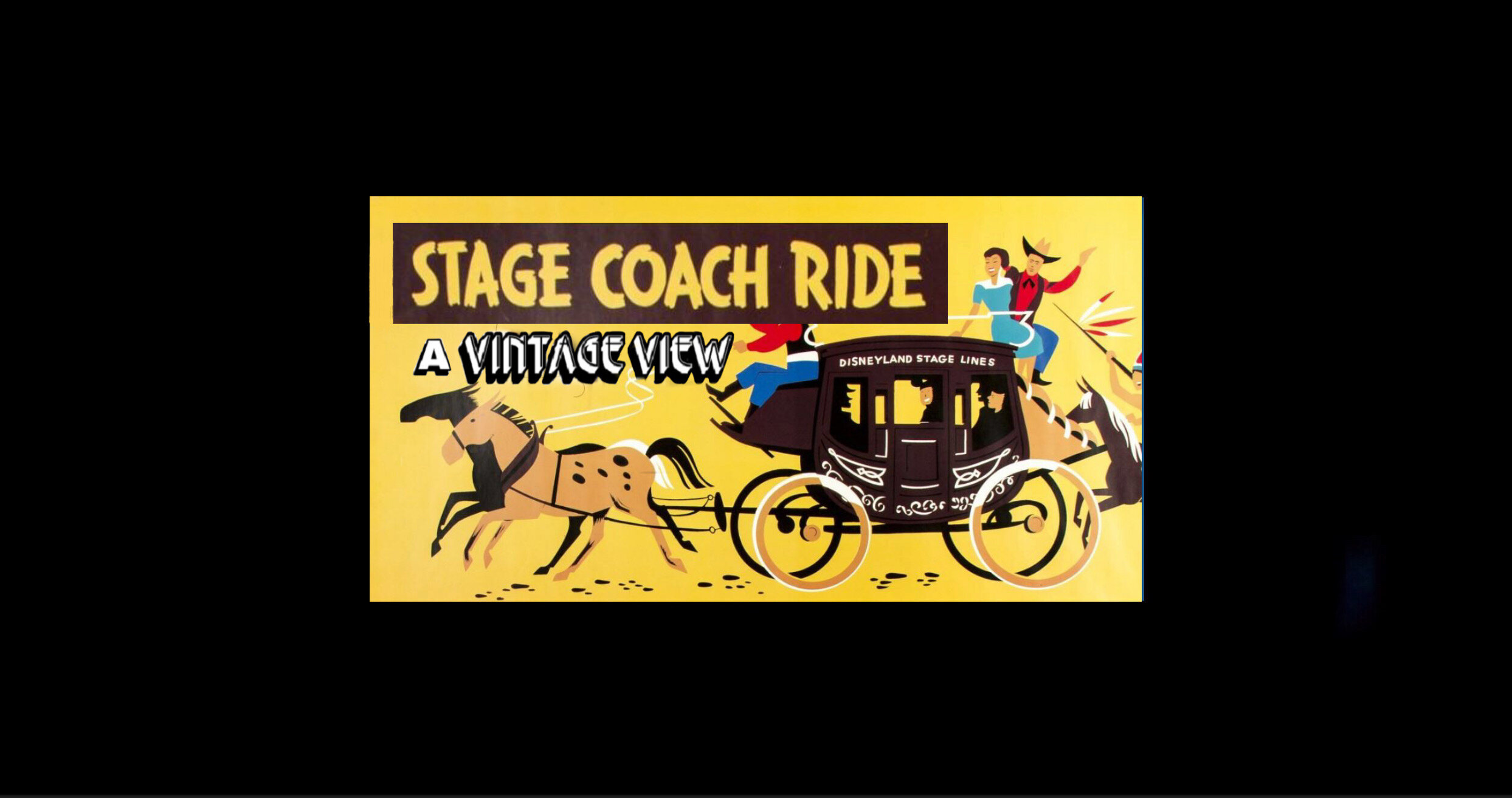RAINBOW MOUNTAIN STAGECOACH RIDE (and CONESTOGA WAGONS)

Disneyland Stage Lines Stage Coaches (July 18, 1955 - February, 1956)
At Disneyland there is a "story behind the story" of every attraction, every attraction is a living experience for the guest. Disneyland ride-through attractions or adventures have officially been defined as an “individual show, ride, or exhibit designed to produce an entertaining Guest experience. Disney attractions stir the imagination, enliven the senses, and provide the participants with positive, innovative entertainment, which is the essence of the DISNEYLAND Show.” It is important to review the story of the attraction, tell the story, explain it, and create interest. This is the story of Rainbow Mountain Stagecoaches.
“Horse-Drawn Coaches and Frontier America”
Since the early 1700s, coaches have transported Americans from place to place. In 1791, even George Washington toured 1,900 miles of the colonies in his White Coach. Before long, there were the (occasionally covered) stage wagons, or “mud wagons,” used for passengers and freight. The heavy Brewster Coach could transport many more passengers inside and atop.
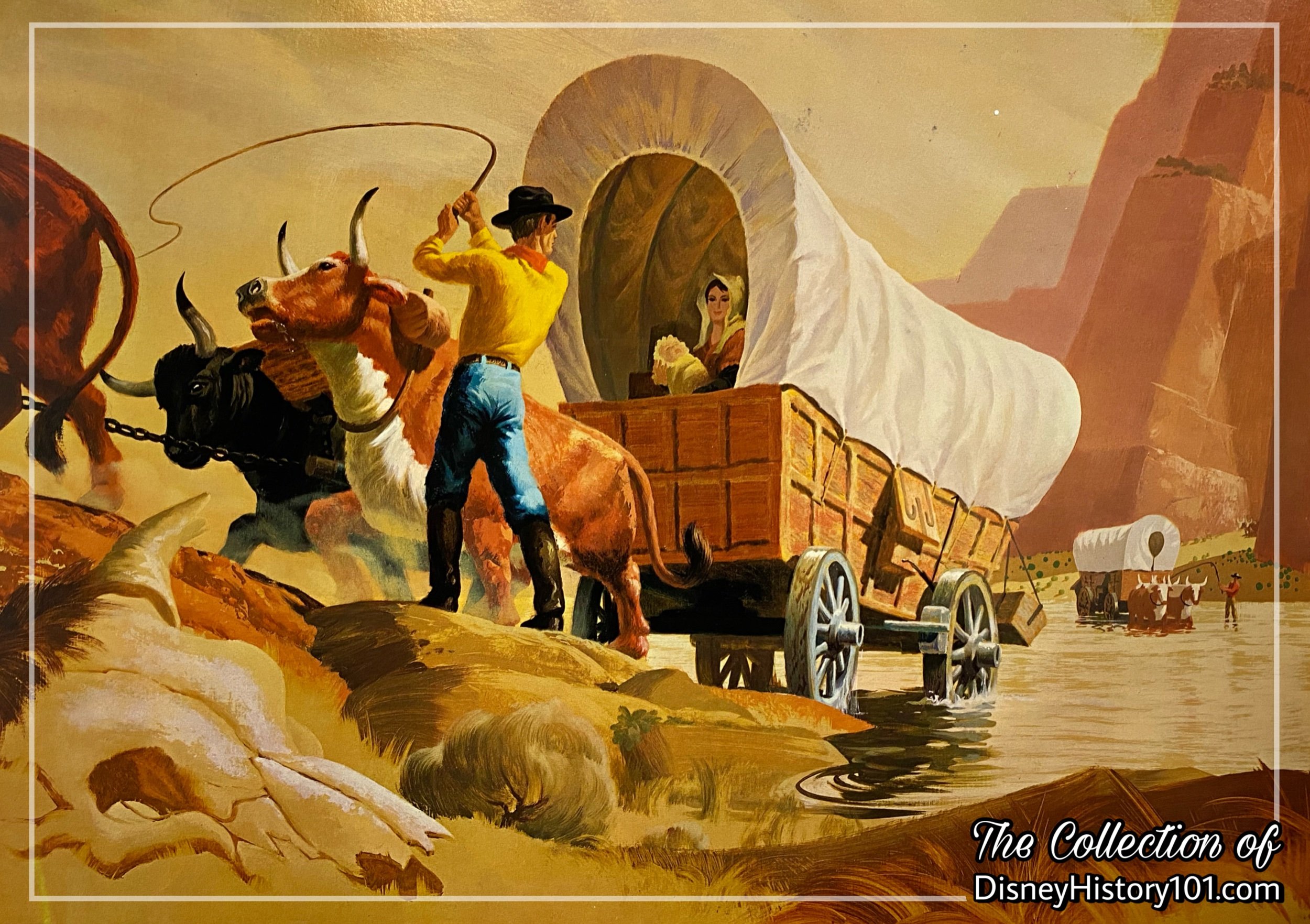
Conestoga wagons appeared in Walt Disney Educational Media Company Print “F” from Set 200 - “Early American Transportation.”e
Soon, Conestoga, Pennsylvania gave birth to the Conestoga wagon, used to transport folks West along the Oregon Trail and Santa Fe Trail. “Many Americans, with everything they owned piled high in the back of a covered wagon, headed out to explore and settle the wilderness.” The Conestoga wagon could be pulled by a four or six-horse (or even oxen) hitch. While it was not so comfortable, the driver often walked alongside the vehicle, the Conestoga wagon got the job done, moving goods and people West. Not long after, the town of Concord, New Hampshire gave birth to the Concord coach. While the Concord coach was generally pulled by a team of horses, it much more luxurious, typically outfitted with comfortable seats, and even leather straps which acted as shock absorbers against the rough terrain. Both vehicles become the standard of transportation for some time across America by the time Horace Greeley uttered those famous words - “go west.” As for the Concord, it outlasted the Conestoga, and was used to transport passengers, mail, a strong box, and a man riding “shotgun.” In fact, a Concord stage line began to operate from Missouri to California, and a concord stage made the first transcontinental trip. And before the railroad replaced the Concord coach, a form of the vehicle was even adapted as a railroad car.
While the horse-drawn methods of transportation became archaic an outdated with the advent of the motorcar, a passion for horseback riding and equestrian sports persisted into the new century.
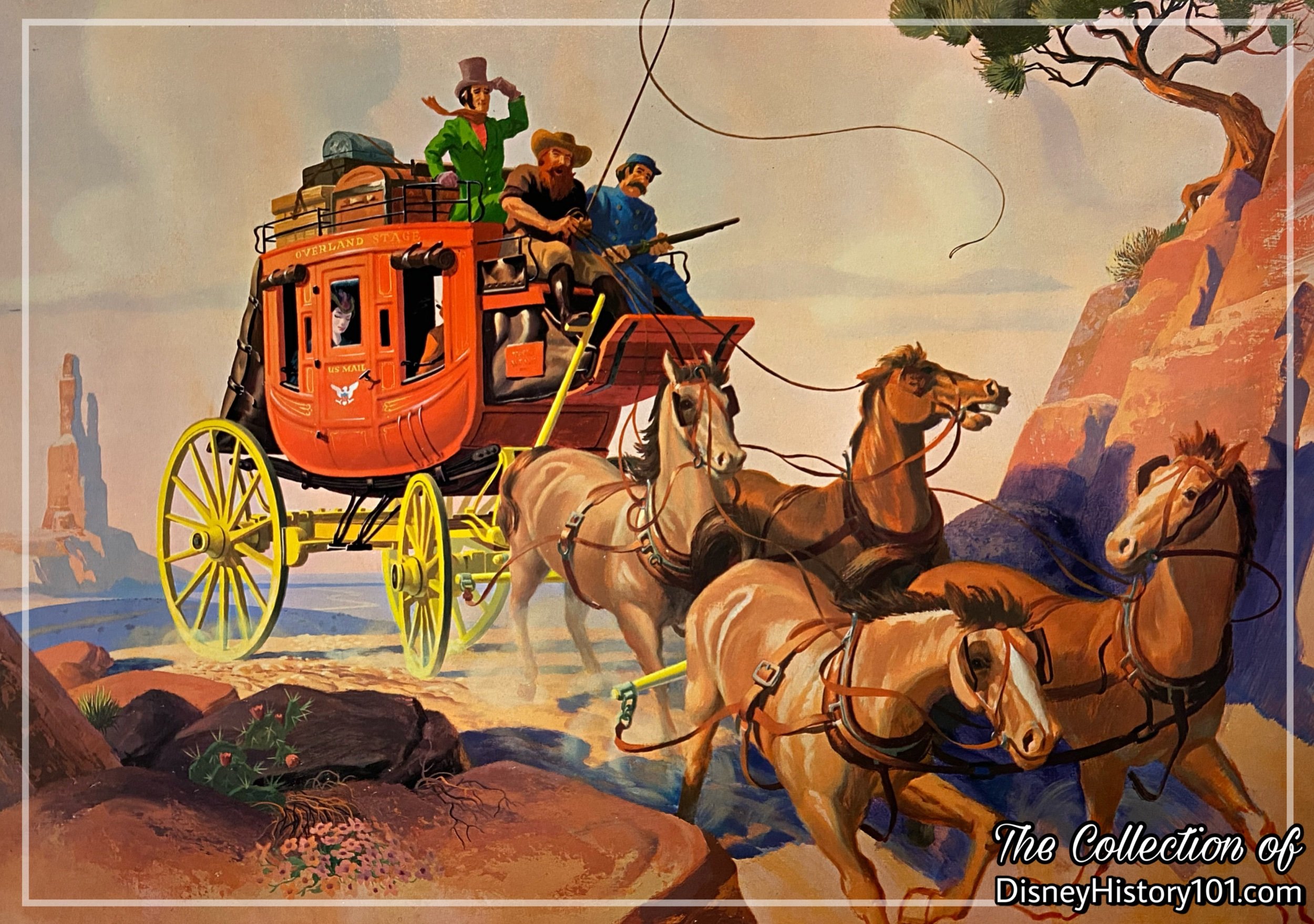
A stagecoach appeared in Walt Disney Educational Media Company Print “E” from Set 200 - “Early American Transportation.”
“Walt Disney & Horses”
Now it’s a fact that Walt Disney was one such person who had an affinity for horses! Beginning in 1932, Walt became an avid polo player with his very own Mickey Mouse Polo Team engaging at Uplifters and Riviera Fields. Walt even had a small stable of horses. Despite an untimely polo injury, Walt continued to ride horses along with the elite Ranchos Vistadores (a group of celebrities and prominent Californians who enjoyed equine), in the mountains of Santa Barbara just like true-life cowboys.
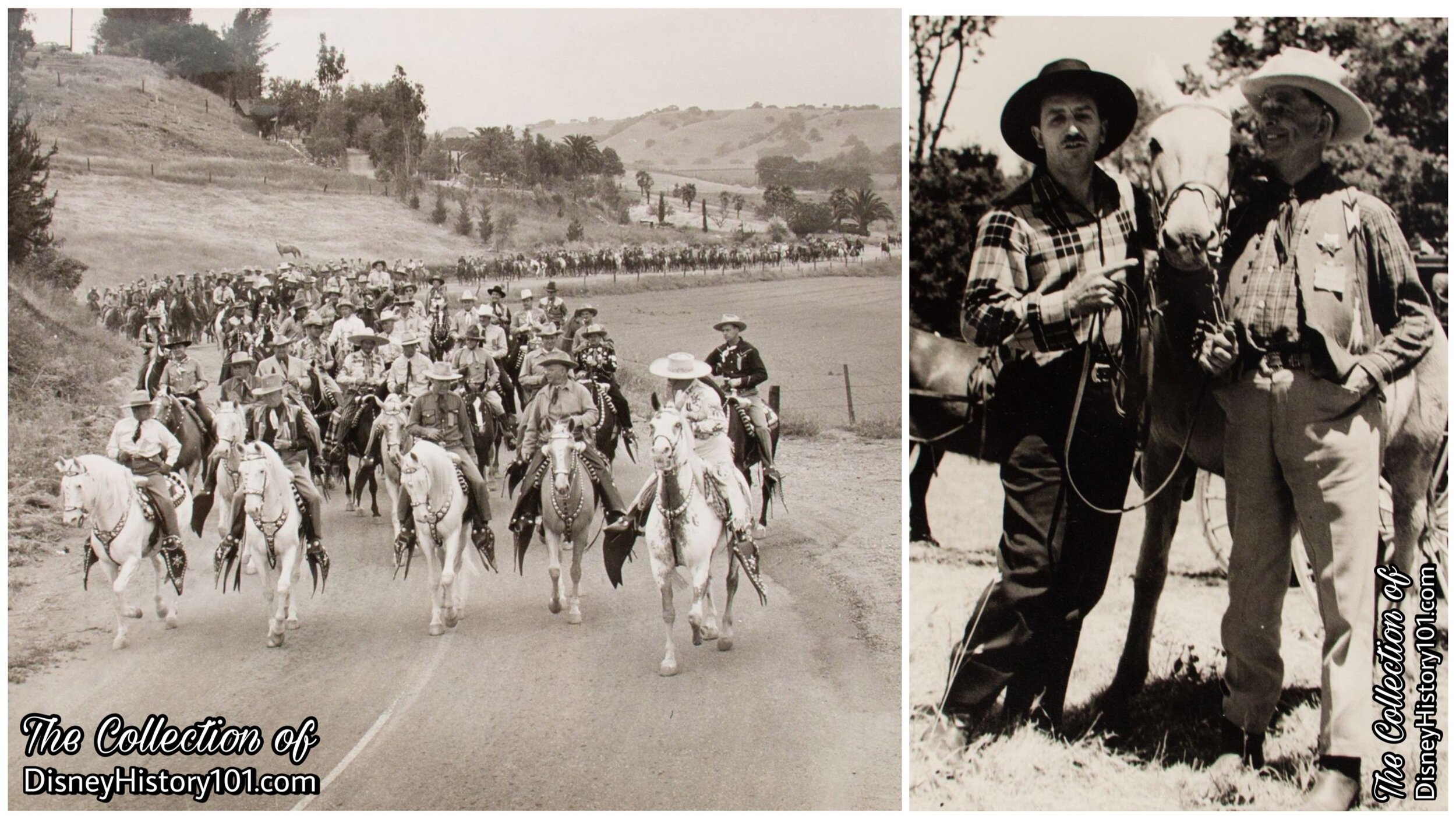
Walt and the Ranchos Vistadores
All the while, Walt Disney’s love for horses was evident as his studio produced a couple of live action films with equestrian-related themes a stars. Similar to Walt, Mickey Mouse acquired a couple of horse friends - Horace Horsecollar his plow horse appeared in early animated shorts and Tanglefoot appeared later in the comics. Many films featured horses, including Mickey’s Polo Team (released 1936), How To Ride a Horse starring Goofy (released 1941), Stormy the Thoroughbred Horse (released 1954) and The Littlest Outlaw (released 1955).
So, it wasn’t any surprise (to some Walt Disney Studio artists) when Walt began developing a few equestrian-related ride concepts among his earliest plans for a Mickey Mouse themed amusement park which first appeared on paper as far back as 1932.
“Blue Sky for Walt Disney’s Amusement Park Stagecoaches”
The Mickey Mouse Park Stage Coaches were perhaps the some of the earliest attraction vehicles to be both researched and developed. Yes, their earliest “stage” of development begins more than a decade later, on August 31, 1948, when Walt was dreaming about a Park (to be located across the street from the Studio in Burbank). Obviously, the fastest way to move people over the extended areas of Walt’s Park would be by utilizing moving vehicles. A memo was circulated among artists of the Walt Disney Studios, mentioning a “Horse-Drawn Carriage” attraction. It is clear that stage coaches were reckoned to be a part of the drawings and other plans for “Mickey Mouse Park” on an 11-acre plot of land (to be located near Griffith Park, in Burbank, California).

"Mickey Mouse Park" Illustration Excerpt by Harper Goff, 1951
The excerpt (pictured above) is from an early artist’s rendering of the aforementioned “Mickey Mouse Park.” By the time that the project’s name was changed to Disneyland, the attraction’s story had begun to develop much further beyond what you see here, but the coaches were retained and featured on plot plans like “Disneyland Preliminary Scheme #1”.
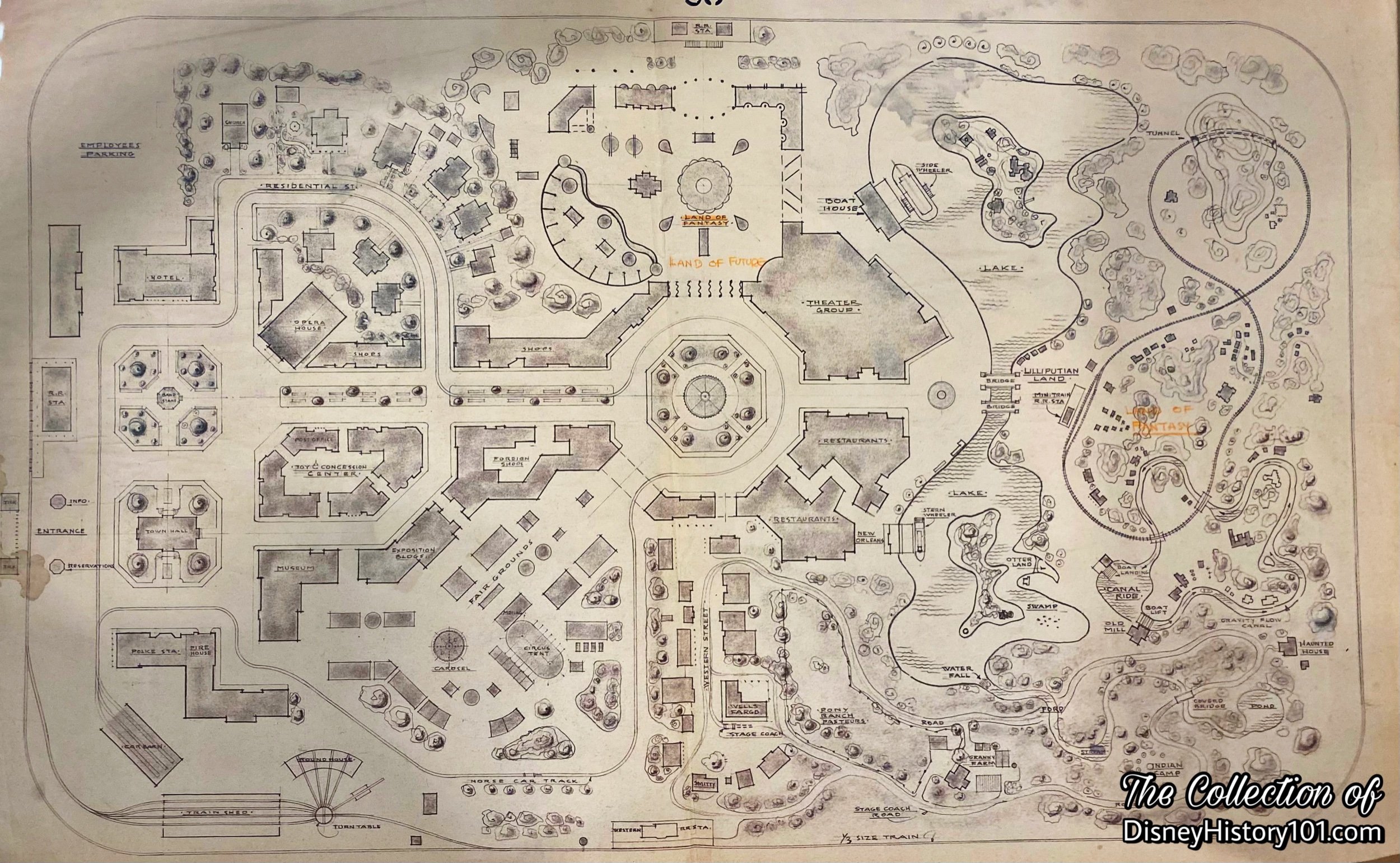
“Disneyland Preliminary Scheme #1”
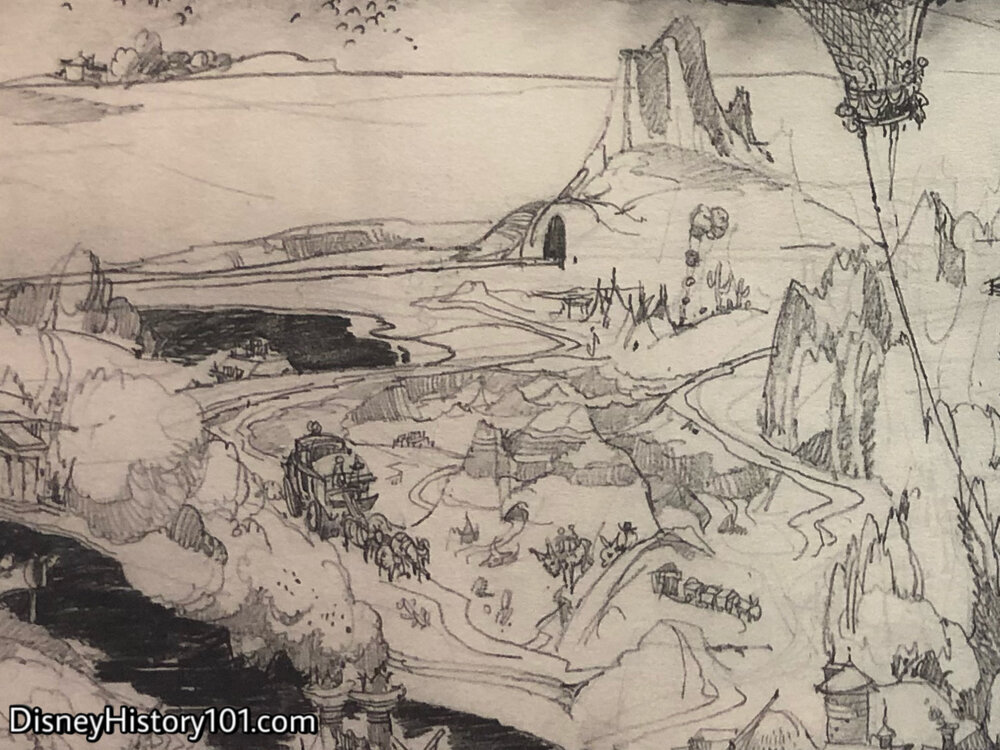
Herb Ryman “Aerial Over Disneyland” Concept Drawing, originally produced September 26 & 27, 1953.
“Designing & Selling Disneyland”
While many artists contributed, the talented Herbert Ryman is of note. Herb had joined the Disney Studio in 1938, after Walt saw a public show of his work in New York. (Herb's paintings were being exhibited with those of another up and coming artist, Andrew Wyeth.) Herb Ryman acted as art director for such films as Fantasia and Dumbo, but had left Walt Disney Studios in 1946 and (by 1953) was employed by 20th Century Fox. Walt reached out to Herb and during one weekend (September 26 & 27, 1953) the first “Schematic Aerial View” over Disneyland originally produced!
After new economic research reports had recommended a final resting place for Walt Disney’s Disneyland, artist Herb Ryman had hand-inked, one of the original Disneyland concept drawings - “Aerial Schematic View” over Disneyland - between September 26th and 27th, 1953. Subsequently, his original drawing was copied, and hundreds of resultant drawings were made (some of them hand-colored), based on the original (with constant modifications being made, as Walt Disney’s “Disneyland” developed). An excerpt from one is pictured above, with the stagecoaches and wilderness trails clearly part of the plans (Marvin Aubrey Davis’ Plot Plan even labeled “Canastoga Road” and “Stage Coach Rd.,” implying separate trails for the vehicles). By this time, some of the vehicles of this attraction were briefly referred to as “Yellowstone Stagecoaches.”
But, what scenery lay in store for passengers of the Stage Coaches? It seems that many elements of drawings produced for the 11-acre Burbank plot were retained. Proving this is an early form of (what would come go be known as) the “Disneyland Prospectus” [prepared in 1953 for Disneyland Inc. by WED Enterprises], which reads : “Frontier Country….where the Stagecoach meets the TRAIN and the RIVERBOAT for its trip down the river to New Orleans…Ride shotgun on the STAGE COACHES…past GRANNY’S FARM, a practical working farm operated with real live miniature horses, cows, oxen, and donkeys…through the pine forest, fording streams into Indian country and through the Painted Desert.”
“The Painted Desert” (the name used to identify this region during 1955), appeared on the “Proposed Diagramatic Layout of Disneyland” (Marvin A. Davis’ plot plan, produced for WED Enterprises, by September 12, 1953) that was shown to potential investors as early as 1953. According to “Disneyland” (prepared for Disneyland Inc. by WED Enterprises, 1953), “Ride shotgun Stage Coaches…past Granny’s Farm, a practical working farm operated with real live miniature horses, cows, oxen, and donkeys…through the pine forest, fording streams into Indian country and through the Painted Desert.” However, it seems (as depicted in the drawings) that it was only meant to be traversed and explored by way of a Stagecoach or Mule Train. The “The Disneyland Story” describes the scenery of the “Painted Desert” this way : “As you go into the Painted Desert you will pass the Indian encampment, go through a Pine Forest, and Ford a stream. When you get to the Painted Desert you will see the things you usually find there, such as the beautiful cactus plants, trees, probably the water hole with the ‘poison sign’, the skeleton of a steer, and other appropriate dressings of the desert. As well as the stage coach ride, you will be able to take the Conestoga Wagon and Mule Pack ride into the Painted Desert.” Later, another early document describing Walt Disney’s Disneyland included that of a “Stage Coach Ride.” So it seems (at least for a brief period), that the Conestoga Wagon (and not a Mine Train or Stage Coaches) were considered as options to explore the highroads and byroads of the Painted Desert in Frontierland.
On December 3, 1953, Walt wrote his sister Ruth Beecher: “Our DISNEYLAND project is getting nearer an actuality all the time and I'm anxiously awaiting the time when it does get under way. In the meantime we are gathering up all sorts of things for our exhibits. We have… about thirty miniature ponies that we keep out on the back end of the studio lot, with most of the mares in foal. Then there are three stage coaches that we made here at the studio - they're real beauties, painted in bright red, with gold trimmings. We're all very excited about this project and feel It will be a wonderful thing for everybody.”
Meanwhile, viable project Concepts (as seen above) featuring stage coaches, were supported by a well-developed business case and built expectation. These were carried to potential investors back East. Frank Pfannenstiel recalled how Walt was preparing to ride one of his horses when he received important news: “I was getting Walt's horse saddled, when Roy came over and put an arm around Walt, saying, ‘I’ve got the money, let's go to work.”
By September 16, 1954, Walt excitedly wrote to his sister Ruth Beecher in Portland, Oregon, briefly describing Frontierland and its stage coaches and “prairie schooners” (another term for Conestoga wagons): “We are very busy here at the studio, what with the television program and getting our DISNEYLAND Park under way, we’re knee-deep in work. The Park is scheduled to open in July of next year. It will be a miniature world’s fair idea. There will be trains, river boats, prairie schooners, fantastic rides, etc., etc… FRONTIERLAND… will be of the gold rush period, with Indians, Buffalo, Stage Coaches, etc.”
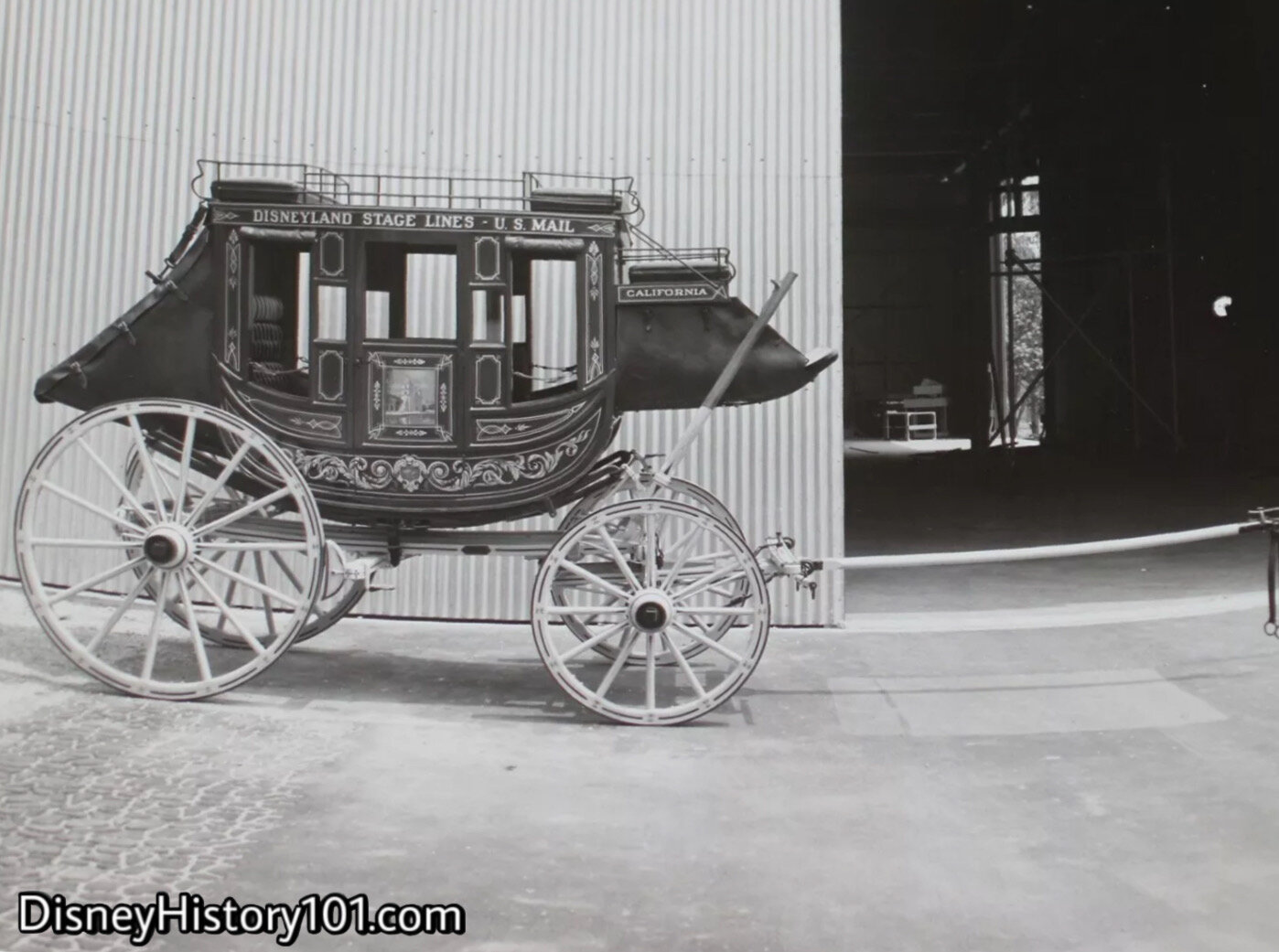
Owen Pope's Disneyland Stage Lines "Concord" Stage Coach, 1955
So while alternative modes of desert transportation were “on the drawing table,” the Disneyland Stage Lines Stage Coaches were perhaps the earliest of Disneyland’s attraction vehicles to be researched and developed. As aforementioned, their story actually begins in 1950, when Walt was toying with the idea of a “Mickey Mouse Park.” About this time (in 1951), a couple by the name of Owen and Dollie Pope (who had previously manufactured horse trailers in Fort Worth, Texas) was running an equestrian show at the Pan Pacific Auditorium (in Sacramento, California), and Disneyland production artist Harper Goff attended. Harper recommended their show to Walt, who was subsequently so impressed with the showmanship and their ponies that he arranged a meeting with the couple during the spring of 1951. The idea was to get their assistance with “putting together some livestock for his future park.” After some negotiation and throught, the Popes (Owen and Dolly) were ultimately persuaded by Walt Disney, under the offer that he give him room and board. So Owen and his wife Dolly were hired by Walt Disney. This happened on the Sunday after Thanksgiving in November of 1951 - four years before Disneyland opened its gate to the public.
It is important to note that the “Proposed Diagramatic Layout of Disneyland” (Marvin A. Davis’ plot plan, produced for WED Enterprises, by September 12, 1953) mentions three equestrian rides in “Frontier land” : (1) a “Pack Mule Ride”, (2) a “Stage Coach Road” for Stage Coaches, and (3) a “Pony Ride” next to a “Corral.” All of these massive projects necessitated Owen and Dollie living on the Walt Disney Studio Lot for the duration of their development. Both Owen and Dollie supervised the fabrication and built the original four (what would become to be known as) the Disneyland Stage Lines Stage Coaches during 1954. The three “80 percent” scaled-down stage coaches (named after the states of California, Arizona, and Colorado), were designed and developed to be drawn by a “six pony hitch” of a miniature breed of midget horses, ponies, and Sardinian Donkeys.
“Breeding and Training Stock”
Now it has been said that “a cowboy needs a horse.” To meet this need, Owen and Dollie also oversaw the breeding, care, and training of these animals, most of which were intended for “Frontier Land, which is Disney’s favorite section of the fair,” according to Loius Berg (Reporter for “This Week Magazine”)! Louis Berg had the privilege to tour the Walt Disney Studio “stud farm” late in 1954, when he divulged : “I visited the stud farm where the midget horses, ponies, and Sardinian donkeys that will draw the wagons, carts and surreys are being nursed. And it’s a sight in this world to watch the tiny foals nuzzling up to mothers themselves no bigger than a normal foal. Disney knows every colt and every pony by name, and can tell you the characteristics of each of the several hundred animals : one likes to chew on cigarettes, another is a brat. ‘Get away, General,’ he said to a young colt that was biting his trouser leg affectionately.” While many of the other 5/8-scale ponies would become known to Park visitors at the time of their big debut to the public during Disneyland’s Opening day Parade, one (often famously seen pictured with Walt Disney) was born at the studio. “‘We call him ‘General George’ because he was born on George Washington’s birthday,’ Disney explained,” to Louis Berg. Herb Ryman [in “Work With Walt” by Don Peri] recalled how Walt “loved the the little animals - the little horses, ponies, and mules.” You may have seen a few images of Walt welcoming the new arrivals - foals, colts and fillies born at the studio during this era. As a sidelight, Walt even rode horse in one of Disneyland’s parades alongside Davy Crockett. Columnist Louis Berg continues : “Incidentally the pony corral is the favorite of Disney employees and their children. Most constant visitor is ‘Bunky’ Thompson, receptionist, who spends lunch hours feeding the animals.”
An insert which accompanied area newspapers mentioned how “Disneyland stables were turned into a nursery tem-porarily, with nine mares expecting the stork before Disneyland's opening day, and five colts having arrived after the move to Anaheim from the Burbank stables. More than 200 ponies are working in the park.”
In addition to feeding, the equine were trained. Van Arsdale France once wrote: “He [that is, Owen] was worried about the horses ‘spooking’ with all the sights and sounds of Disneyland. So, a recording of sounds from arcades and shooting galleries, and yelling kids made up. This was used as an audio aid for horse training. Since the horses were not directly on the payroll, they had to be carried as assets. All were given names. They all received names of people in accounting. Lucy Cotton, for example had a mule on the records named, ‘Lucy Mule.’”
Concord Stage Coaches were not commonplace in the typical society of 1951. After “Museum authorities devoted their knowledge and skill to the accurate reproduction Conestoga wagons, Concord stages, [and] Western Buckboards,” it was deemed a requirement that certain arts and crafts were resurrected in order to fabricate the hubs, wheels, thoroughbraces, and other parts. One of the main crafts that was revived, was that of the wheelwright - the art of making wheels like the pioneers of frontier America! Studio Craftsmen had to heat the metal rim to the exact temperature, then fit and cool it, without scorching the wood. “Because of the great number of guests carried, the wheels are more sturdy than those on most of the catalogue models - another safety factor built into the attraction”, states one Disneyland Operation Manual. As a final touch, small details like the pin-striping on the wheels and stenciled letters were completed on the Walt Disney Studio backlot, by sign painters. According to Park historians : “One of the artists working on the coaches took issue with Walt about all those details. ‘People aren’t going to get this. It’s too much perfection,’ the artist said. With his disapproving eyebrow raised, Walt responded, ‘‘Yes they will. They will feel good about it. And they will understand it’s all done for them.’”
“In 1954, Day Sechler [sic] went to the STUDIO, where he helped Owen Pope make street cars, surreys, stage coaches and even a fire engine.”
Charley Brock recalled: “I had an older brother who was helping to build Disneyland and the Mark Twain. One day he came to see me and said that there was goin' to be a lot of horses at Disneyland. He told me to put on a clean shirt and overalls, and come with him. I saw Owen Pope and started workin' in the barn, gettin' horses and stage coaches ready.”
It is perhaps around this time that Walt Disney Studios animator Willie Ito (hired June 1954) recalled wandering onto the back lot and, in one of the workshops, seeing “large molds of the Dumbo ride, miniature trains, stagecoaches, huge blueprints on the walls, etc. It was teaming with activity.”
Walt was personally interested and involved in his Stagecoaches. About this time Louis Berg (of This Week Magazine published for September 19, 1954) wrote: “And into this dreamland, Disney has already escaped. If you want to see him nowadays, don't look for him in his office. Seek him out in the workshops. Like as not, he'll be polishing a wagon tongue for one of the stage coaches… In the carpenter shop, Owen Pope one of the last great wagon builders, was putting the finishing touches on a stagecoach - there will he four of them - scaled down 80 per cent from the Deadwood model.”
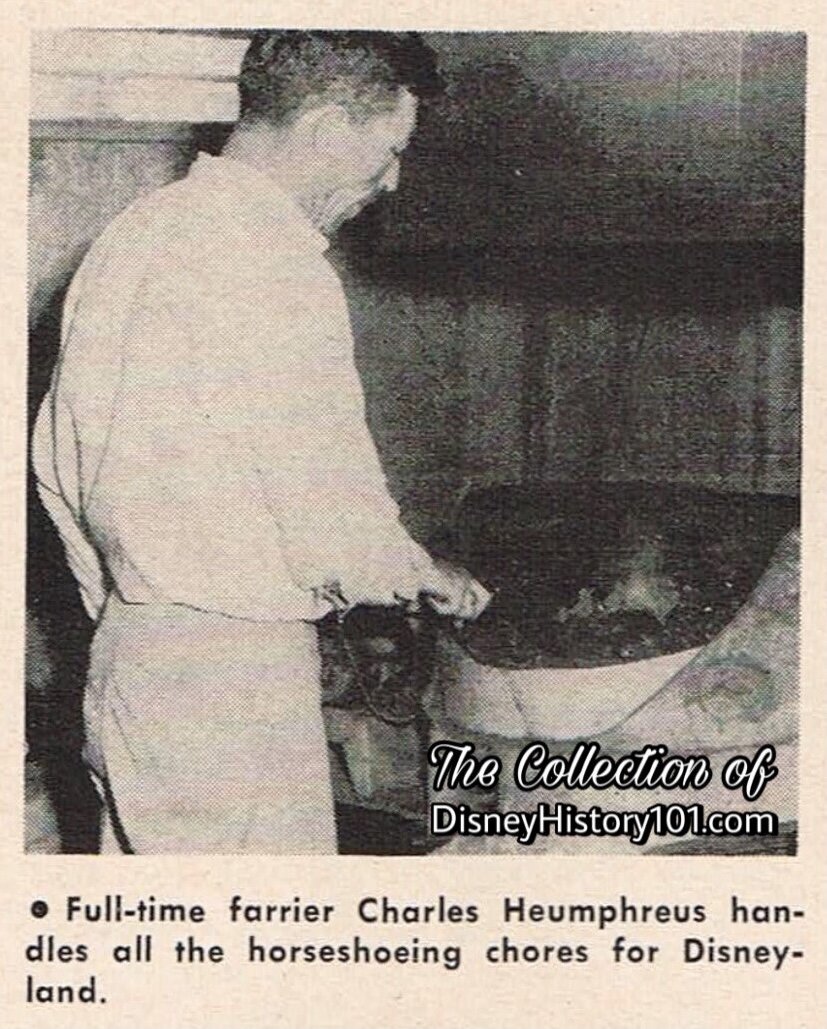
The rarely-seen Blacksmith Shop was divulged in Western Horseman, (September, 1957)
The horseshoes of the hoof-branded Belgians, Clydesdales, Percheron, and Shire-Percheron cross-breeds were made of rubber (to generate the “clip-clop” sound on Main Street). However, the horseshoes of the Frontierland equine (mules, Sardinian donkeys, midget horses and ponies) that travelled through unpaved areas were made of iron metal, the old fashioned way.
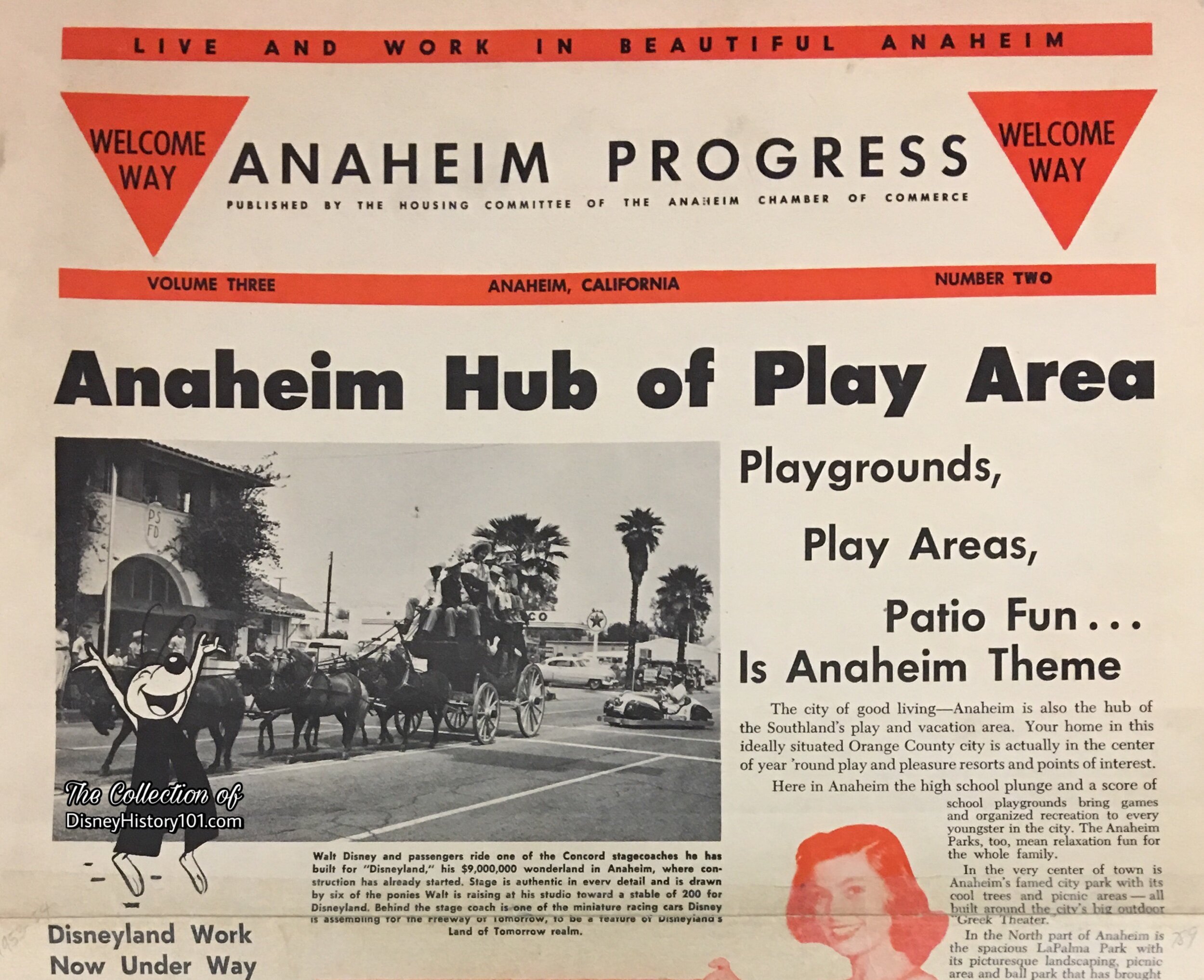
“Anaheim Progress” Publication (Vol.3, No.2) Features A Photo of Walt and a Concord Stagecoach with a six-horse hitch in Palm Springs
When at least one of the scaled-down Disneyland Stage Lines Stage Coaches was complete, Walt was so proud of it! Louis Berg (“This Week Magazine” Reporter), noted (by September of 1954) that “one of these coaches is already finished, and when Disney is in good humor, he’ll drive visitors in it though his grounds, handling the reins like Deadwood Dick.” Walt invited almost everyone to step aboard his new Stage Coach. The six-and-a-half-foot-tall Claude Coats recalled “Walt and a driver were giving rides around the lot, but he wouldn’t let me get in. He said I spoiled the scale.” Walt even took one completed Stage Coach down to the location of his former vacation home and “laughing place” in Palm Springs, for the Desert Circus (an annual springtime Palm Springs parade and community event). This was (of course) great pre-opening day Disneyland promotion, and resulted in Walt acquiring a few sponsors (through his former neighbors at Charlie Doyle’s Smoke Tree Ranch).
Now, by the time Disneyland was in development, Stage Coaches were not unheard of by area residents of Orange County. After all, Walter Knott had his Butterfield Stagecoaches and his Overland Southern Coaches running through Wild West routes of his own Knotts Berry Farm! So, part of what would set Walt’s stagecoaches apart would be their setting - the aforementioned “pine forest, fording streams into Indian country and through the Painted Desert.”
By July 1, 1954, George Whitney of Disneyland, Inc. directed Amusements, with Ron Miller overseeing analysis, philosophy, capacities, planning, operator training, and amusement procurement.
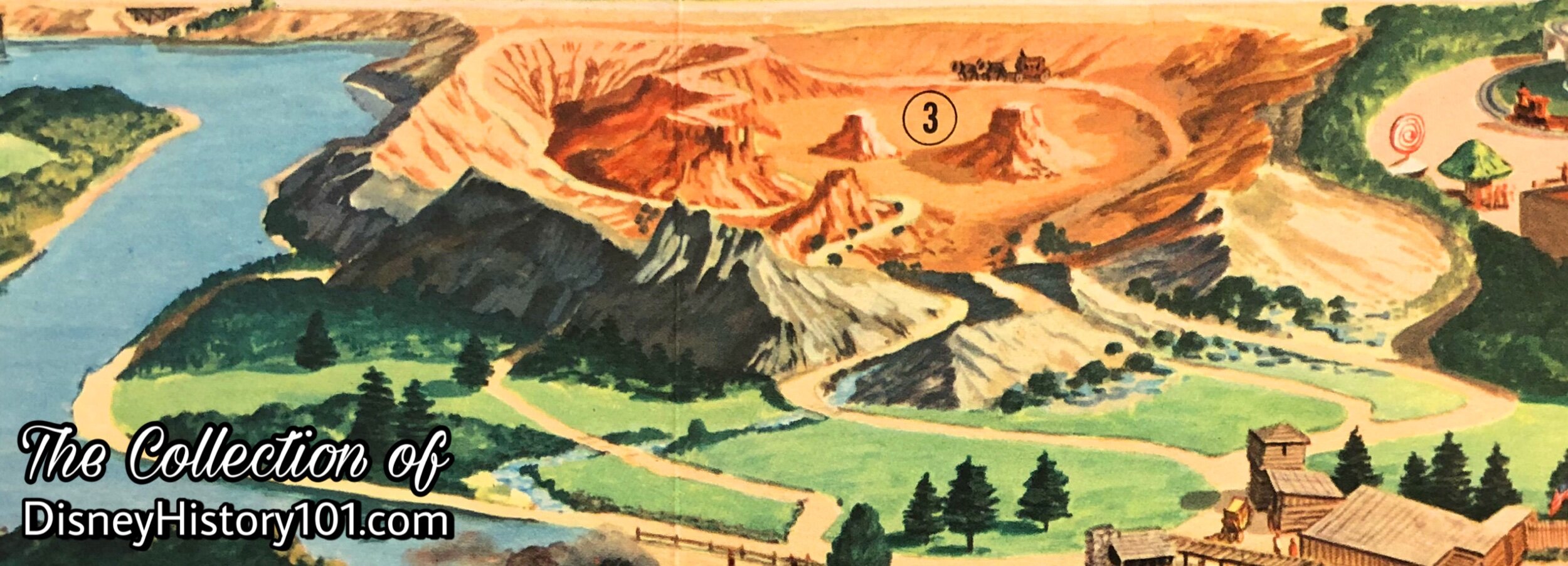
DISNEYLAND MUSICAL MAP by MATTEL EXCERPT, (1955)
“Stagecoach Roads Construction and Landscaping”
Fortunately, Disneyland was constructed with enough space for the expansive area that would become Frontierland. As to the “greenscape,” it began to take form when Bill Evans helped save a number of orange trees along the route of the Conestoga Wagons, according to “Creating the Disney Landscape - An Interview with Bill Evans,” published in The “E” Ticket, Spring 1966. Walt continued to oversee the progress of the other Stage Coaches, according to Look Magazine (November of 1954). “As construction progresses on the Park, no detail is too picayune for Walt Disney’s attention. He bobs in and out of the workshops almost every day to check on the accuracy of the scaled- down stage coaches.” Walt also drive a jeep (at least on one occasion, as it “bounced over a stagecoach trail which will lead through the Painted Desert and along a river,” (according to one construction-era Bob Thomas article). Meanwhile, the finishing “natural” touches were being added to Disneyland’s own true-life desert, in Anaheim, California. Even before Disneyland opened, Walt’s friend (and Hollywood columnist) Hedda Hopper divulged, “Had a sneak preview of Disneyland…It was the planting that awed me. Walt bought $400,000 worth of trees and shrubs ; he depleted our nurseries and is now importing trees from Santa Barbara and San Diego. Cactus from Arizona already dots Disney’s painted desert”. [“Disneyland Park Found as Fantastic as Its Creator”, Published in “Looking at Hollywood”, May 22, 1955]. As for the outcome, the author of “Disneyland World of Flowers” reminisced about the greenscape: “If you were an early visitor to Disneyland you will recall a stage coach and Conestoga wagon ride that departed from this same area and carried the traveler through pine-covered country, a sun-baked desert, and back along the tree-lined river shore.”
All of this work was performed by the team of Jack and Bill Evans, under the direction of female architect and landscaper Ruth Shellhorn (to whom much of the Park’s original plant and tree selection is credited). This early piece of artwork (pictured above) was included inside the Disneyland Musical Map by Mattel - a mail-away preview of Walt Disney’s Disneyland, and perhaps one of the first pieces of licensed Disneyland merchandise. Those who purchased this c. 1954-1955 Disneyland promotional item could view the many roads (fit for wagons) coursing through the hills and desert of Frontierland’s Painted Desert!
As of June 2, 1955, C.V. Wood Jr. sent an Inter-Office Memorandum to Walt Disney regarding the best estimates that could be obtained at the time regarding the completion status of individual sections of the Park and Opening Day. C.V. wrote: “Wagon Rides: Okay. We still need design decision regarding some of the things you will see on the ride.”
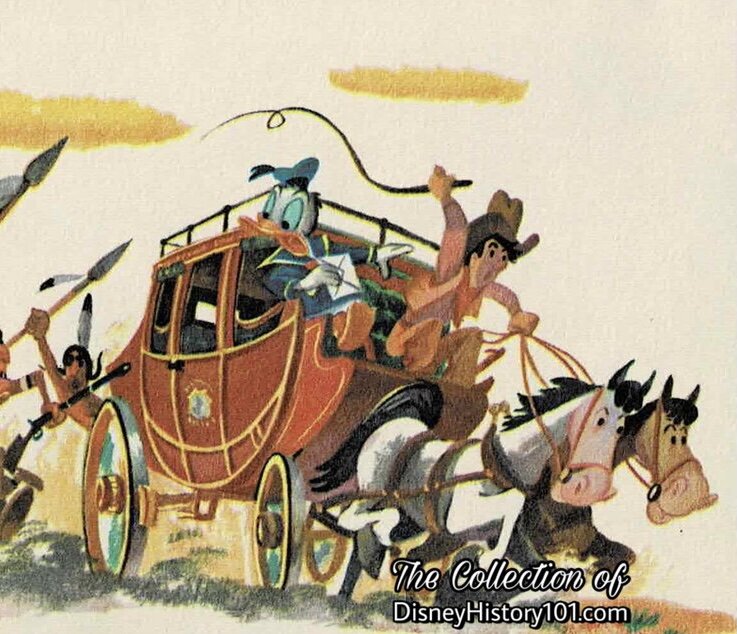
"Donald Duck Goes To Disneyland" by Whitman Publishing, (1955)
Though the conestoga stage coach looks different from Owen Pope’s final products, contemporaneous licensed Disneyland merchandise tantalized future guests, by granting these potential visitors a preview of Disneyland adventures.

Huey and Louie aboard a atagecoach in “Donald Duck in Disneyland,” Artwork by Campbell Grant, published 1955
Soon one authorized “Disneyland Information & Nomenclature List” (prepared by Bill Cottrell of Disneyland Inc., by May 25, 1955) divulged the details of “Disneyland Stage Lines” to Disneyland, Inc. employees. The three Coaches (California, Colorado, and Arizona) were to have a “4 horse hitch per stagecoach,” while the related Conestoga Wagons attraction consisted of “2 wagons” with a “6 mule hitch per each wagon.” In addition to these, the same documents mentioned “other wagon rides” which included the “Disneyland Transportation Company” or “Yellowstone Coaches,” - “3 Coaches - 4 horses per. each Coach.” There were also to be “3 Surreys - 1 horse per Surrey, 1 Buggy - 1 horse hitch, 3 wagons - 2 horses per wagon, and [sic] 4 Wagons - 2 horses per wagons.”
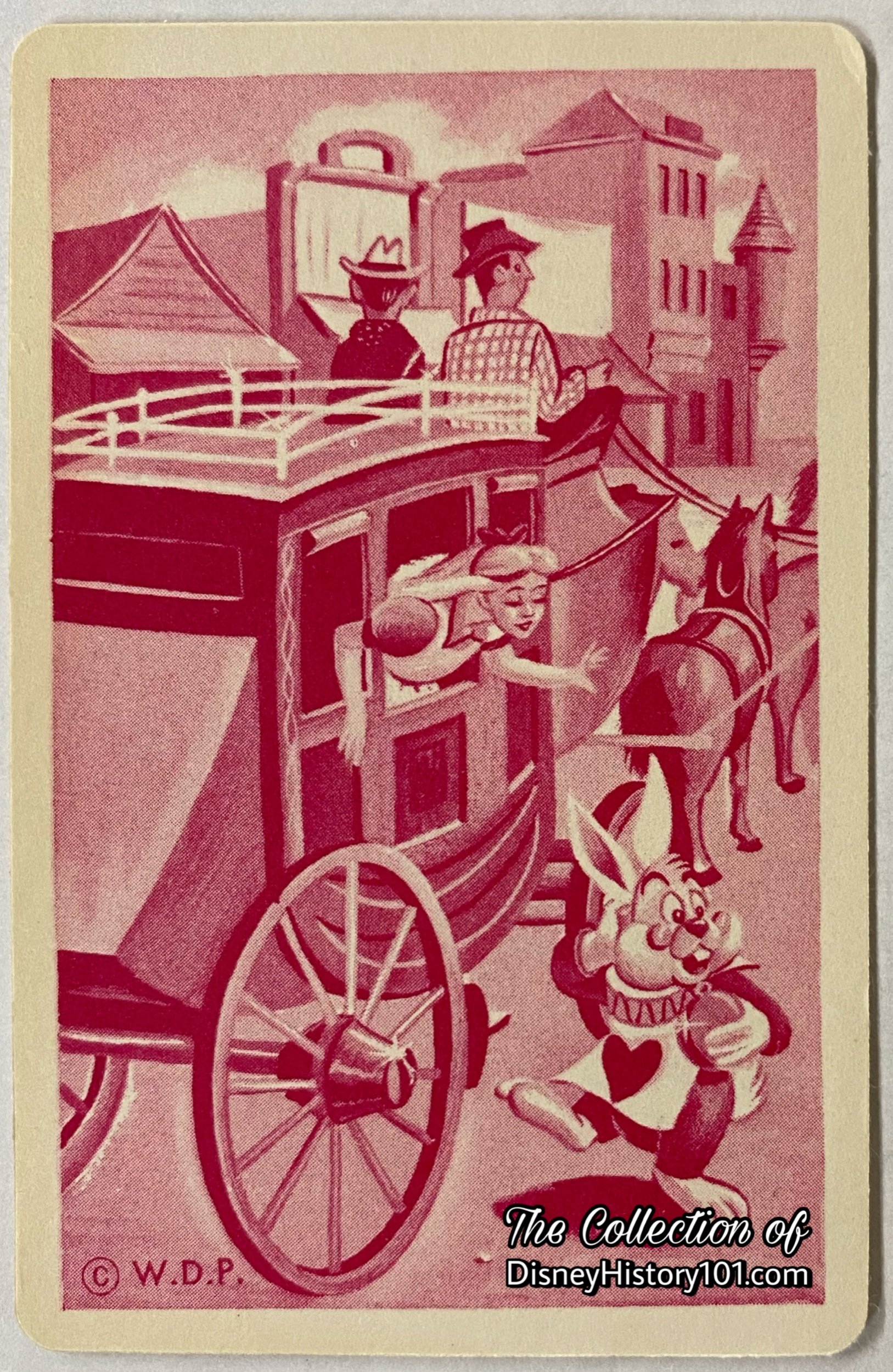
A collectable card from the Disneyland Fun Box by Whitman, c.1955.
"She's late, she's late!" exclaimed the White Rabbit checking his big watch. "Don't you know the Queen's never on time!" explained Alice. "Let's take our ride across Disneyland's Painted Desert without her. "Oh me, oh my!" replied the Rabbit. "I was supposed to meet the Queen yesterday! I'm the one who's late!"
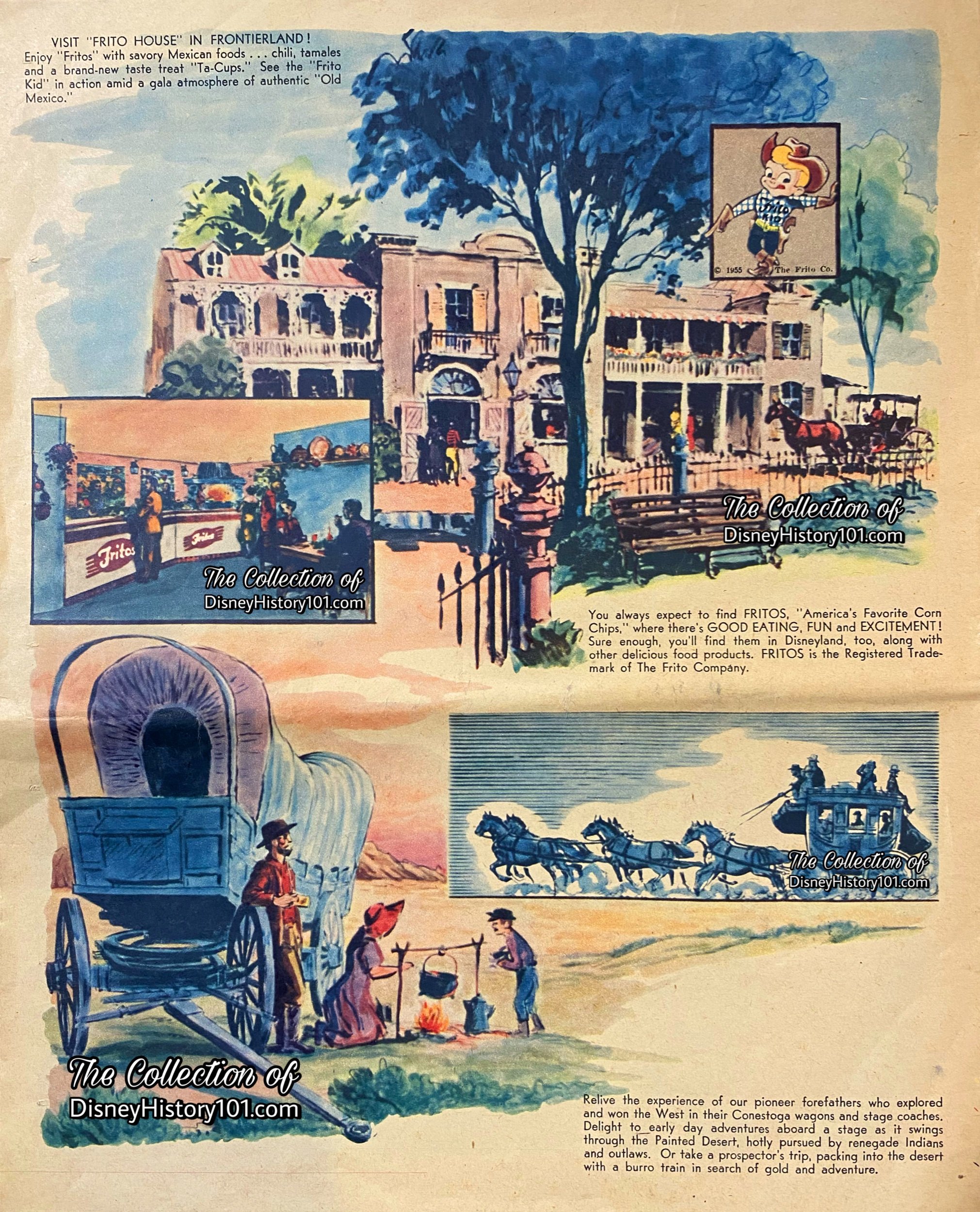
The Coaches and Wagons were previewed in the “Disneyland” Excerpt published June 15, 1955
Disneyland’s horse-drawn vehicles made the news in many publications even before they hit the Frontierland trails. Panorama magazine (published spring of 1955) mentioned that “Buckboards and Conestoga wagons carry visitors to a Wells Fargo station for a stage-coach trip through the Painted Desert.” The pre-opening “Go Santa Fe to DISNEY-LAND” brochure printed sometime between July 4 and July 18 mentioned Conestoga Wagons, Surreys, Buggies, Buckboards, and Disneyland Stage Lines (3 stages and a four horse hitch) among the rides to open.
Day Sechler recalled: “Trying to get ready for Opening Day, I worked a double shift from 7 A.M. until 11 P.M. from May through Jul 17. I was training co-ordinator and we were breaking green horses."
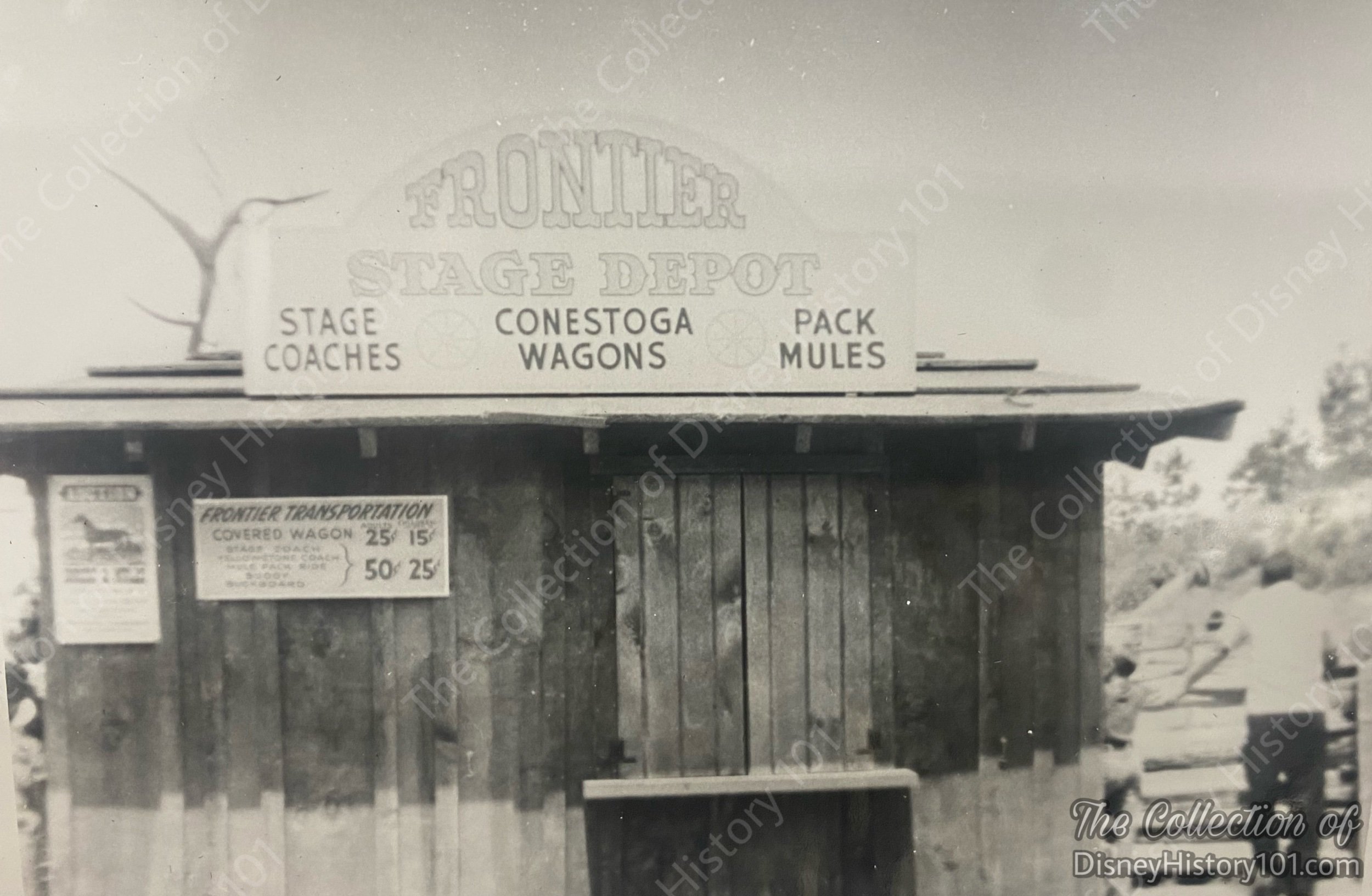
Finally, a thirteen-star flag was hoisted to the top of the Frontierland Stockade Flagpole, and the doors of the Frontierland Stockade were opened for a train of Frontierland “Conestoga Wagons, riders and all.” Now that Disneyland opened, “The Story of Disneyland” souvenirs advertised the Yellowstone Coach, Stage Coach Ride, Surrey Rides, Buggy Rides, and the Buckboard Ride.
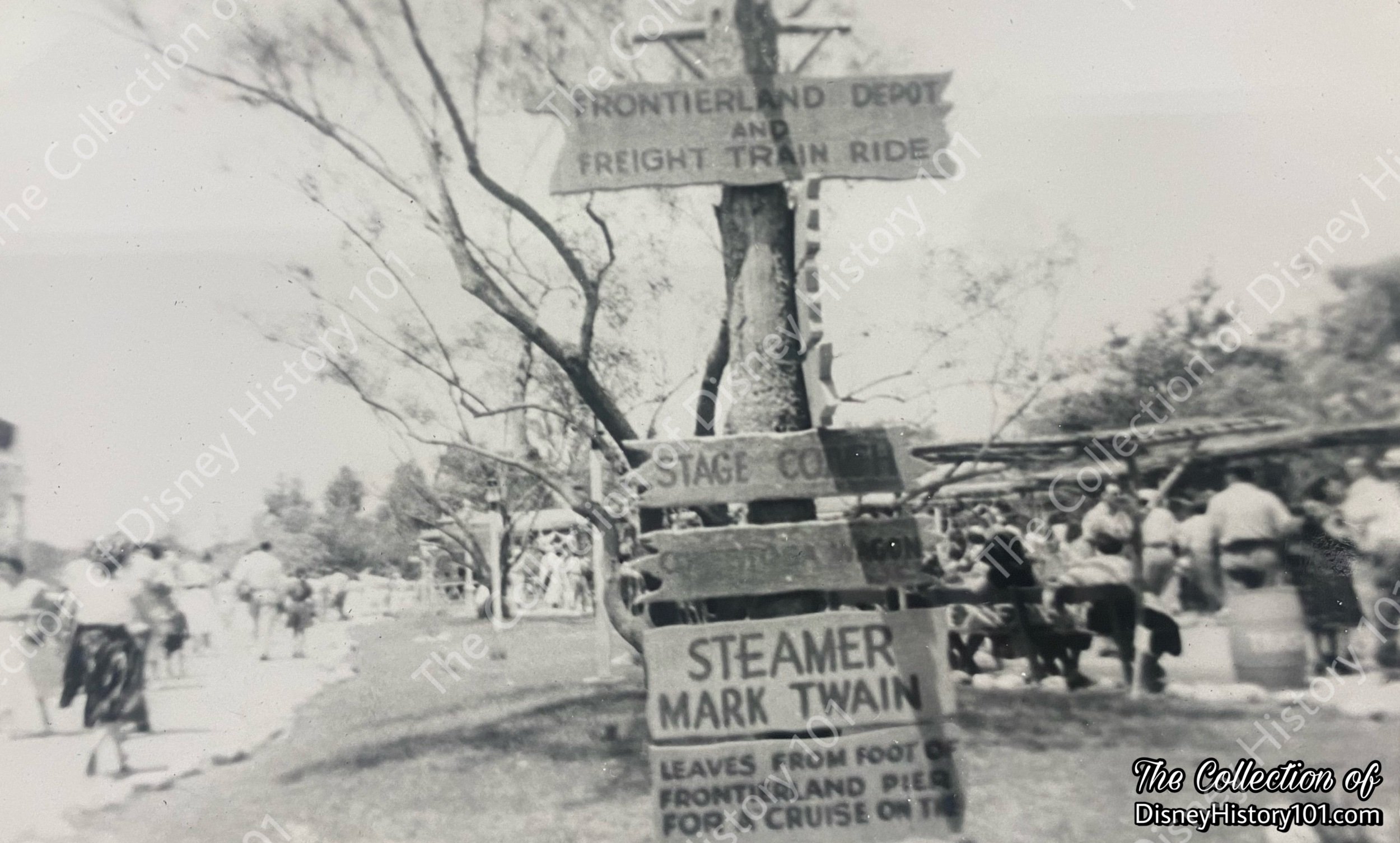
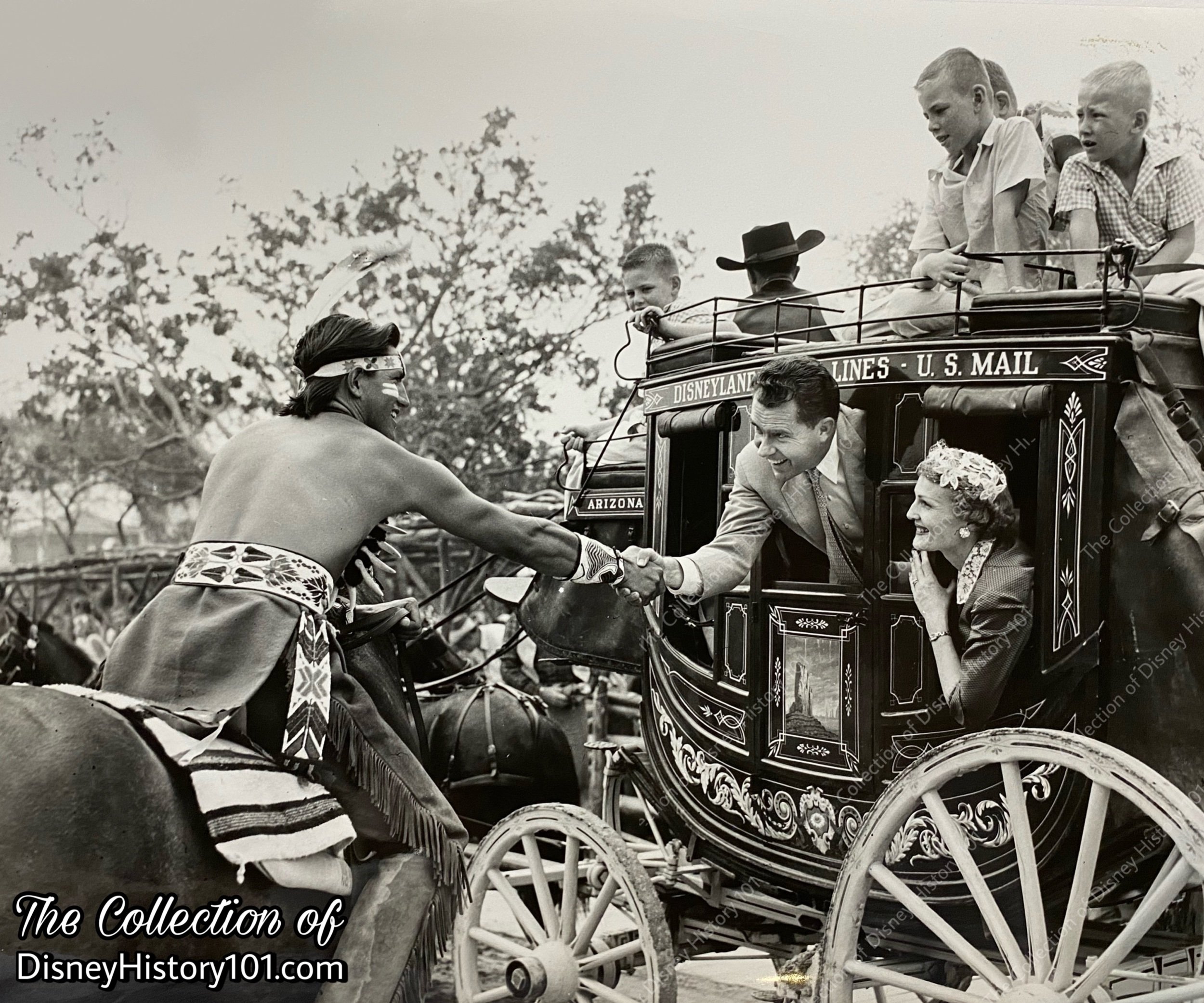
A press release photo depicts a Stagecoach carrying Richard Nixon & family; ©️Walt Disney Productions.
Once through the Frontierland Stockade, they headed off into (what Art Linkletter described as) “Stage Coach country.” Day Sechler recalled Danny Thomas and family riding aboard one of the Buckboards. Gale Storm and her kids rode inside on of the Stage Coaches.
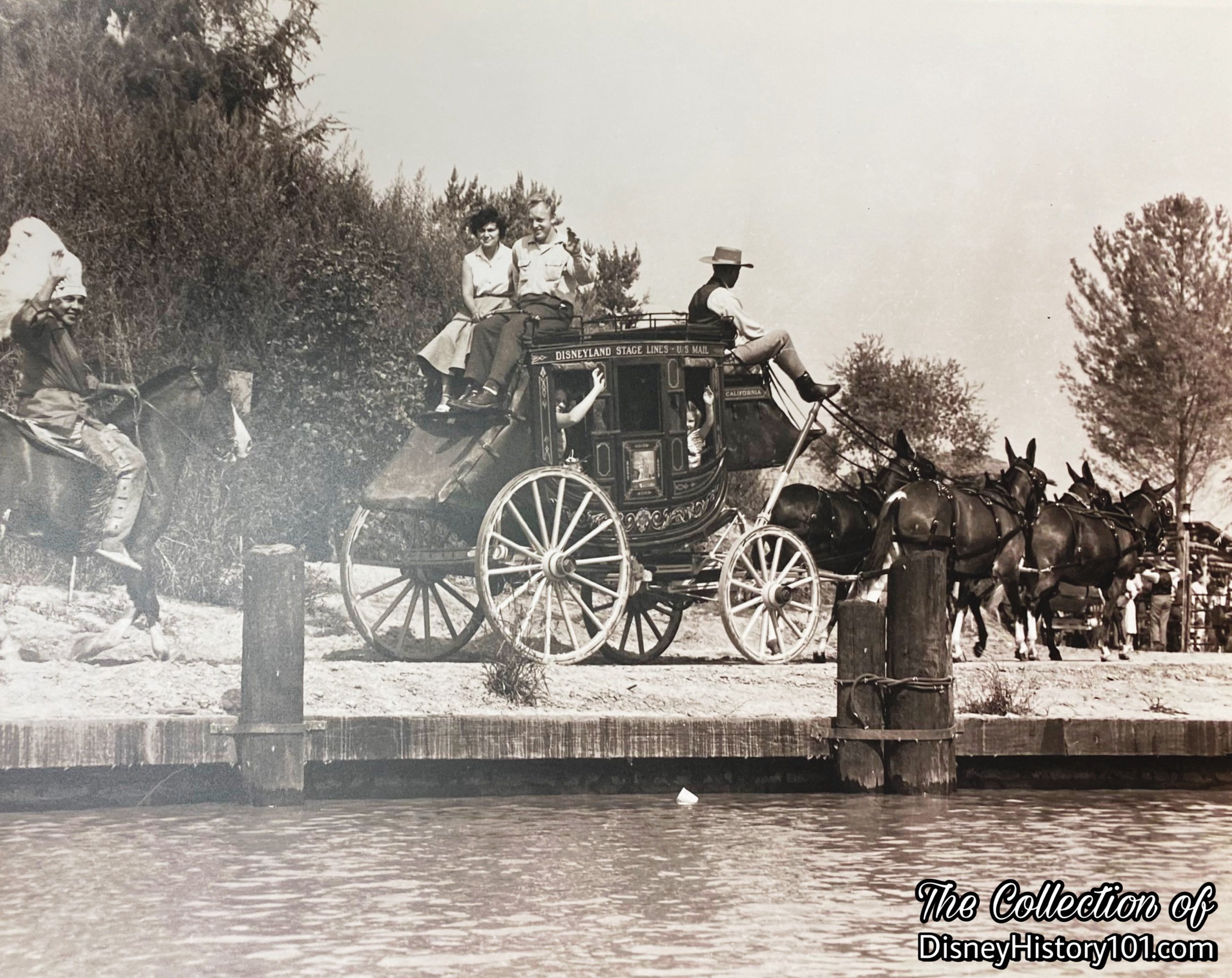
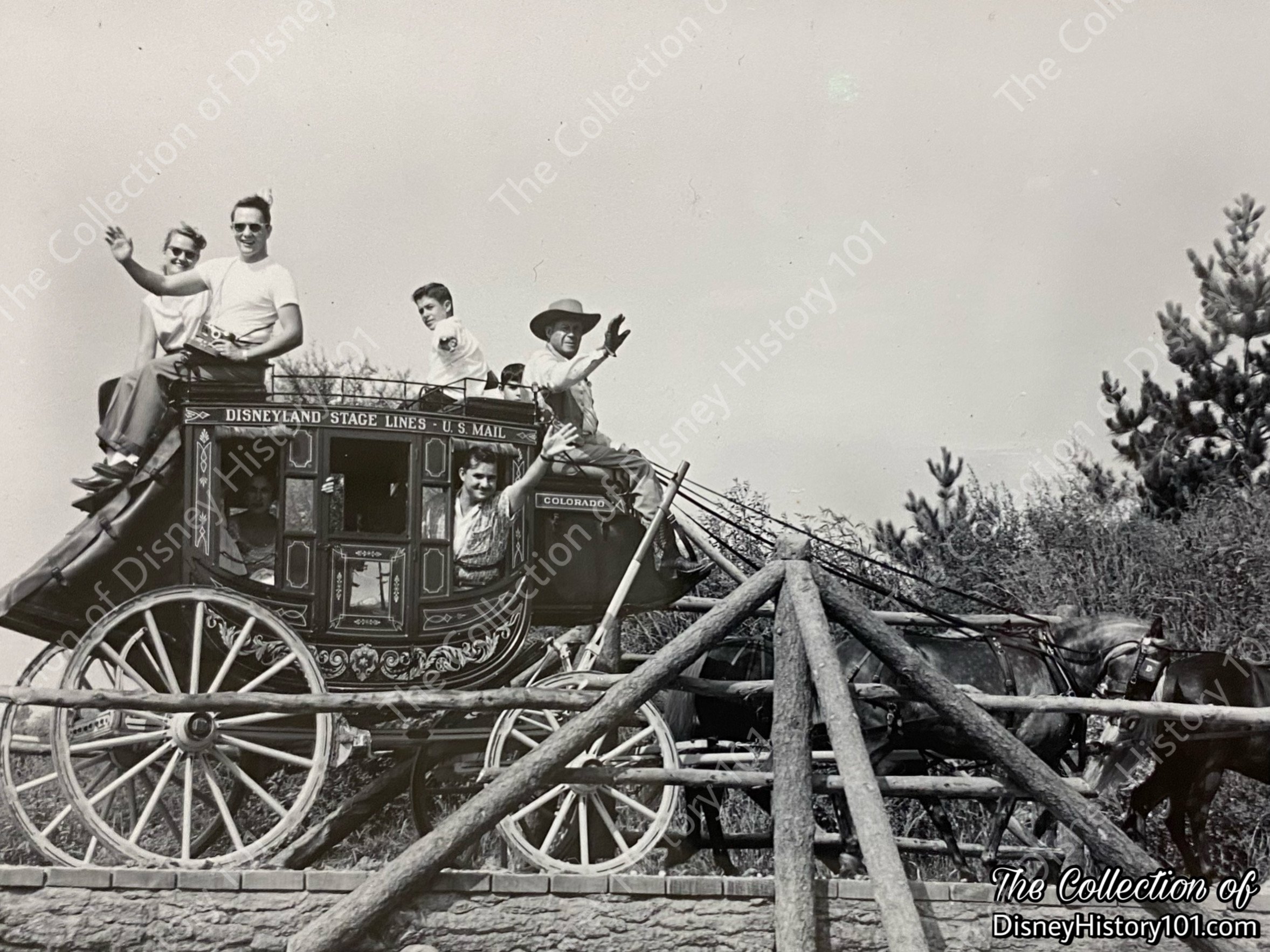
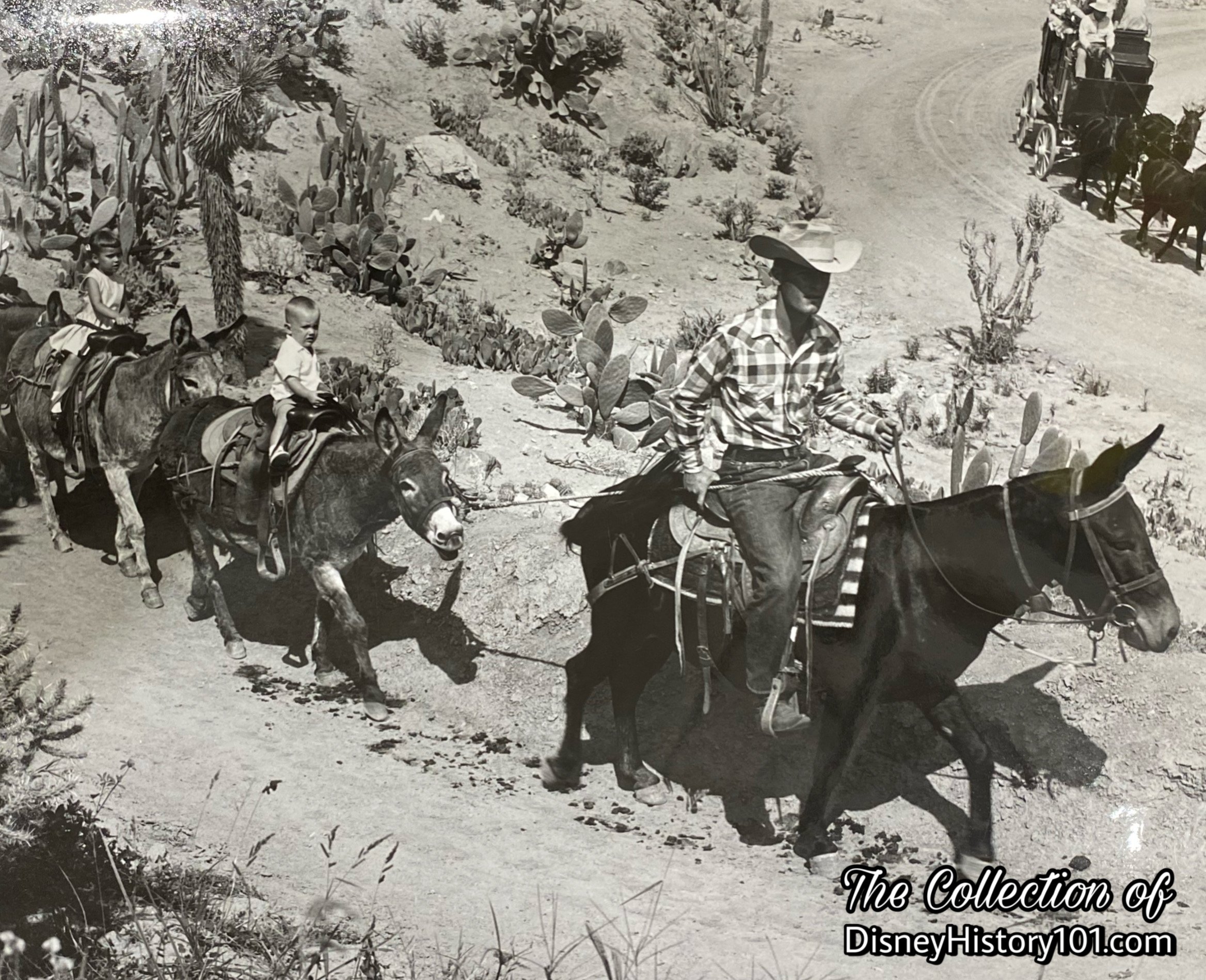
A press release photo depicts a Mule Train on the trail overlooking a Stagecoach; ©️Walt Disney Productions.
At long last, the Disneyland Stage Coaches (and their four-horse hitches) became 1 of 22 initial major attractions at Disneyland, on July 18th, 1955!

Your Guide To Disneyland, published 1955 featured a map of Disneyland depicting the Painted Desert and Wagon Trails stretched out over half of Frontierland (as drawn by artist Michael Harvey). The same map detailed where guests could experience a multitude of adventures by stepping aboard “Buggy Rides”, “Buckboard Rides”, “Wagon Rides”, “Stage Coach Rides”, and “Mule Pack Rides”! At the neighboring Blacksmith Shop, guests could “watch ponies being shod,” and “next door… the harness maker hard at work,” according to c. 1955 “Welcome to Disneyland” maps.
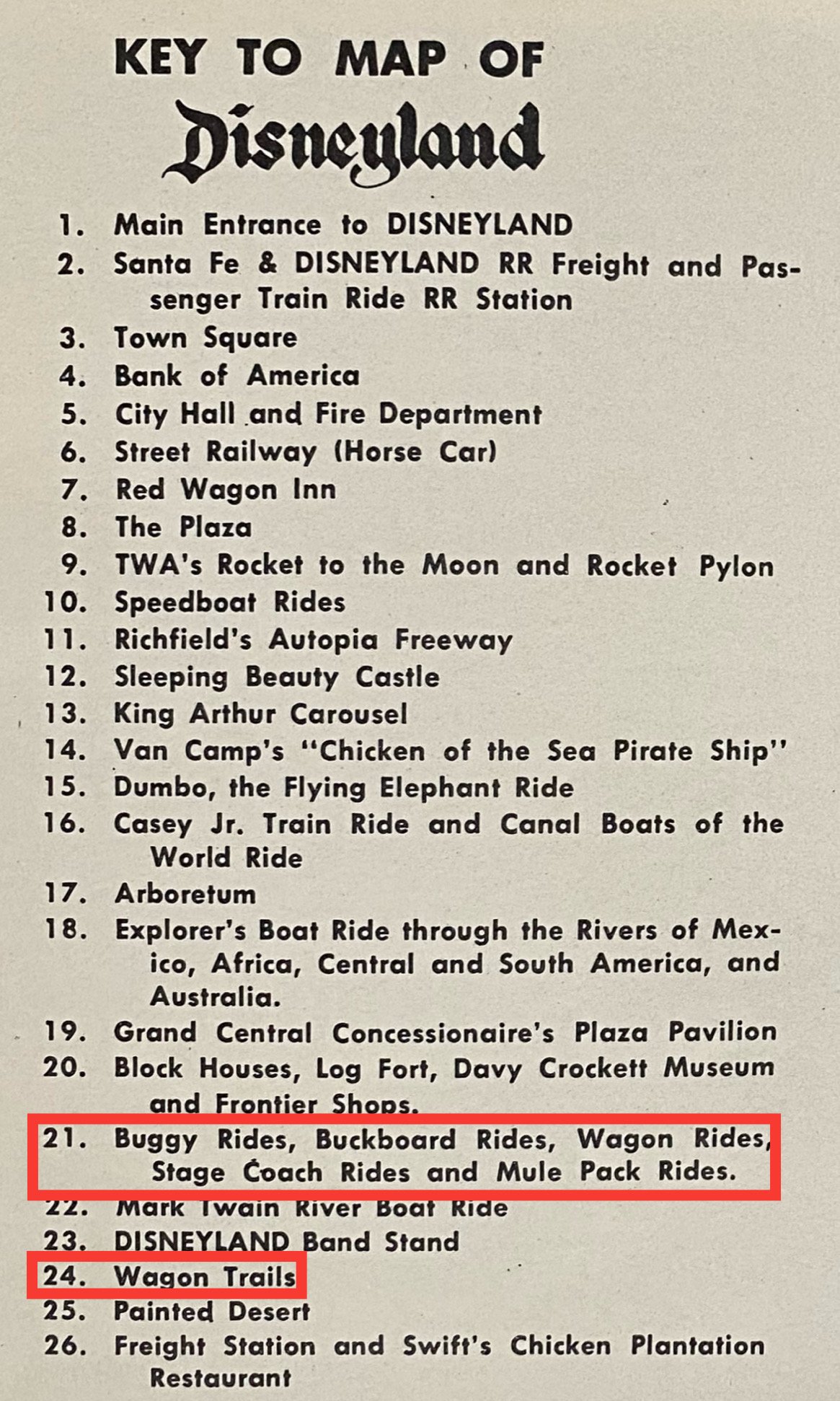
Disneyland Souvenir Book in Natural Color, c.1955.
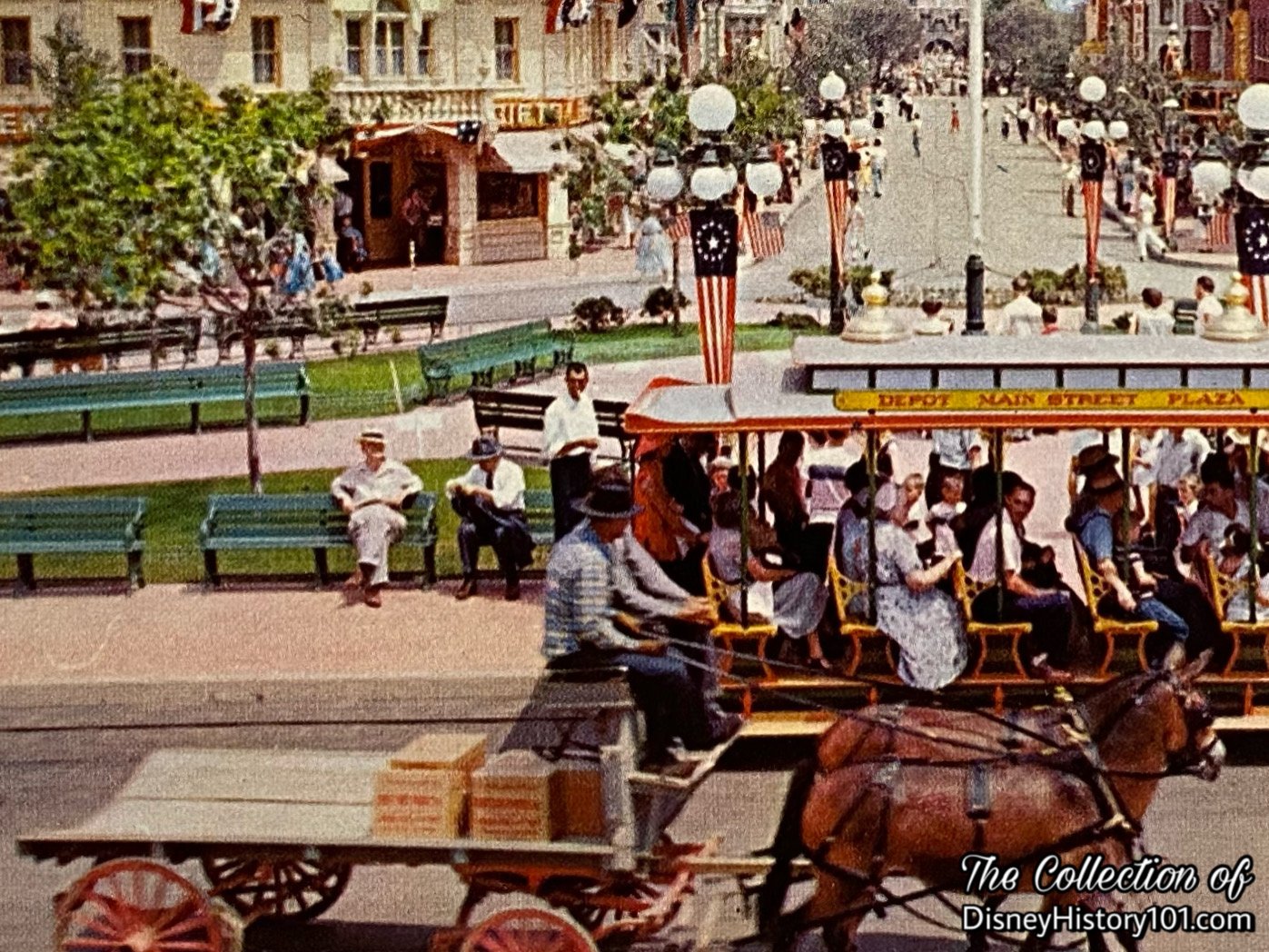
A Buckboard in a Disneyland Souvenir Book in Natural Color, c.1955.
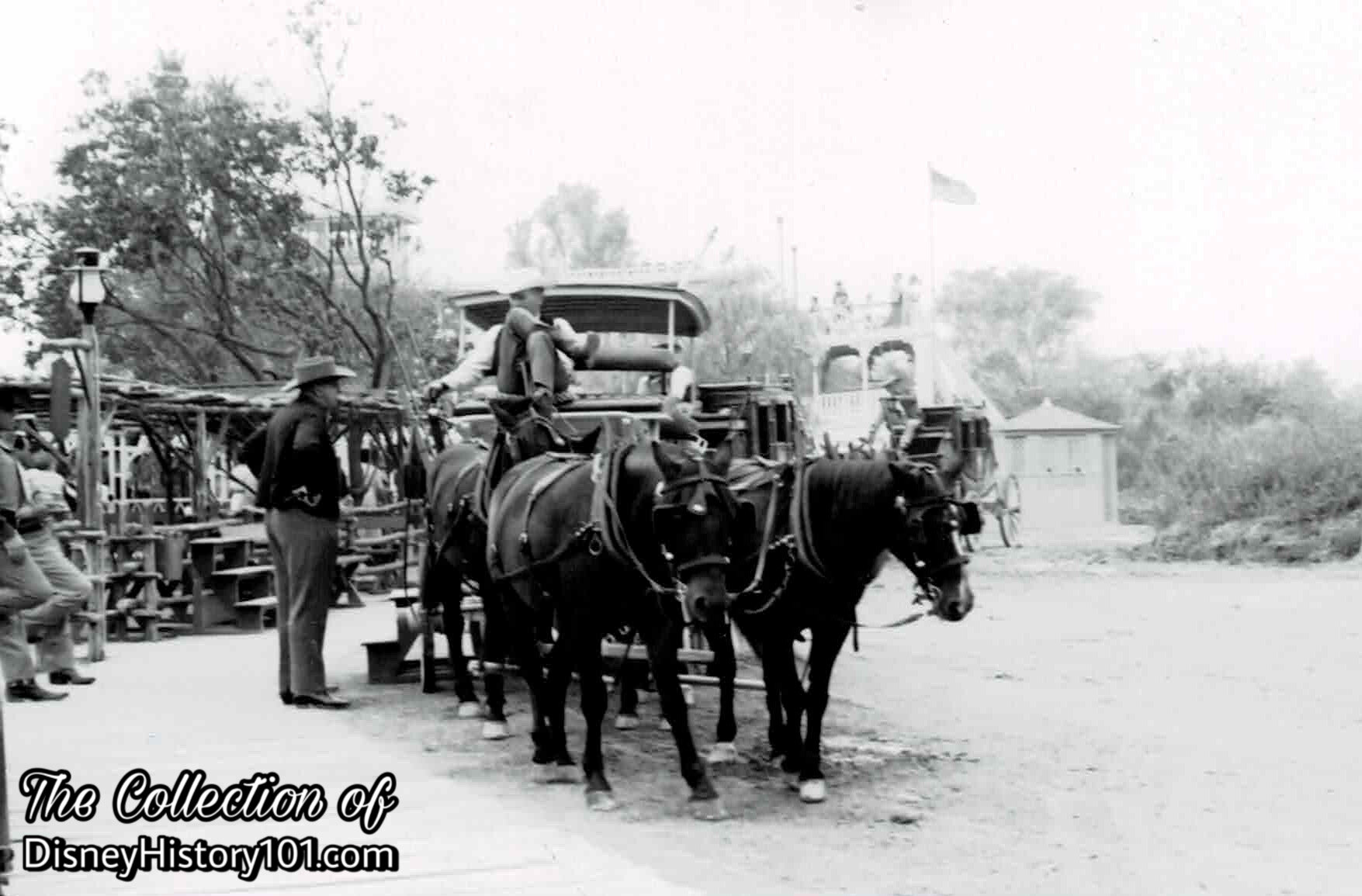
Disneyland Stage Lines Stage Coach
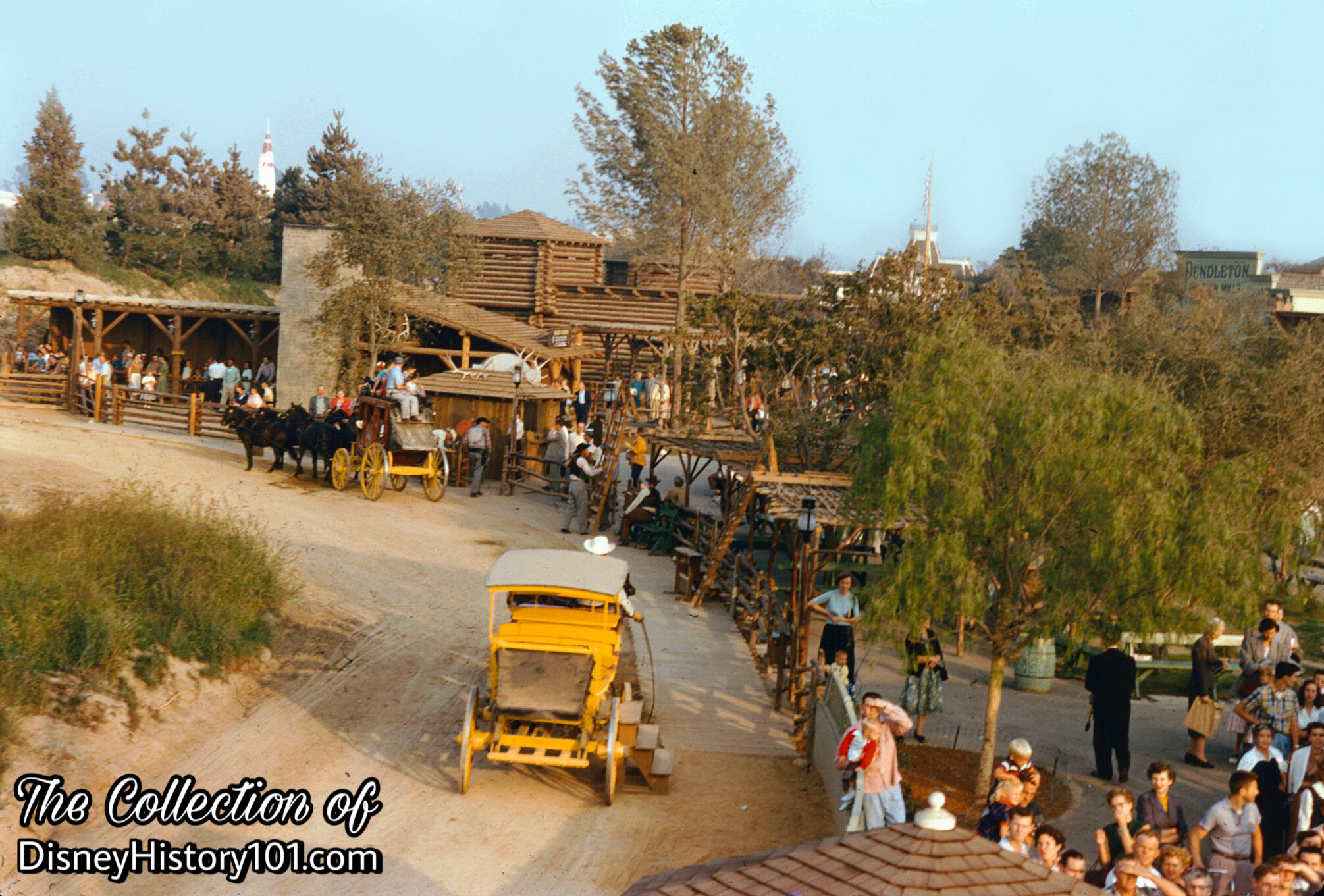
Disneyland Yellowstone Stage and Disneyland Lines Stage Coach Near Loading Platform and Guest Control queue area, c. 1955-1956.
“Audience Waiting Areas” are especially designed as part of the attraction to make the guest's time waiting in line as comfortable as possible. The antler-crested structure (near the center) was the old Frontierland Depot, where passage was booked and tickets acquired aboard one of the Stage Coaches, Conestoga Wagons or Pack Mules. It was Just beyond the Frontierland Stockade, guests step aboard a Disneyland Stage Lines Stage Coach (and a Yellowstone Coach in the foreground) prepared to wheel across the desert and rugged wilderness, as their passengers relive the Frontier days of hardy western pioneers!

Disneyland Stage Lines “Concord” Colorado Stage Coach, (1955)
Younger guests loved sitting inside, above, and (especially) riding “shotgun” in the Driver’s Box of the Disneyland Stage Lines Stage Coach. You may recollect the loading and unloading process took a few minutes to complete. During one Spring of 1956 Disneyland photoshoot, actress Spring Byington (of “December Bride) and child actor Bobby Diamond (of “Fury”) were photographed aboard the “Colorado” Stage Coach (with the tree artwork on the door) for their 1956 “TV Radio Mirror” photoshoot at Disneyland!
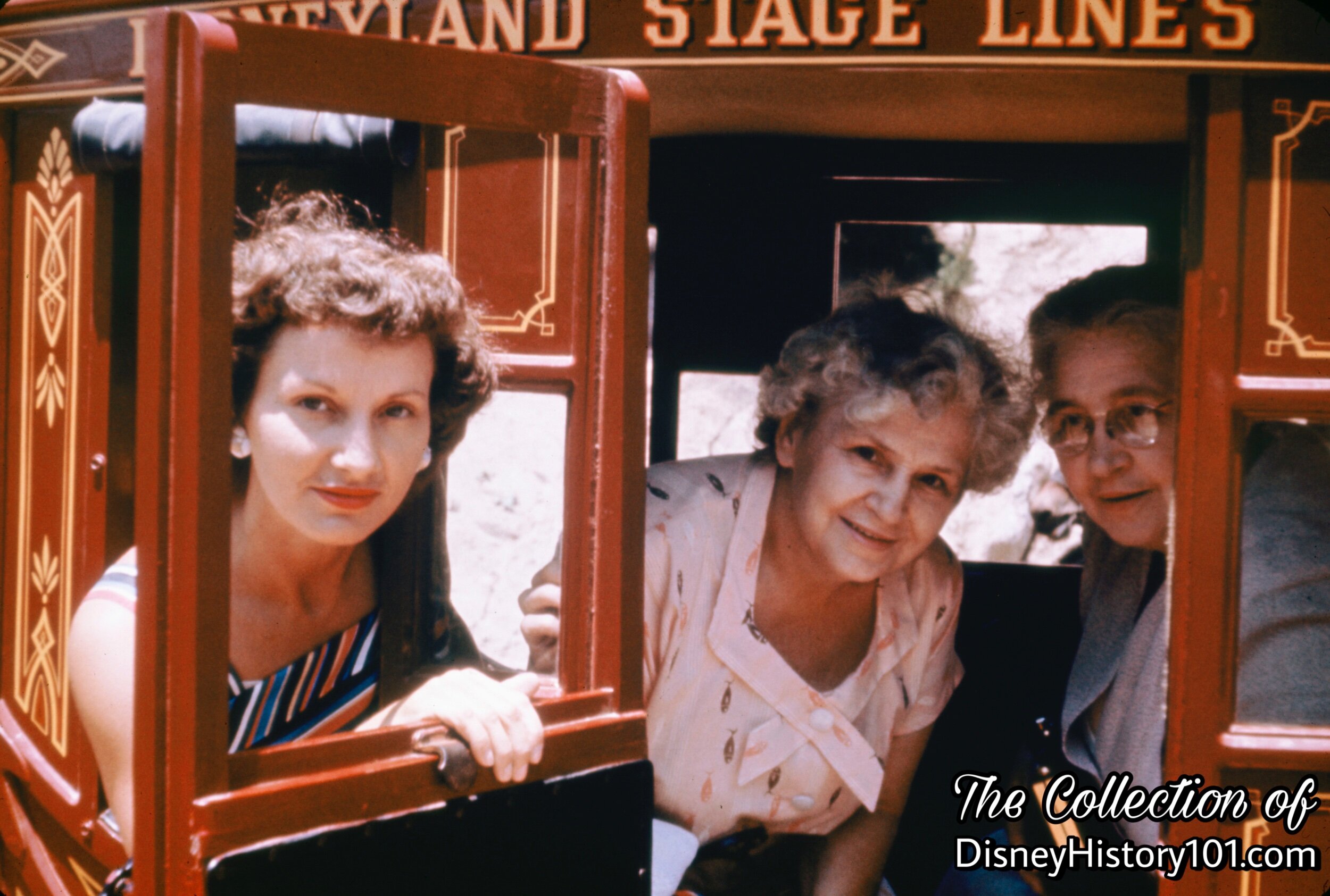
Disneyland Stage Lines Stage Coach and Guests
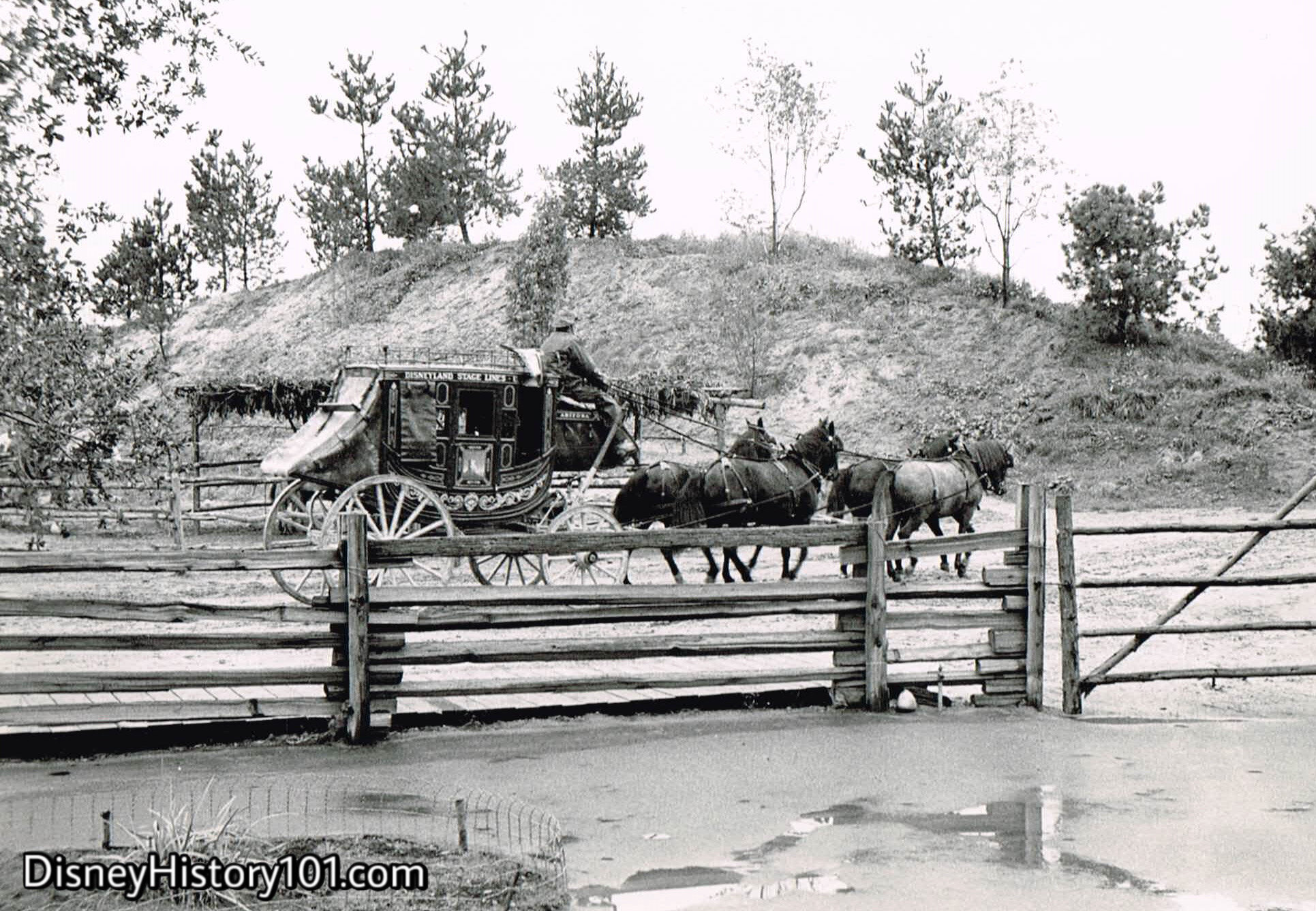
Disneyland Stage Lines “Concord” Arizona Stage Coach with Four Horse Hitch, (1955)
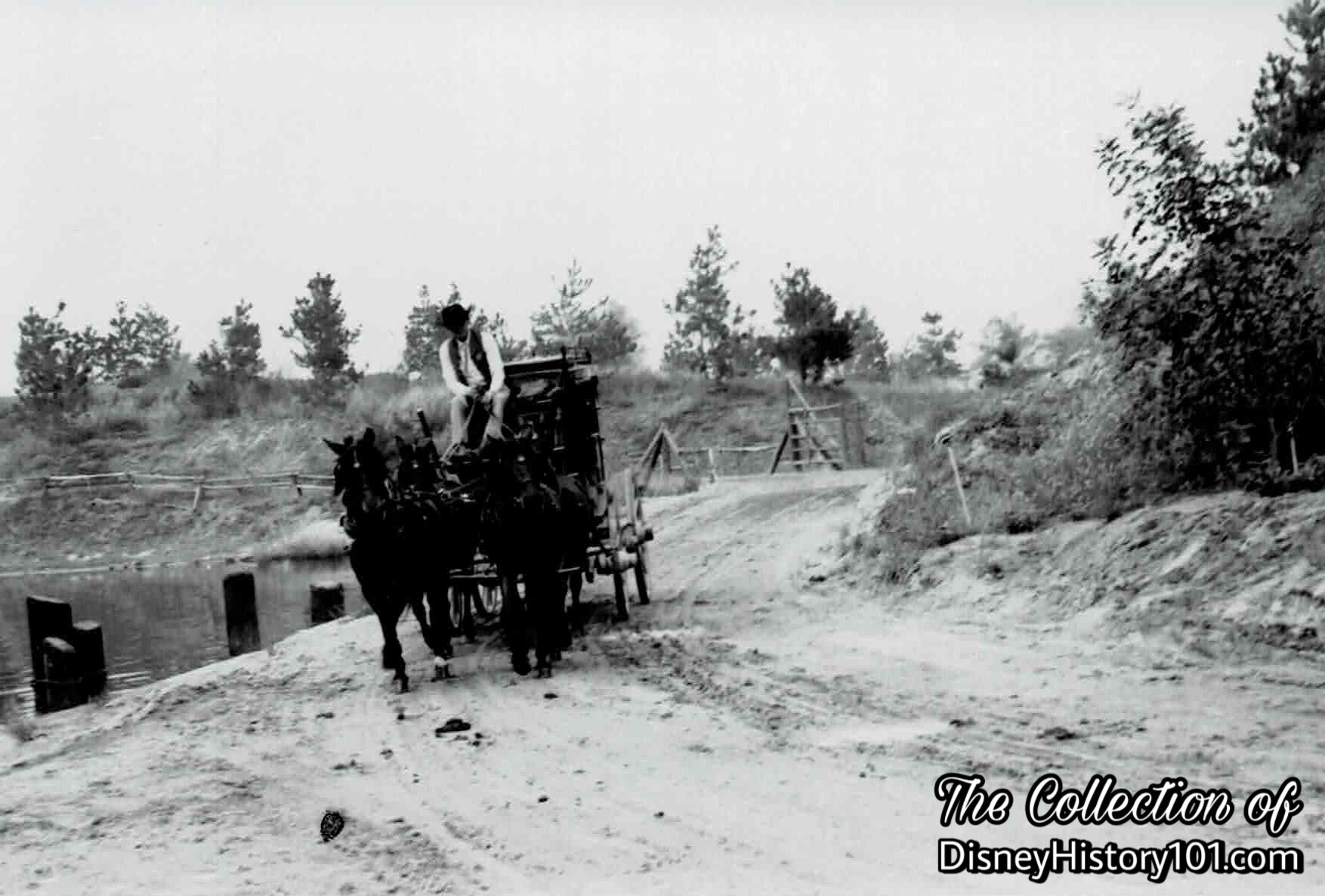
Disneyland Stage Lines Stage Coach
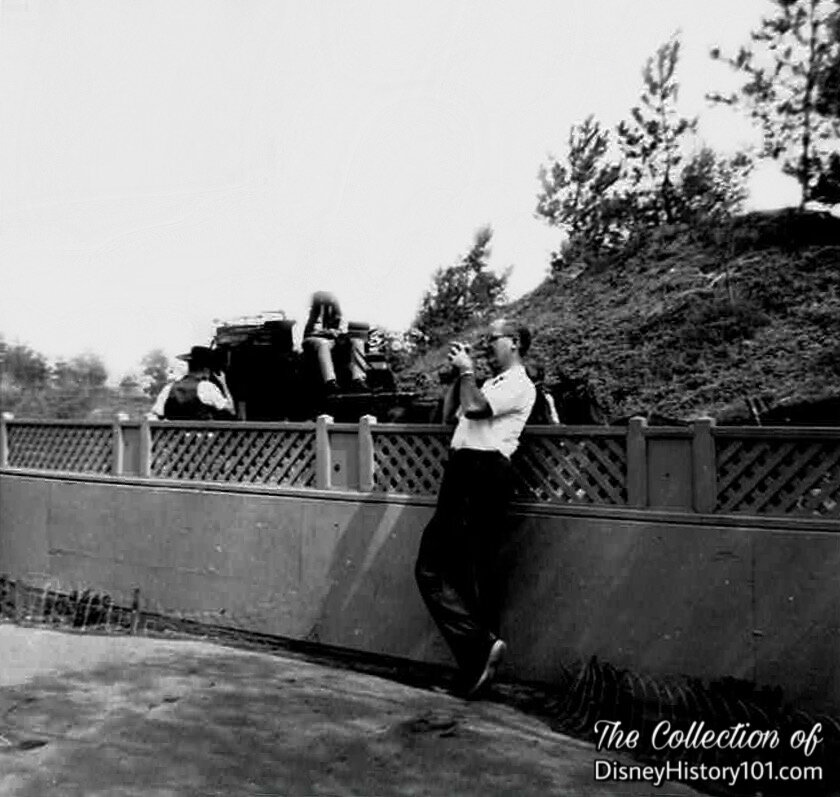
Unidentified Disneyland Stage Lines Stage Coach
A Disneyland Stage Lines Stage Coach passes on the other side of the wall running from the Frontierland River “Boat Dock” to the Stage Coach Loading Platform and queue.
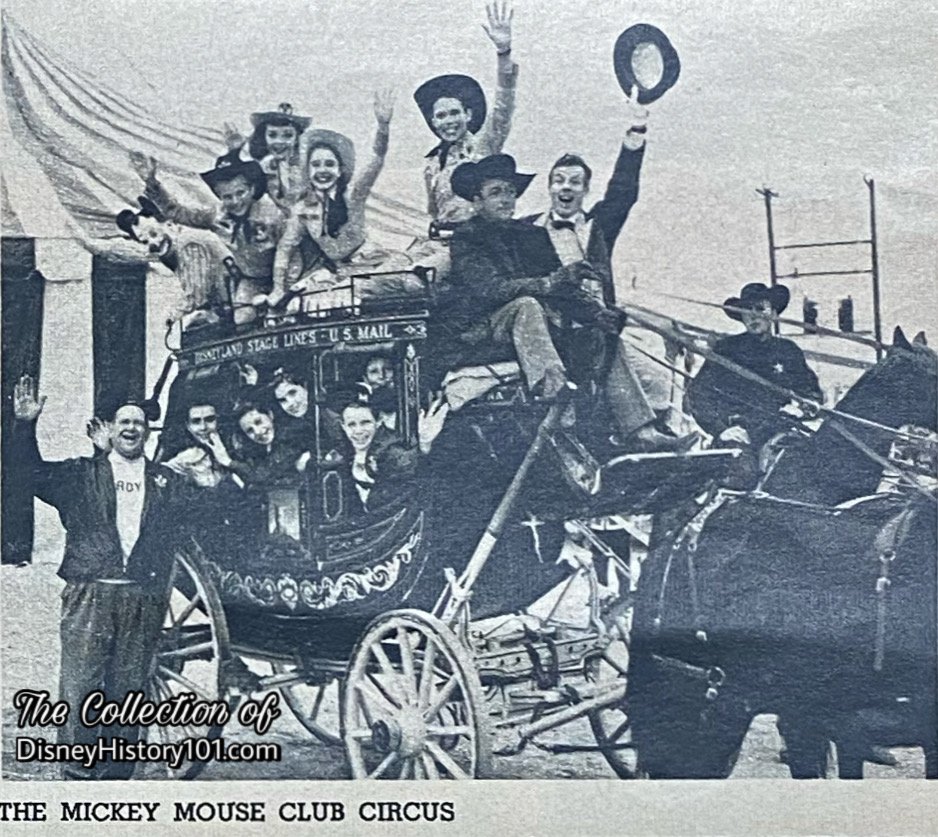
The Mouseketeers ride aboard a Stage Coach for a Mickey Mouse Club Circus publicity shot in this "Disneyland 1st Anniversary Souvenir Pictorial" Excerpt, published 1956.
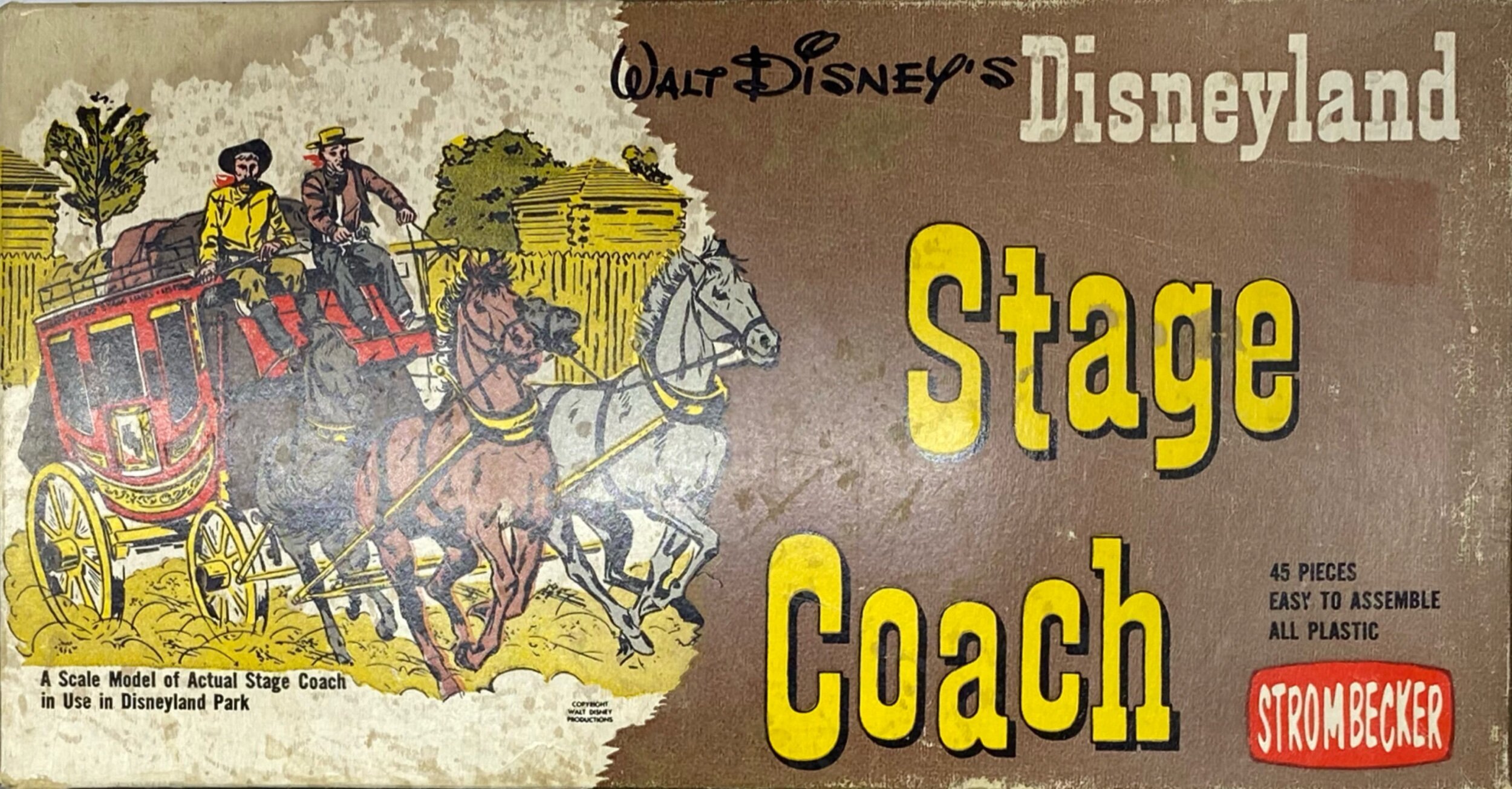
Walt Disney's Disneyland Stage Coach Model Kit Box, (Late 1950s - 1960s)
Disneyland provided an excellent outlet for licensed merchandising that was also available through retailers outside the park. Many of Disneyland’s iconic attractions were licensed as merchandise - from frame-tray puzzles and plastic toys, to salt-and-pepper shakers and ash trays. Some of them even received the “model” treatment - from the Global Van Lines Truck, to the “Jolly Roger” (known around these Disneyland parts as the Chicken of the Sea Pirate Ship Restaurant)! Strombecker manufactured several models of craft featured in Walt Disney’s “Man in Space” and “Mars and Beyond” (i.e. the Satellite Launcher, Moon Rocket, Space Station, and Space Ship), both Disneyland anthology series episodes of which first aired during 1955 and 1957. But now (by 1954-1955), Strombeck-Becker, Mfg. would commemorate the quaint and terrestrial Disneyland “Concord” Stage Coaches. By June 8, 1955, Mr. Lozier (of Walt Disney Productions Character Merchandise Division) had produced a model with horses, which had been approved by C.S. Olson (of Strombeck-Becker Mfg. Product Developement) and was ready to be presented to Philip Sammeth (of WDP Character Merchandise Division).
The final product was a Strombecker-manufactured easy-to-assemble 45-piece plastic Disneyland Stage Coach Model Kit, which was “a scale model of [an] actual stage coach in use in Disneyland Park” (as advertised on the box). The model kit came with decals to recreate the Disneyland Stage Lines Arizona Coach. This model was so popular (within 1954-55), that both Conestoga Wagon and Mule Pack kits (potentially Walt Disney Productions licensed merchandise) were also suggested by Strombeck-Becker Mfg.
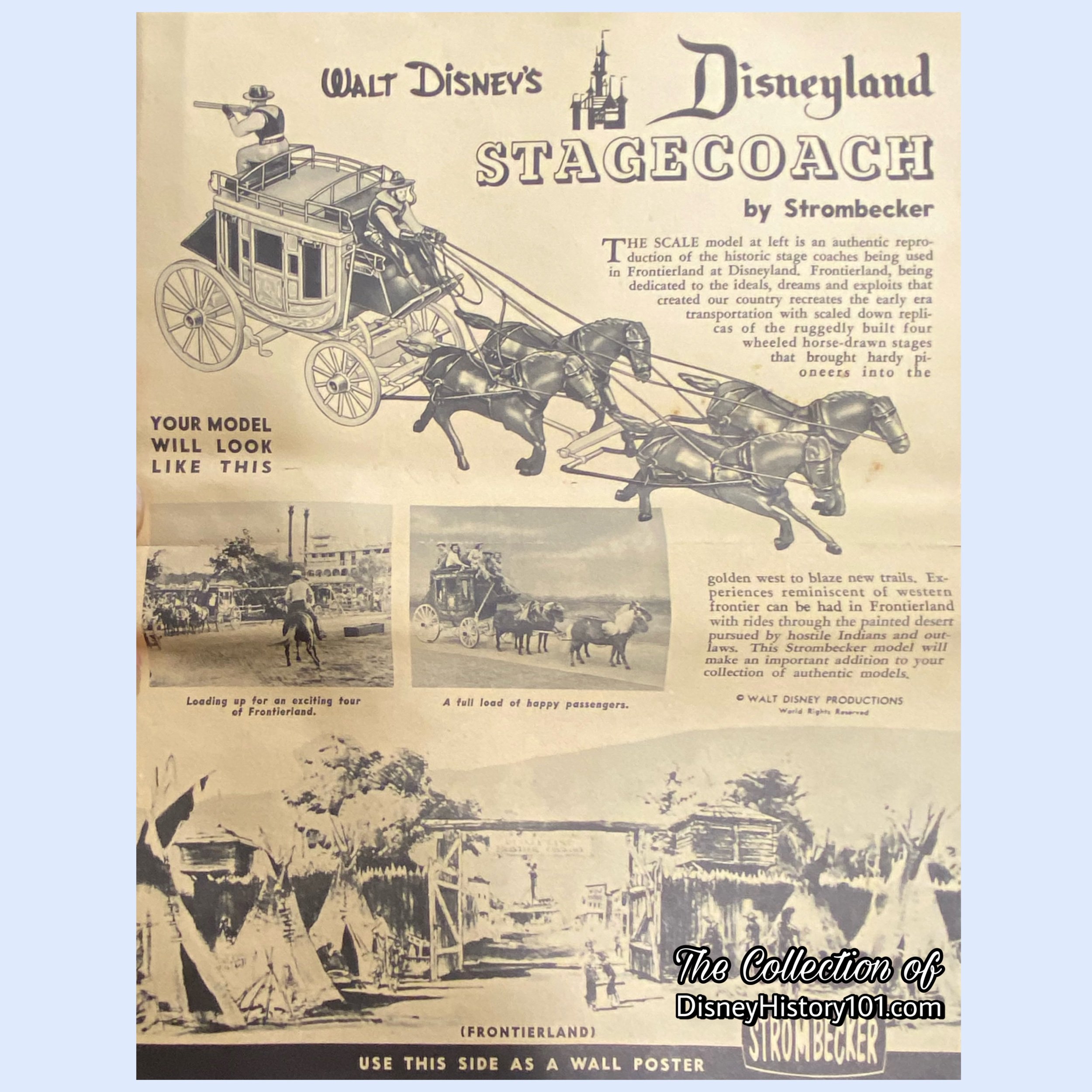
Disneyland Stage Coach Model Kit Wall Poster, (Late 1950s - 1960s)
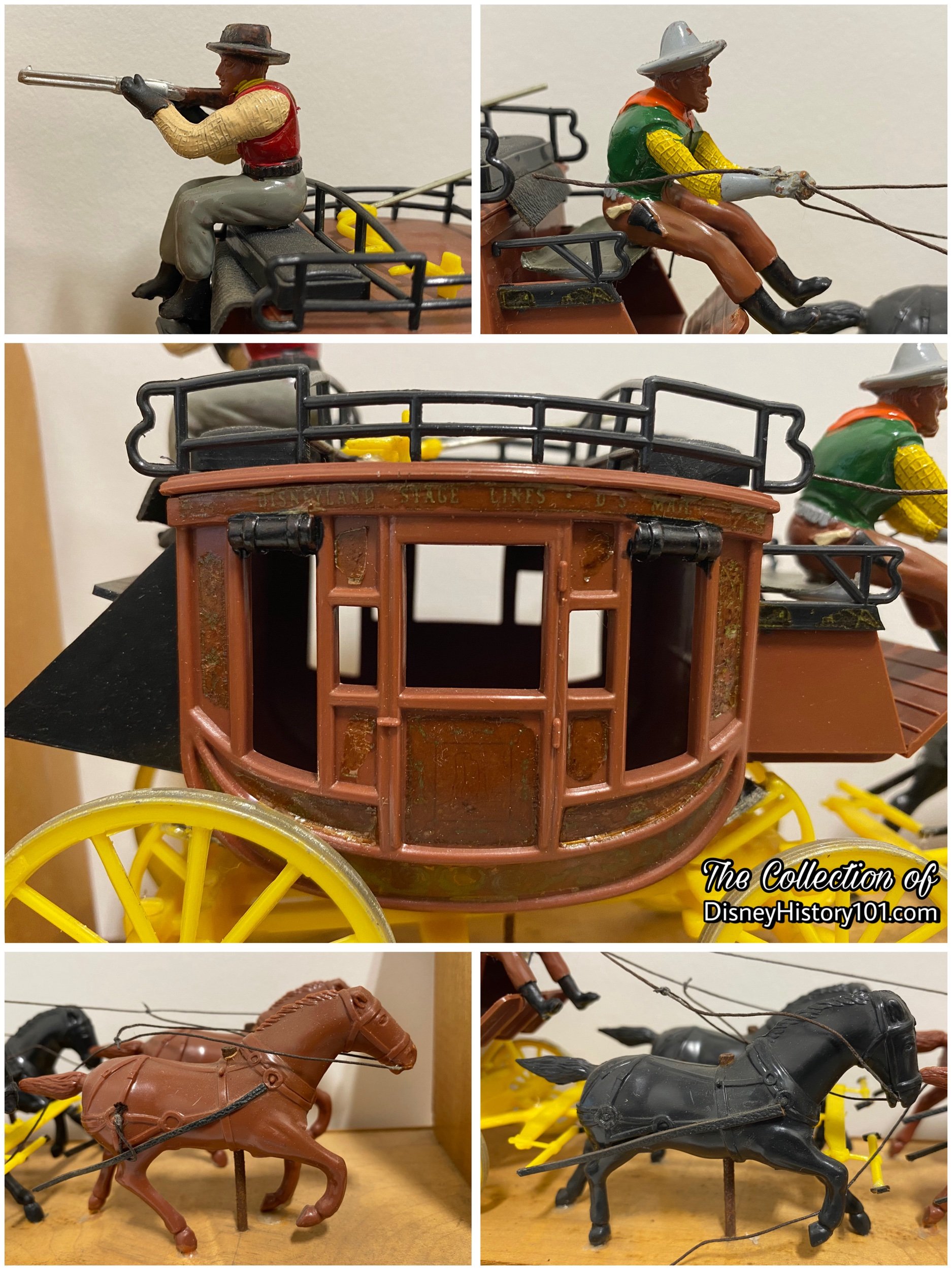
Walt Disney's Disneyland Stage Coach Model Kit
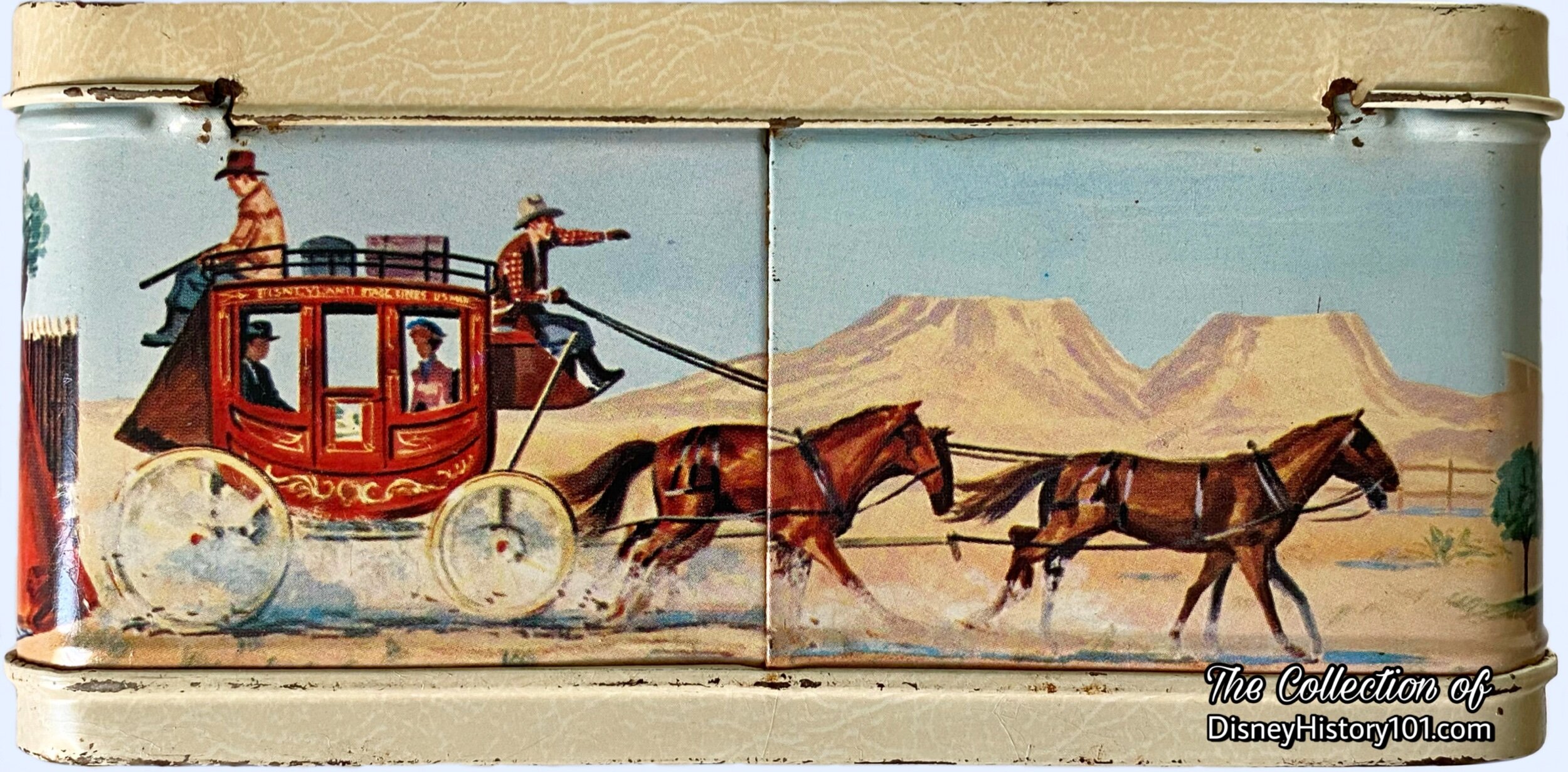
Disneyland Lunch Box Featuring (Perhaps) the Disneyland Stage Lines Colorado Coach, Aladdin Industries (1950s)
From iron-on transfers to lunch boxes - many other pieces of licensed Disneyland merchandise featured the character of the Rainbow Mountain Stage Coaches.
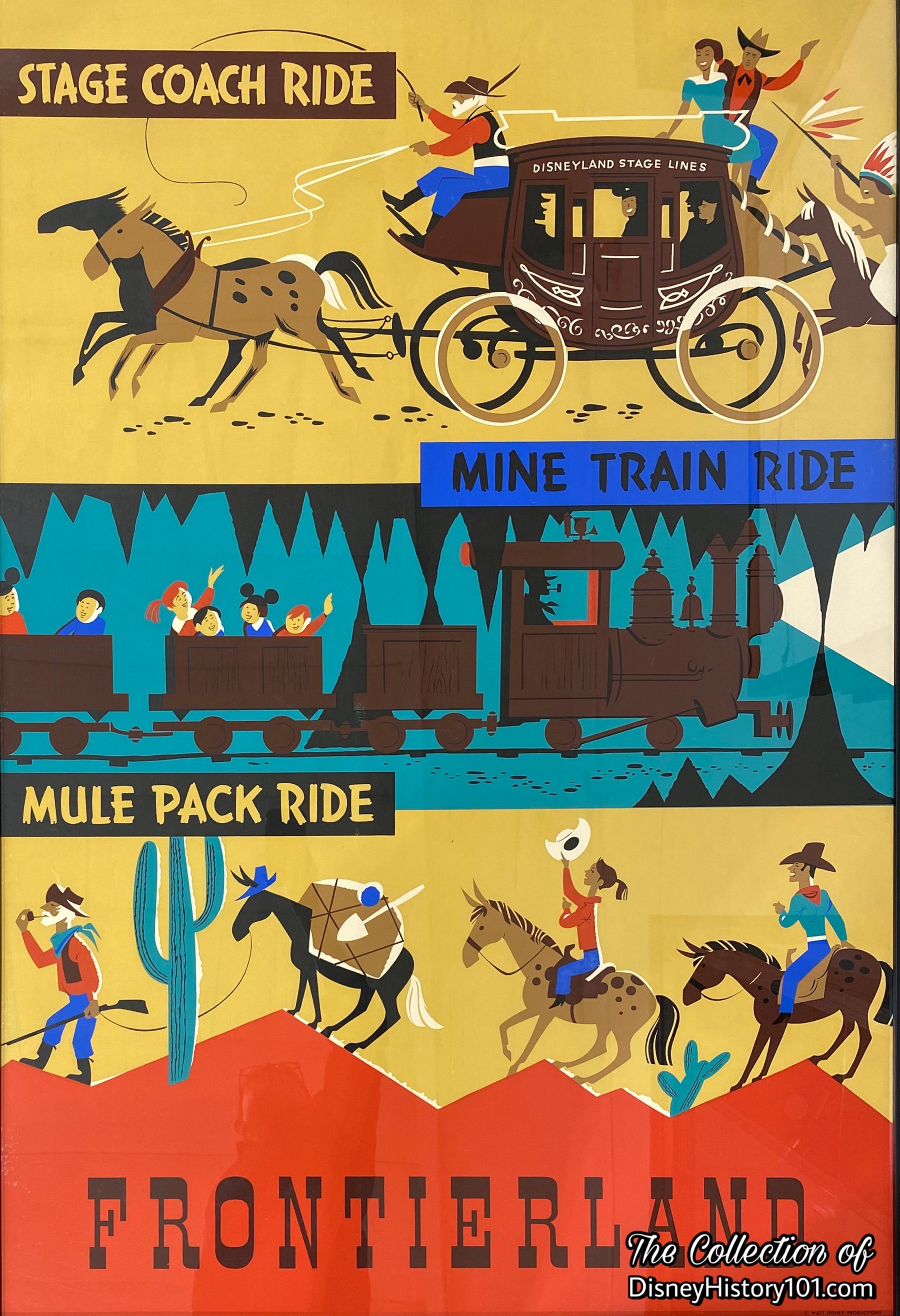
Stage Coach, Mine Train and Mule Pack Attraction Poster designed by Bjorn Aaronson, 1956.

(June 26th, 1956 - September 13th, 1959*)
*Some sources as the Disneyland Rides, Attractions & Attendance Report cite February 10th, 1960 (though it is unlikely, as Nature’s Wonderland was under construction).
Times were “a changing’” and soon, new features of the desert were added to maps. At a meeting of the Disneyland Merchant's Association (held January 25, 1956), a momentous announcement was made: “All horsedrawn vehicles in the Frontierland area will be shutdown for approximately two months, during the redesign and reconstruction of this area. This will be a whole new development to increase ride capacity. We are building a mountain to be called Rainbow Mountain. This will be seen from the River and the Mark Twain. The existing corral and Black smith Show will be the entrance to a new ‘Mine Train’ ride. This will be an old fashioned Mining Train with 6 open cars. The engine will look like a real engine. The ride will go through a canyon out into the desert; then into a Rinbow Mountain where you tunnell with stalagmites and stalactities and three different water falls of different colors, joining in the river. This ride will take about 6 minutes…Stage Coach Rides route will be changed and we will add three new Stage Coaches.”
Other vehicles also started offering an alternate view of what was now billed as the “Rainbow Desert” (formerly the Painted Desert) beginning in 1956. The Disneyland Stage Lines Stage Coaches would embark from a cross-roads for all sorts of desert explorational vehicles - the new little mining town of Rainbow Ridge! Only now, the Disneyland Stage Lines Stage Coaches (also referred to as the “Yellowstone Stage Coaches”) would be renamed as the Rainbow Mountain Stagecoaches, and would soon be replaced by three Mud Wagons, or Buckboards - No. 4, No. 5, and No. 6 (intended to be pulled by a four-pony hitch). Once completed a 1958 appraisal placed the old western stage coaches and Conestoga wagons at a value of $172,800 (ride structure) and $36,790 (equipment).
This proved the truth of Walt Disney’s promise of an ever-expanding Disneyland! These new modes of desert transportation were among some of the exciting attractions debuting during 1956, that increased ride capacity! Owing to this, one day in August saw a peak total of “197,547 individual rides” enjoyed by Guests (according to a letter from Walt to Ward Kimball, dated January 23, 1957).
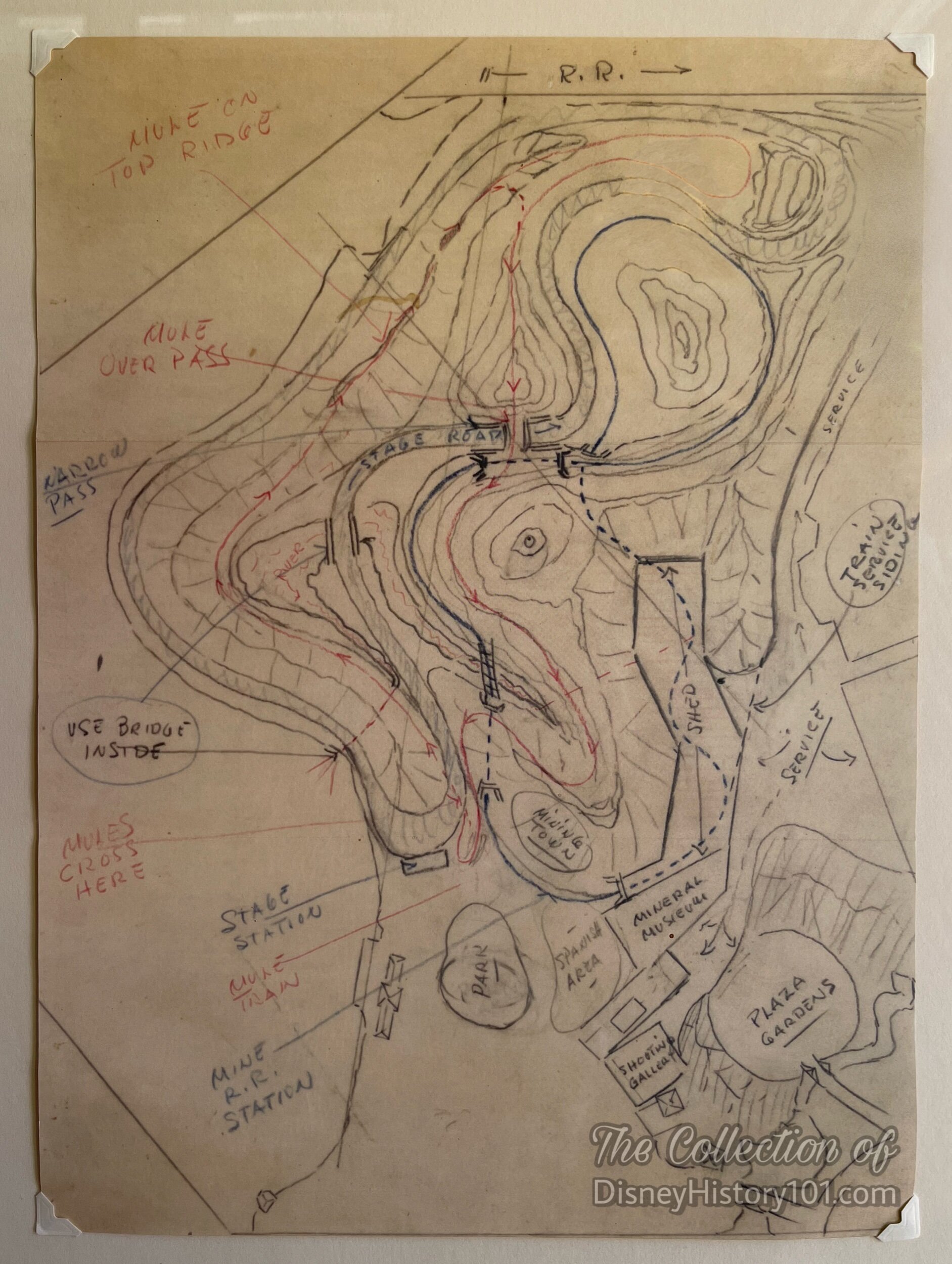
Mine Train Elevation Drawing, (c. 1956) ; The Jeff Ino Collection at Walt's Carolwood Barn
The region was initially called the ‘Painted Desert’ [in 1955]. It was redeveloped to add the Mine Train [July 2nd, 1956] and the name became the ‘Rainbow Desert.’ This was the name of the desert territory that the Disneyland Stage Lines Stage Coaches would traverse, for their duration of operation! These same Concord Stage Coaches (now renamed Rainbow Mountain Stage Coaches) would continue to give passage through the desert (from dawn until dusk) for three years.

Rainbow Mountain Mud Wagon #5; ©️Walt Disney Productions.
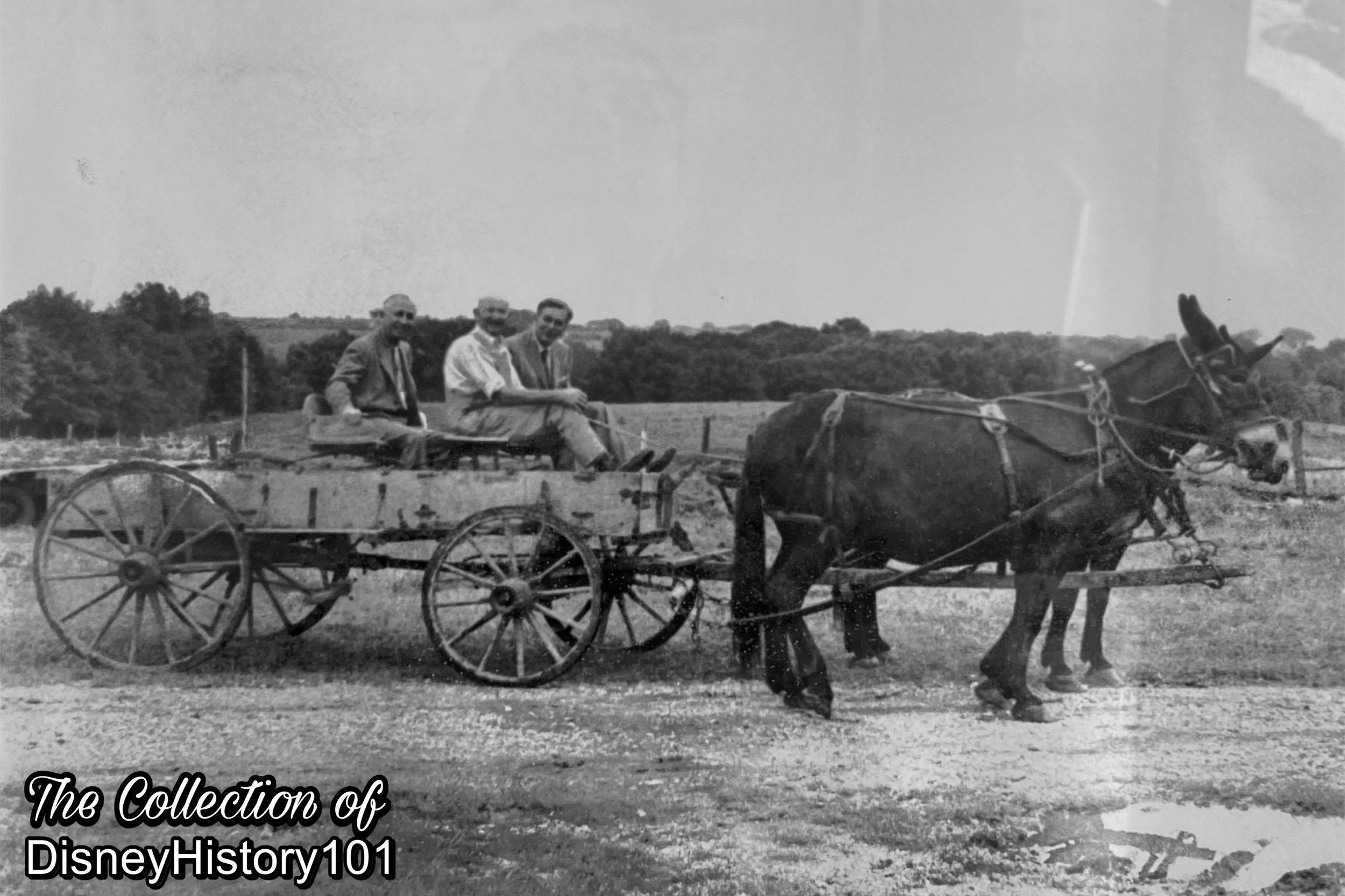
Walt & Roy visit Marceline over Fourth of July weekend 1956; L-R: Roy Disney. Frank Van Tiger, Walt Disney
In 1906 Frank had delivered fence posts to the Disney Farm in his Peter Schttler Wagon. When Walt and Roy came back for a visit in 1956 (not long after the addition of the Mud Wagons at Disneyland) they enjoyed a ride in the very same wagon pulled by mules.
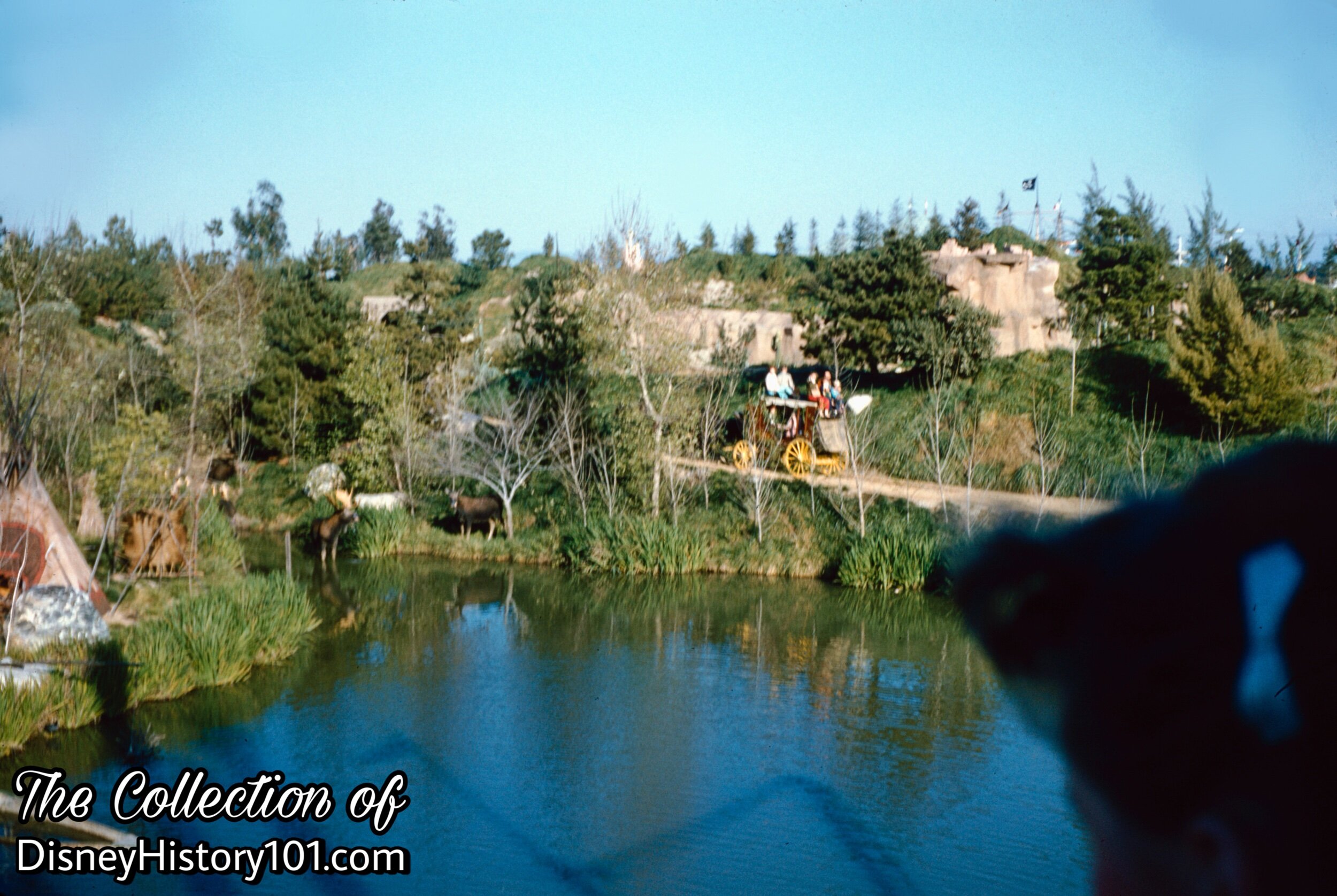
Disneyland Stage Lines Mud Wagon Coach, (1958)
The Rainbow Mountain Stage Coaches continued through Friendly Indian territory, and once gaining passage, come to a fork in the road. Instead of heading over the berm (and toward the Pony Farm), the Stage Coaches head into the desert!
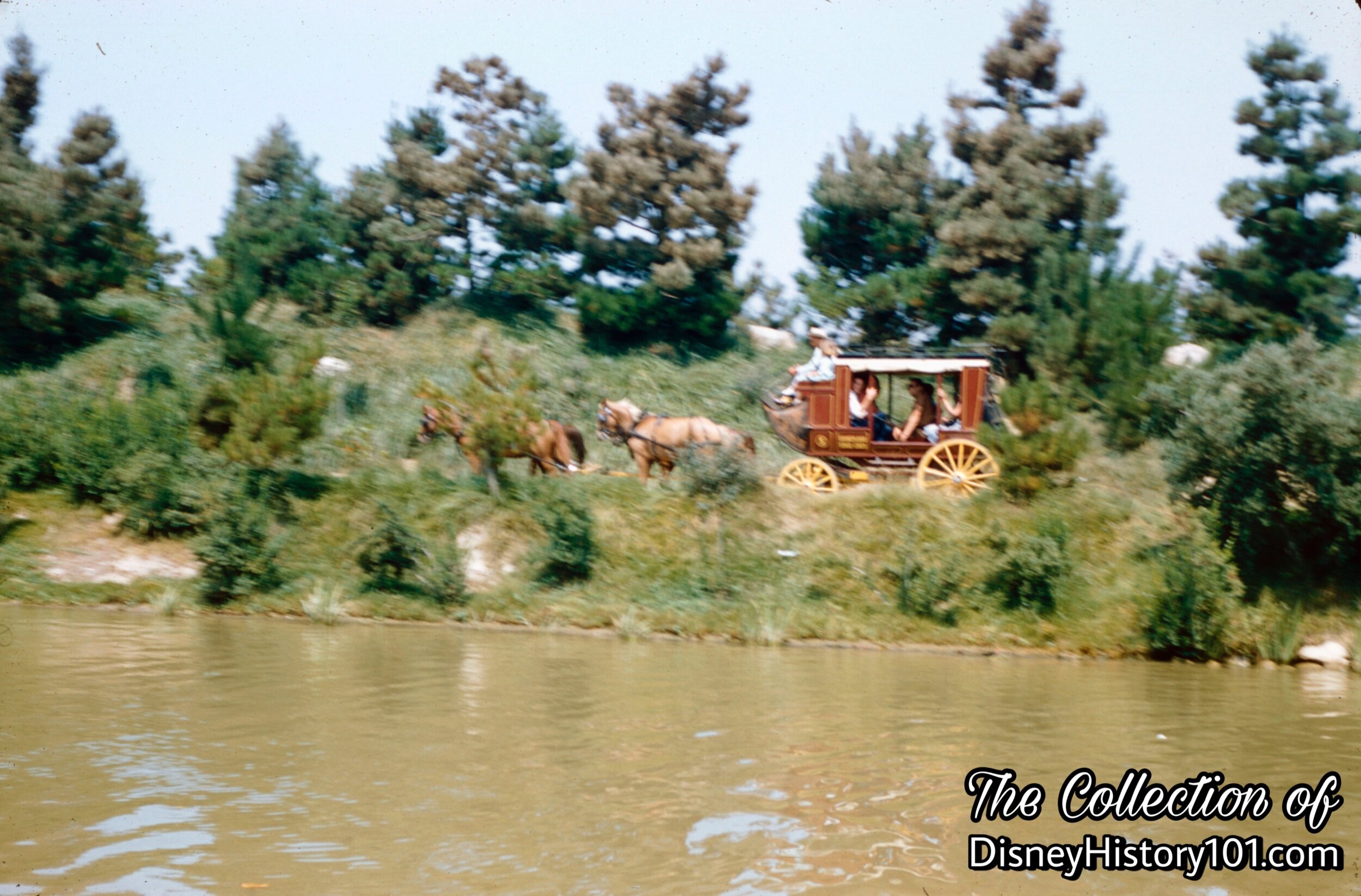
Disneyland Stage Lines Mud Wagon Coach #5
After departing the town of Rainbow Ridge, the Disneyland Stage Lines Stage Coaches ran along a route parallel with the waters of the Rivers of America!
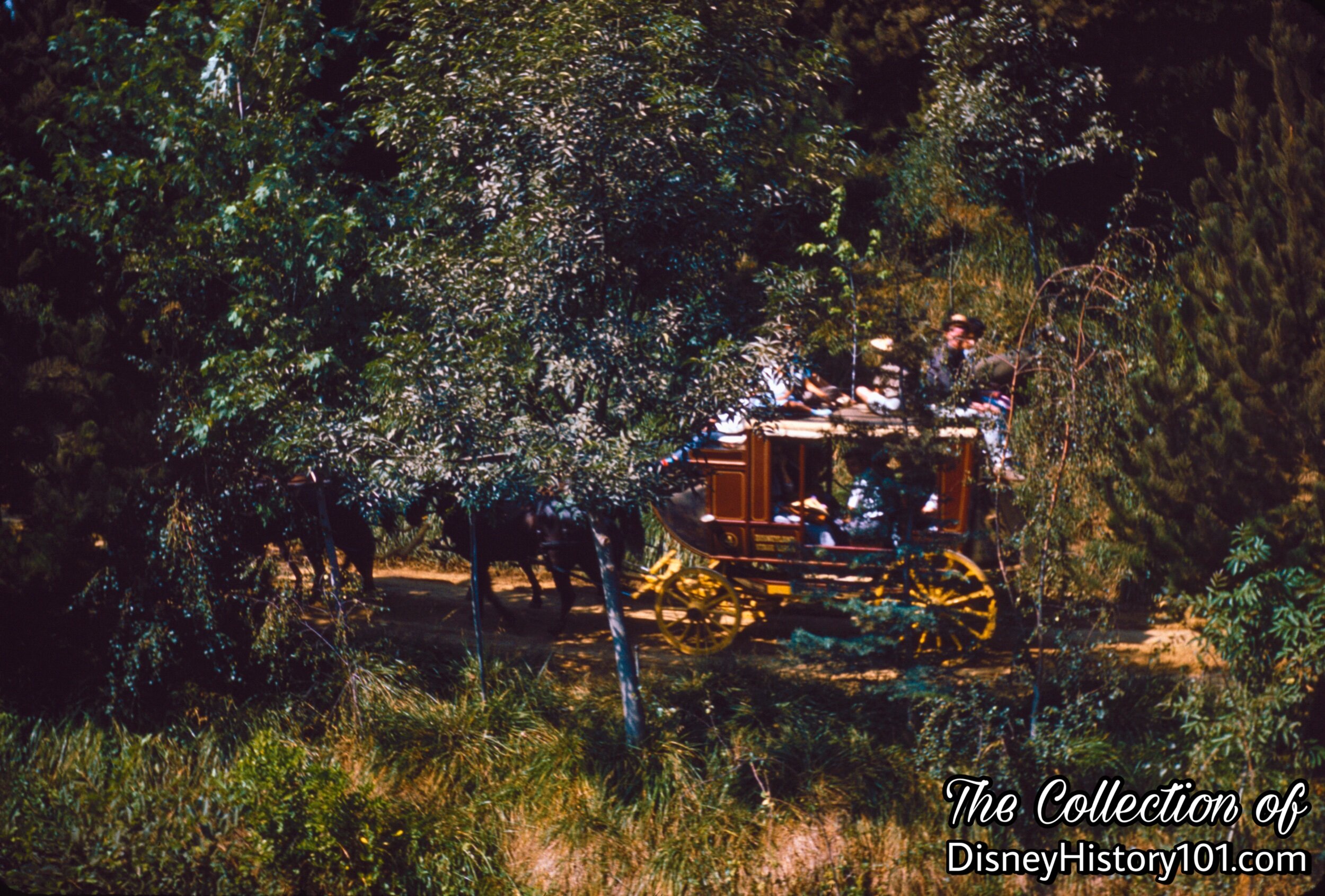
Disneyland Stage Lines Rainbow Mountain Mud Wagon Coach #4, (August, 1966)
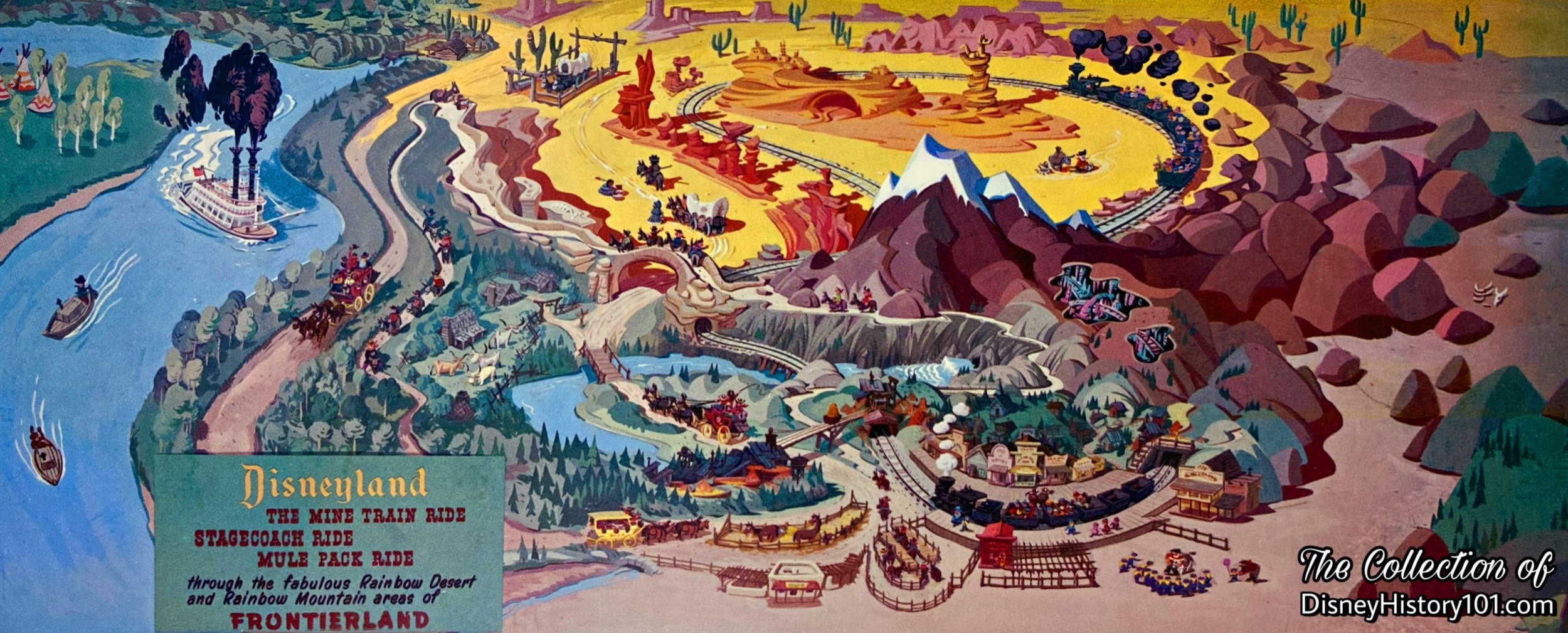
This image was also the subject of a Disneyrama postcard.
"The Official Guide to Disneyland" Excerpt, 1956. This is a Walt Disney Artist's conception of a section of FRONTIER-LAND in Disneyland, featuring the awe inspiring Mine Train Ride, the exciting Stagecoach and Mule Pack Rides, where one can journey through the many fantastic sights of the Rainbow Desert and Rainbow Mountain areas, returning with a view of the famous Mark Twain River Boat and Tom Sawyer Island.
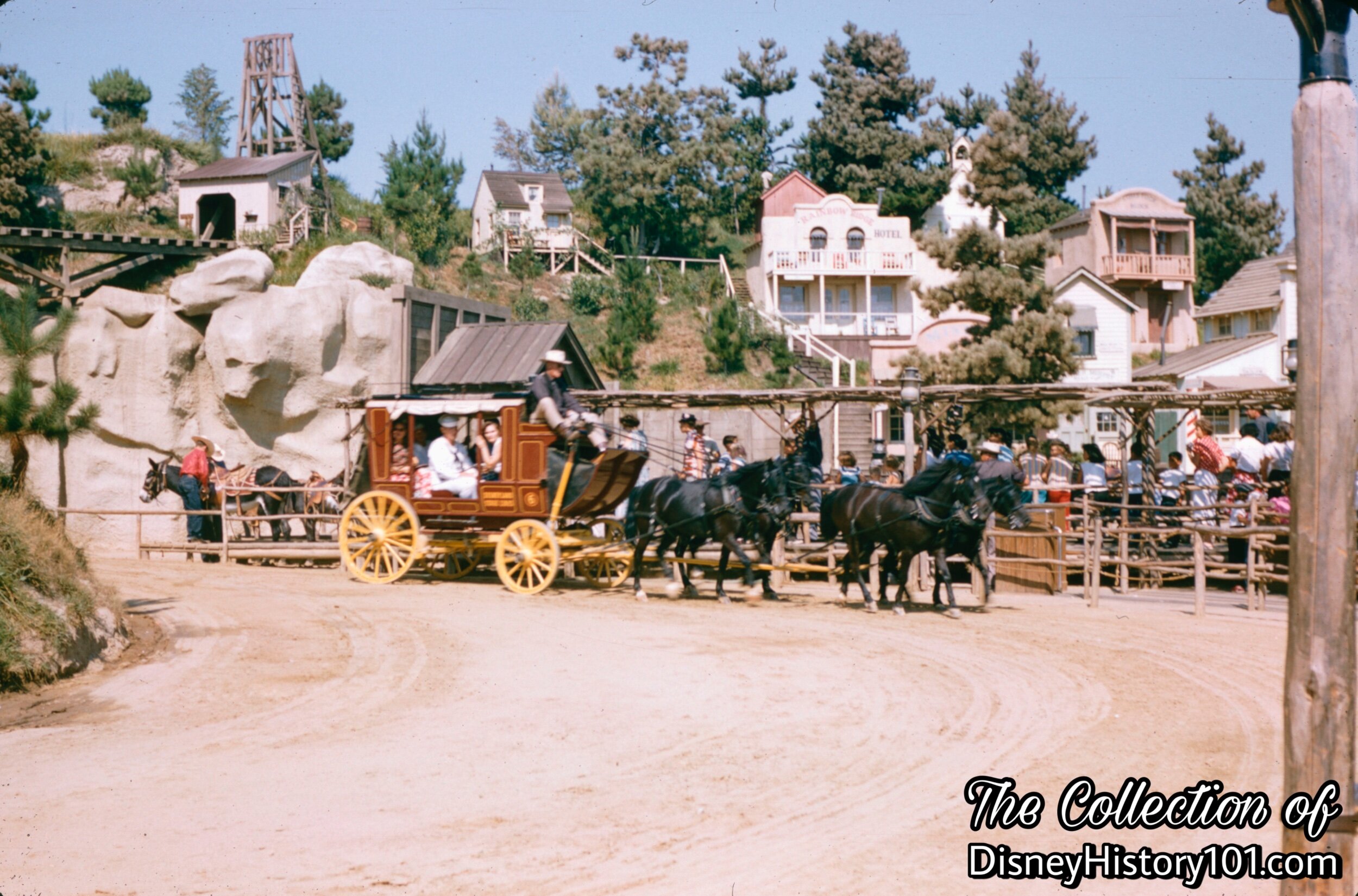
Disneyland Stage Lines Mud Wagon Coach #6 at Rainbow Ridge
Rainbow Ridge would prove to be the crossroads for mine trains, pack mule trains, and the Disneyland Stage Lines Mud Wagon Coaches!
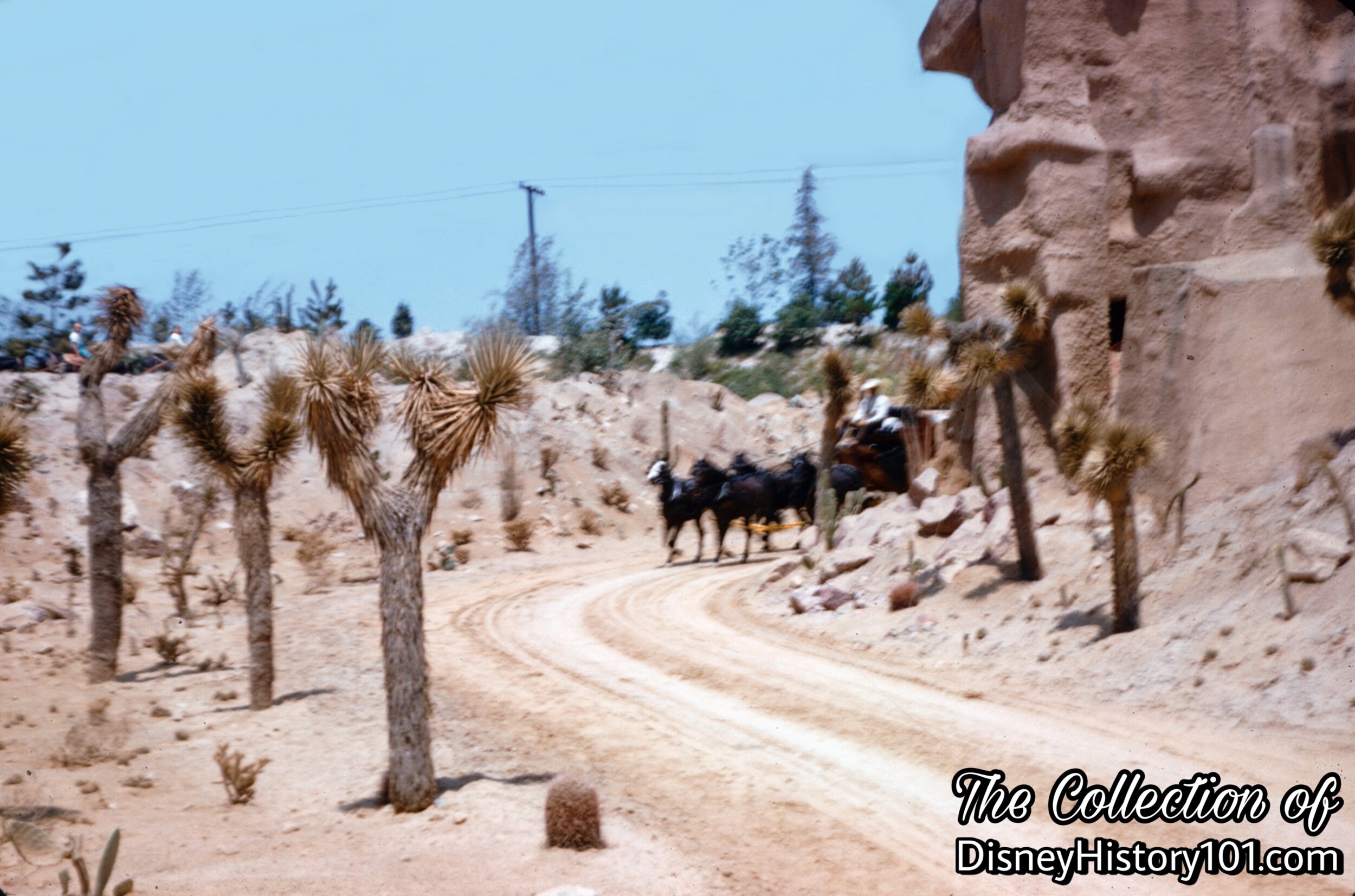
Disneyland Stage Lines Stage Coach in the Painted Desert
The Painted Desert was a true-life living desert of sand dunes and dry soil! Here Joshua Trees (pictured), Sahura trees, cactus, sagebrush, and other brightly colored flora line the dusty roads which the buckboard wagons and Conestoga wagons travel.
Disneyland was encircled by an earth wall called, the ”Berm.” Walt Disney's purpose was to make Disneyland a place separate from the world of today. It was intended that lush foliage screen out even more of the real world from sight. You may have noticed those telegraph lines at the horizon, behind that dirt berm in the background. Eventually those twentieth-century visual intrusions were removed from the sight of this On Stage area.
According to “Ripley’s Legends - pioneers of the Amusement Park Industry” by Tim O’Brien, Volume One: If the environment wasn’t believable, people wouldnt buy into the story. Martin Sklar recalled “one afternoon in Disneyland when he and a photographer drove a cat behind the scenes to Frontierland to take publicity photos. Walt saw what they were doing and was quite dismayed. ‘What are you doing with a car here in 1860?’ Walt queried as he was making a very strong point to both Marty and the photographer. Walt's point was that we had just destroyed the story. There was the Mark Twain (sternwheeler) with all these people aboard out in the wilderness and here we were with an automobile from another age. We had broken the continuity of the story. Visual intrusion is something we are constantly aware of today.”
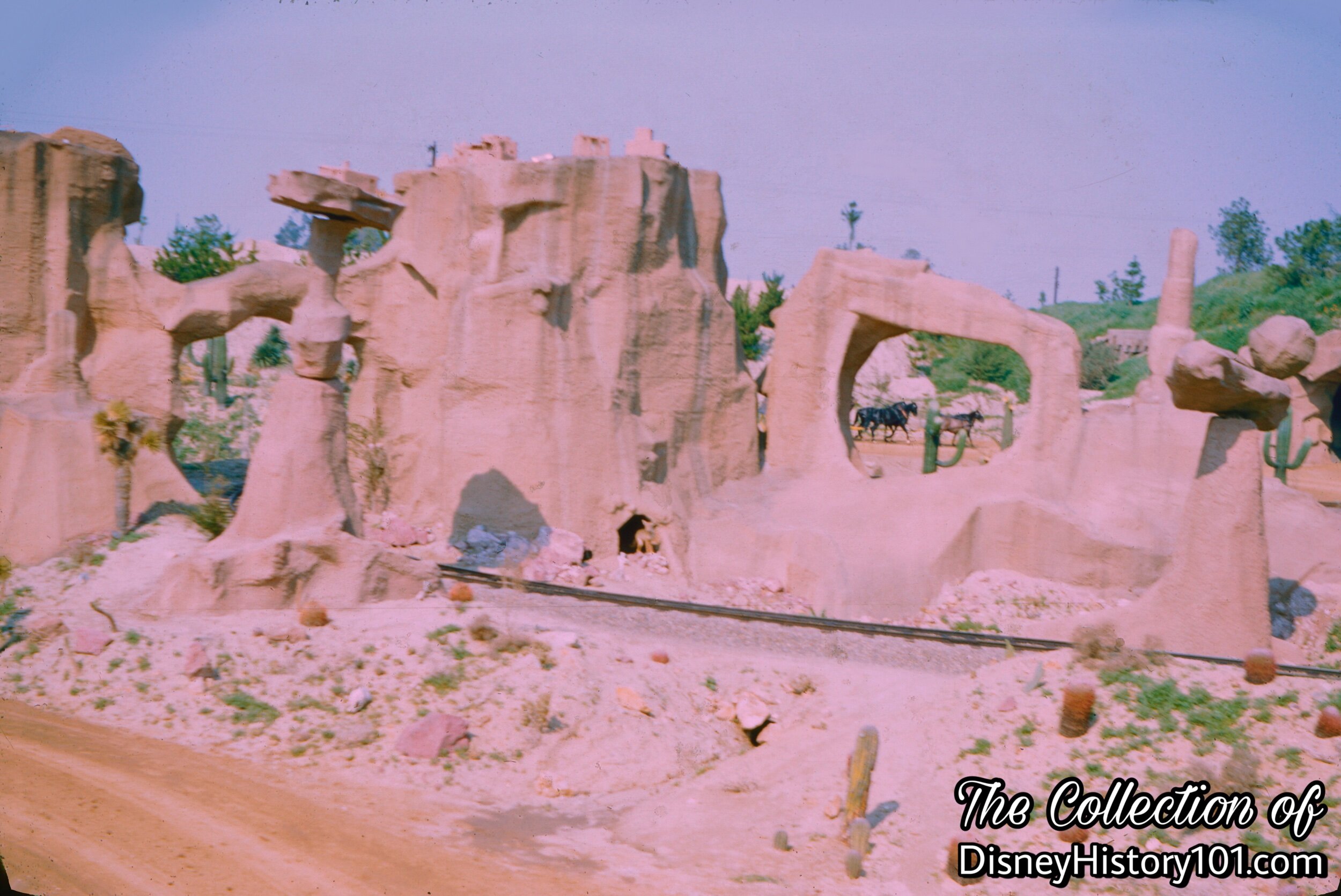
Rainbow Desert, (1956)
Because the drivers of the Disneyland Stage Lines Stage Coaches, Buckboards, and Conestoga Wagons were wise to not travel through Balancing Rock Canyon, passengers received this preview of the hoodoos and arches that await them along a different desert route! Horses and mules are known to be spooked easily, sometimes by wildlife, like bounding Big Horn Sheep (but that’s another tale). It’s best that they keep their distance, because those toppling rocks overhead would (no doubt) have spooked the horses.
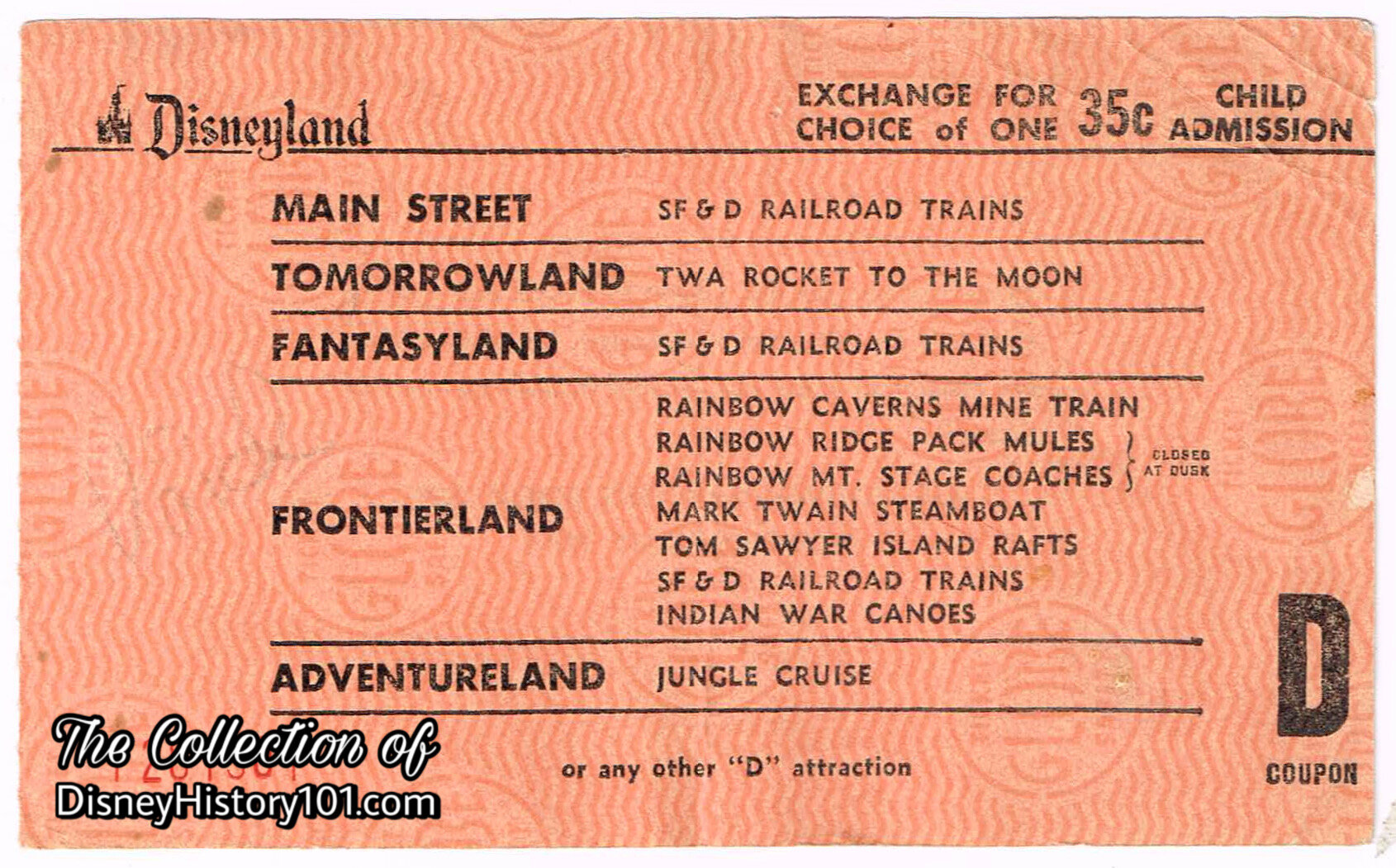
Disneyland Jumbo "D" Coupon 35 Cent Value
Admission for the Rainbow Mountain Stagecoach adventure during 1958, was one “jumbo” “D” coupon (the price of 35 cents, for one child), the same as the Jungle Cruise, Indian War Canoes, or the Tom Sawyer Island Rafts.
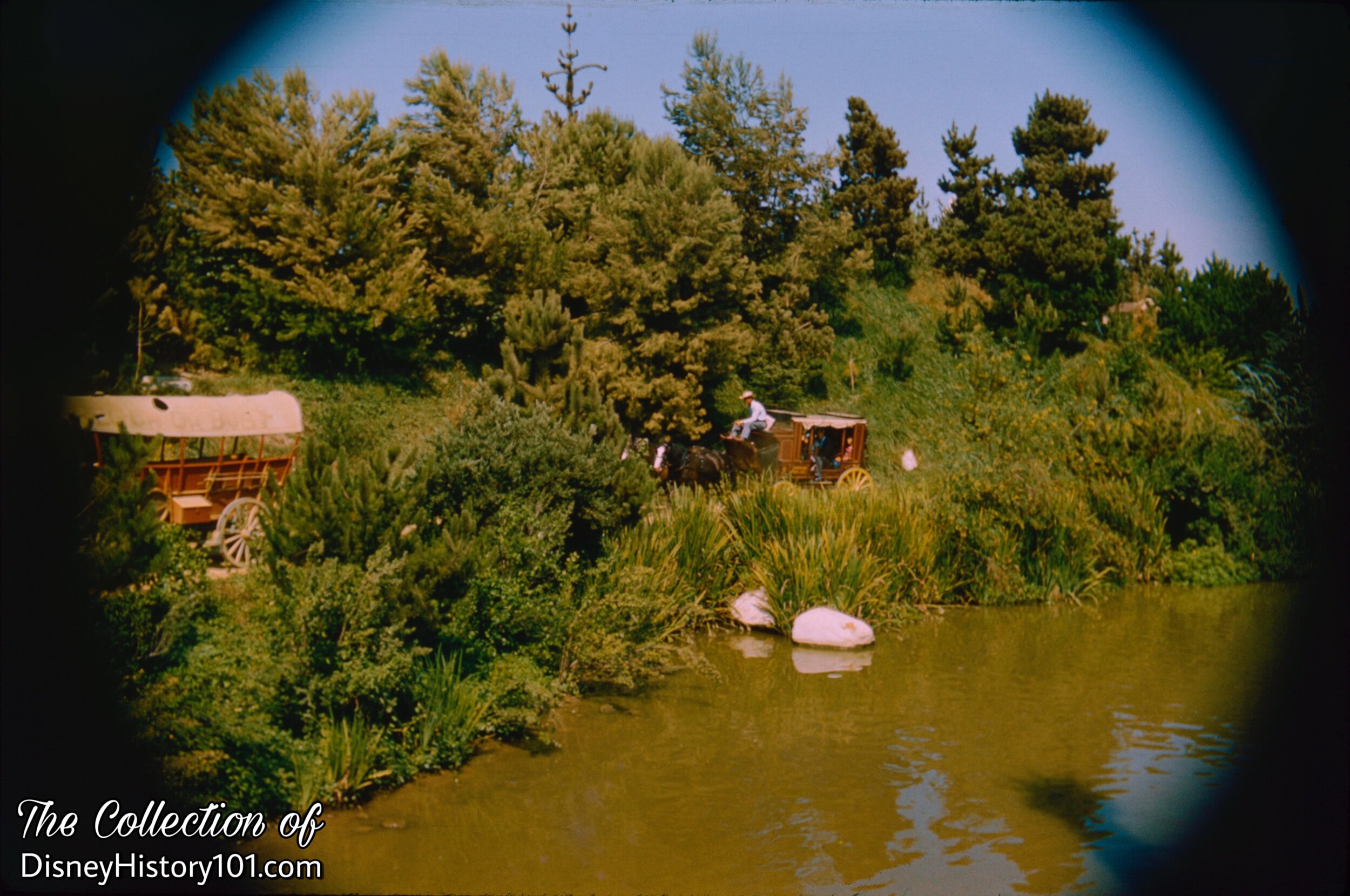
Stagecoach and Conestoga Wagon, (August, 1959)
From Fort Wilderness and Tom and Huck’s Treehouse, we can see the Rainbow Mountain Mud Wagon Coach and another type of vehicle - Covered Conestoga Wagons - that blaze the trails of the Rainbow Desert on the other side of the Rivers of America!

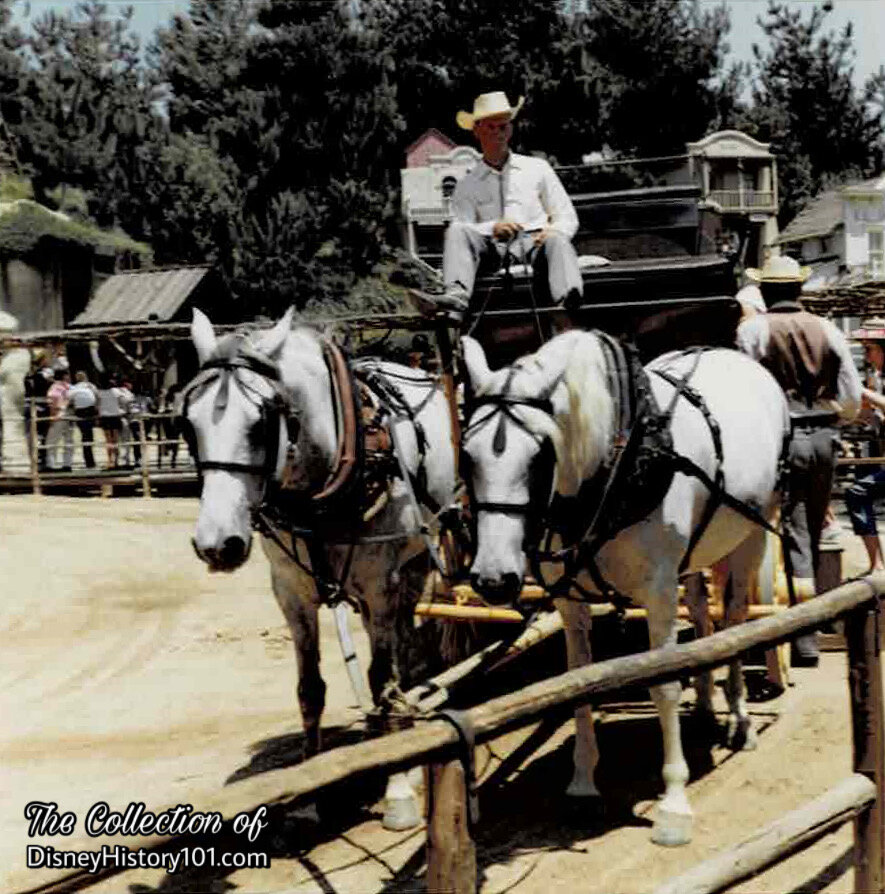
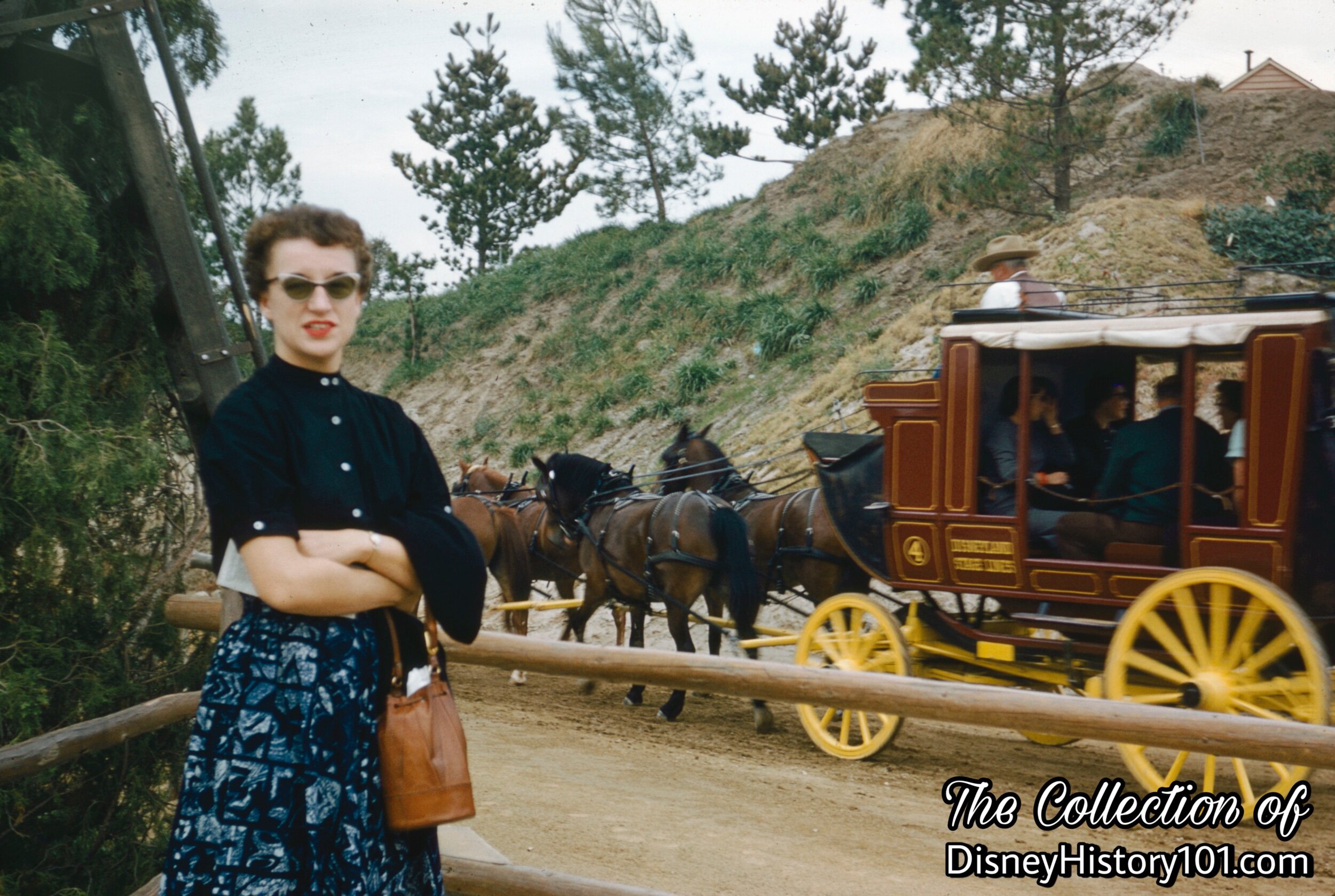
Disneyland Stage Lines "Mud Wagon" #4, (1950s)
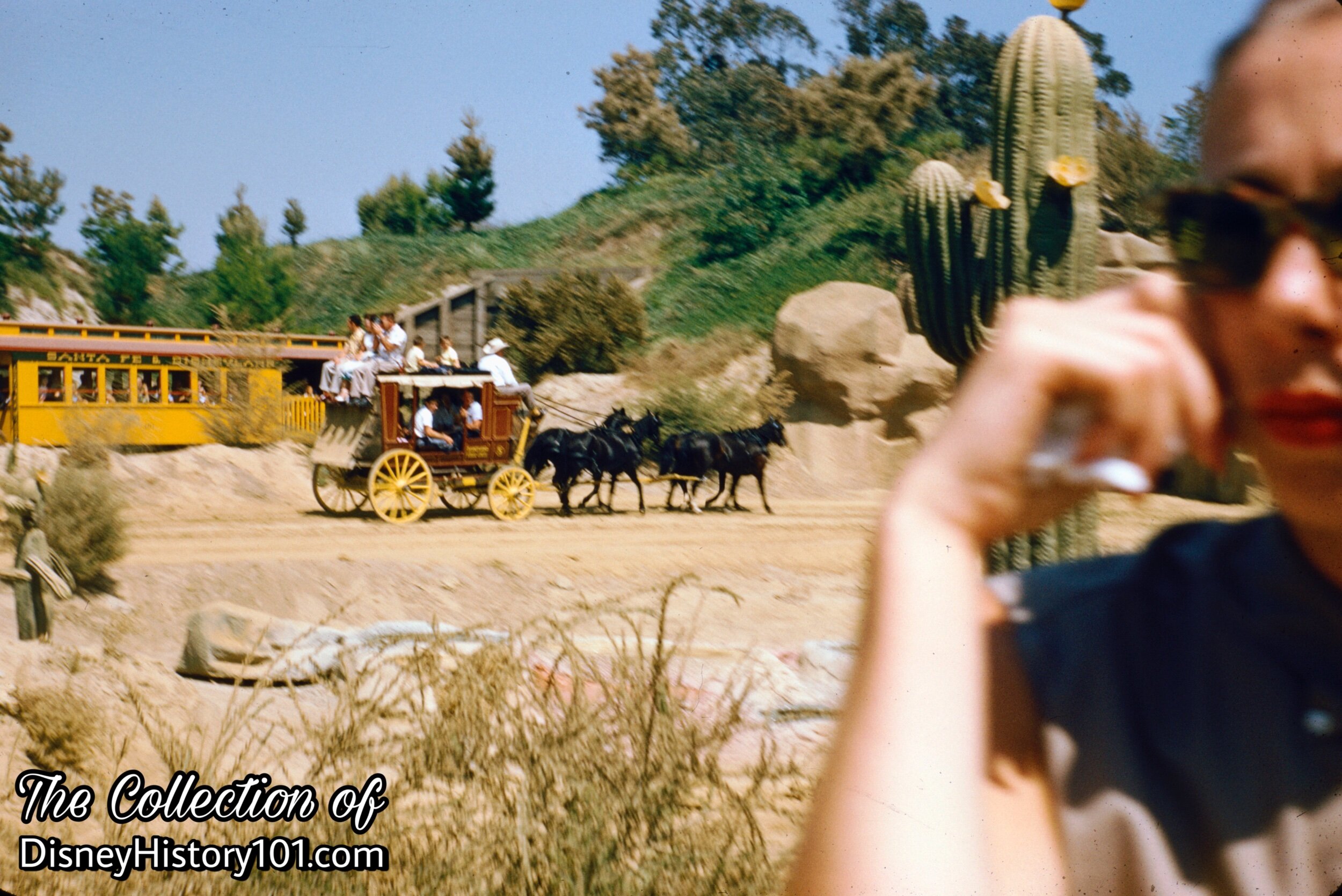
Disneyland Stage Lines Mud Wagon Coach and Santa Fe & Disneyland Railroad Train
The rails of the Santa Fe & Disneyland Railroad also ran through the Rainbow Desert, offering a view of the wonders of the desert, as well as their trafficked roads.

A panorama view of the Stage Coach Ride through the Painted Desert in "13 Panorama Views of The Magic Kingdom," (c. 1959)
One of several wonderful ways to see the Rainbow Desert is immortalized on this souvenir panoramic postcard!
Before they disappeared, the Disneyland Stage Lines Coaches made a couple of appearances on film. One Stage Coach was utilized in filming a scene of Slue Foot Sue, Can-Can Dancers and the Traveling Salesman arriving at the Golden Horseshoe (perhaps on Saturday, October 5, 1957) for the “An Adventure in the Magic Kingdom” episode of Walt Disney’s Disneyland (airing in 1958). Perhaps this is when costume designer Renié Conley crafted costume concepts for the “Disneyland Frontier Land Stage Coach.”
The craftsmanship of the old Disneyland Stage Lines Stage Coaches was just too good, and the Stage Coaches were not disposed of, but brought back to Walt Disney Studios. They were soon featured within the second season “Talent Round Up” Roll Call act of the Mickey Mouse Club television show (featured from 1956 to 1957).
During 1959, one of the Rainbow Mountain Stage Coaches was notably utilized to transport celebrity Richard Eastham (of Tombstone Territory fame) along the route of the “Disneyland ‘59” pageant and parade! A few months later, the Rainbow Mountain Stage Coaches took their last excursion through the Rainbow Desert, and then closed on September 13th, 1959. By this date, a grand total of 1,350,589 guests had the privilege of riding aboard one of Disneyland’s Concord Stagecoaches!

(August 16, 1955 - June 14, 1959)
A covered wagon appeared in the Press Preview Day Parade. Frank Pfannenstiel recalled “the covered wagon going down Main Street on Opening Day, with Fess Parker and the governor of Tennessee.”
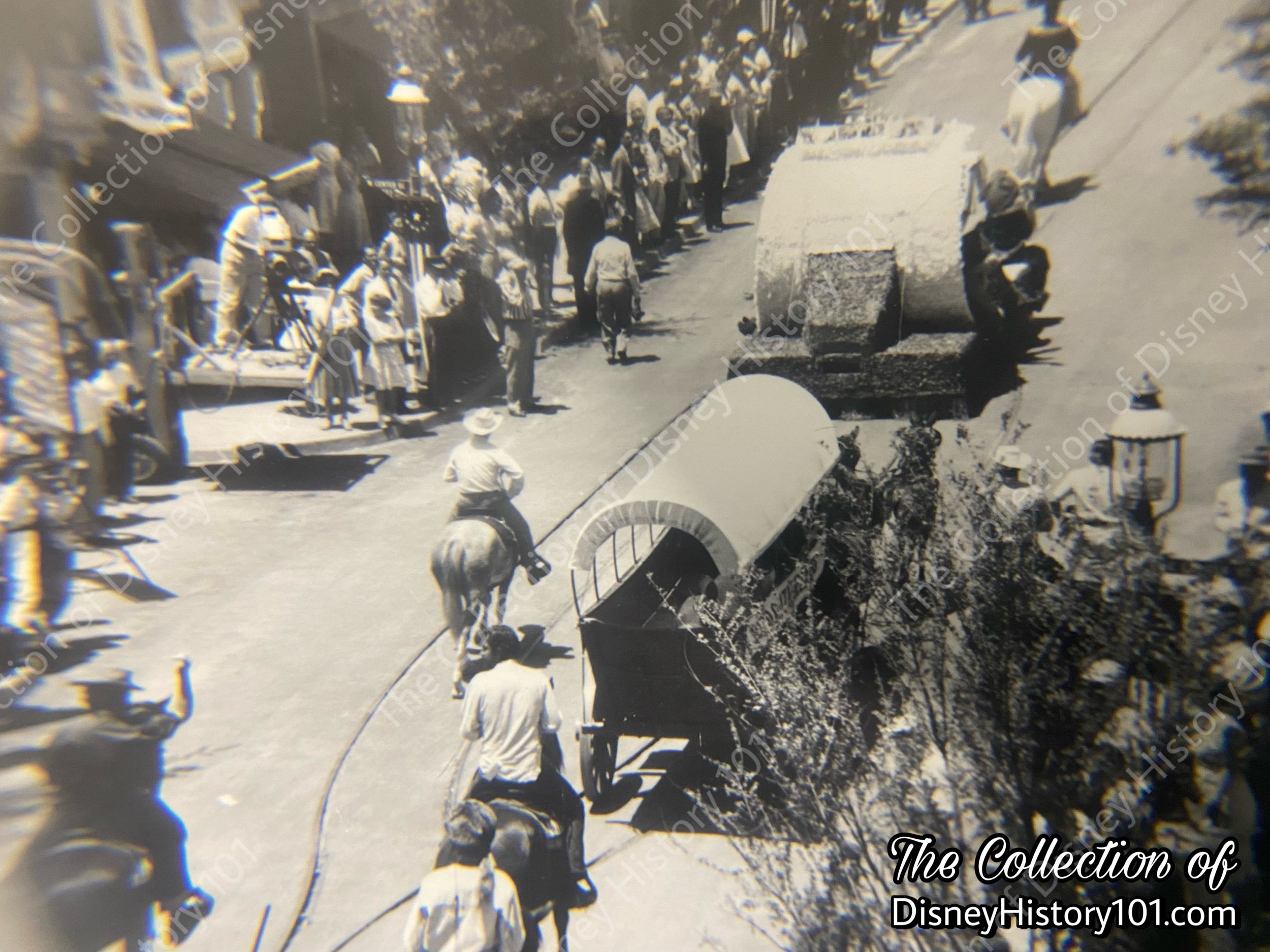
Very soon, “to provide transportation throughout Disneyland, the almost forgotten art of wagon making was revived. We built Conestoga Wagons…,” according to the narrator of “Disneyland - The Park,” a Disneyland anthology series episode (first aired 1957) which briefly preserves the construction of the Conestoga wagons. After Walt Disney Productions’ Westward Ho the Wagons! “wrapped” production (and was released during December of 1956), some props were utilized in the Disneyland Indian Village. “Cross-pollinations” (between Walt Disney’s studio and Disneyland) were commonplace during the 1950s and 1960s. Free exhibits in Tomorrowland and Main Street Opera House would feature props and sets of Walt Disney Productions’ feature length films (like, “20,000 Leagues Under the Sea” and “Babes in Toyland”) and Walt Disney’s Mickey Mouse Club television variety show. As for the Conestoga Wagons featured in the production of “Westward Ho!,” some were redecorated to match the theme of the feature film, reading “Westward Ho!” and “Oregon or Bust!” on the cover.
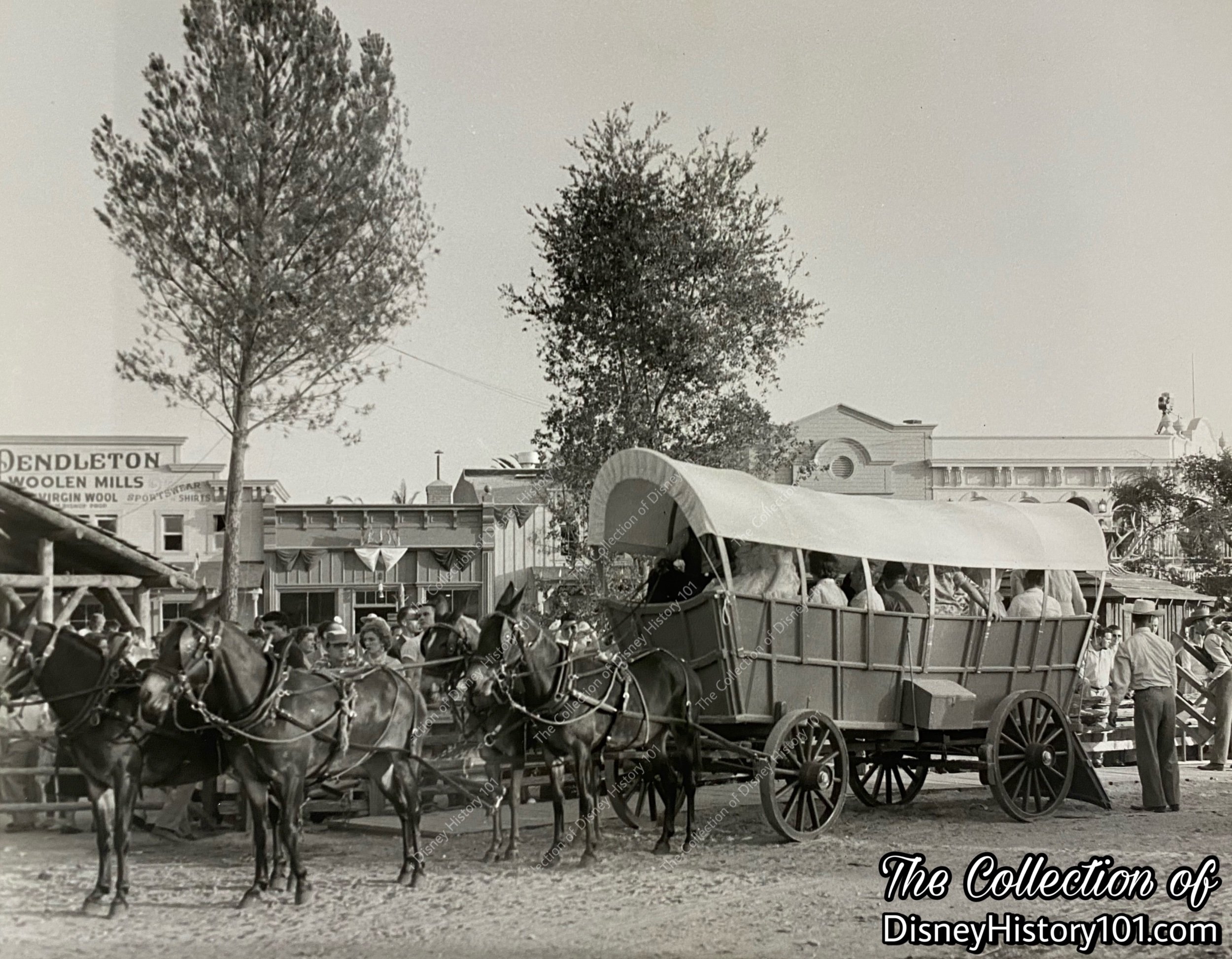
A Conestoga Wagon; ©️Walt Disney Productions.
To pull these 5/8-scale vehicles along desert dusty road, over bridge, and across ford also required the breeding of specially-bred scaled-down equine. Some of these mules (of the Backstage Pony Farm) are briefly preserved on film, in “Disneyland - The Park,” a Disneyland anthology television series short film (originally aired in 1957). According to a “Nomenclature List” (updated May 25, 1955), there were “2 wagons and [sic.] a six mule hitch per wagon.” Both of these Conestoga Wagons officially enter the Frontierland Stockade during the live ABC Broadcast on July 17th, 1955.
![Now (a month after Disneyland’s first day of operation), “ Along [Frontierland’s own stretch of the] Oregon Trail” , the “wringle, wrangle, jinggy, jong, jangle” of the Conestoga Wagons ’ mighty fine equine (and their gear) were heard from August](https://images.squarespace-cdn.com/content/v1/5b3d7f804eddec6e826be0c9/1685204676011-9JHNZI48KVDJ7WN893KY/DAC3A0D0-9C62-4B79-B060-409BC87033D9.jpeg)
Now (a month after Disneyland’s first day of operation), “Along [Frontierland’s own stretch of the] Oregon Trail”, the “wringle, wrangle, jinggy, jong, jangle” of the Conestoga Wagons’ mighty fine equine (and their gear) were heard from August 16, 1955 to June 14, 1959. In these new vehicles, passengers were put in the middle of another true-life adventure - an alternate experience of the Painted Desert attraction in Frontierland, and a better understanding of how some early Americans moved west!
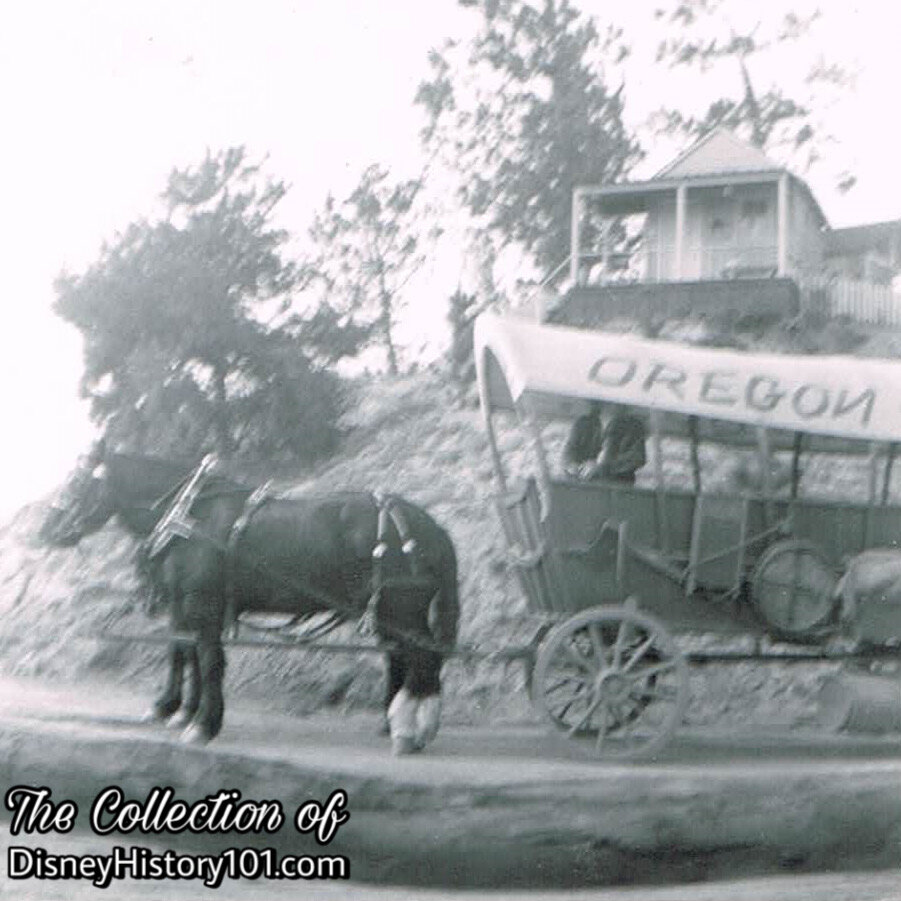
“Oregon or Bust” Conestoga Wagon & Horses at Rainbow Ridge
We’ll depart the false-fronted store buildings and hitching rails of the town for a trek out west!
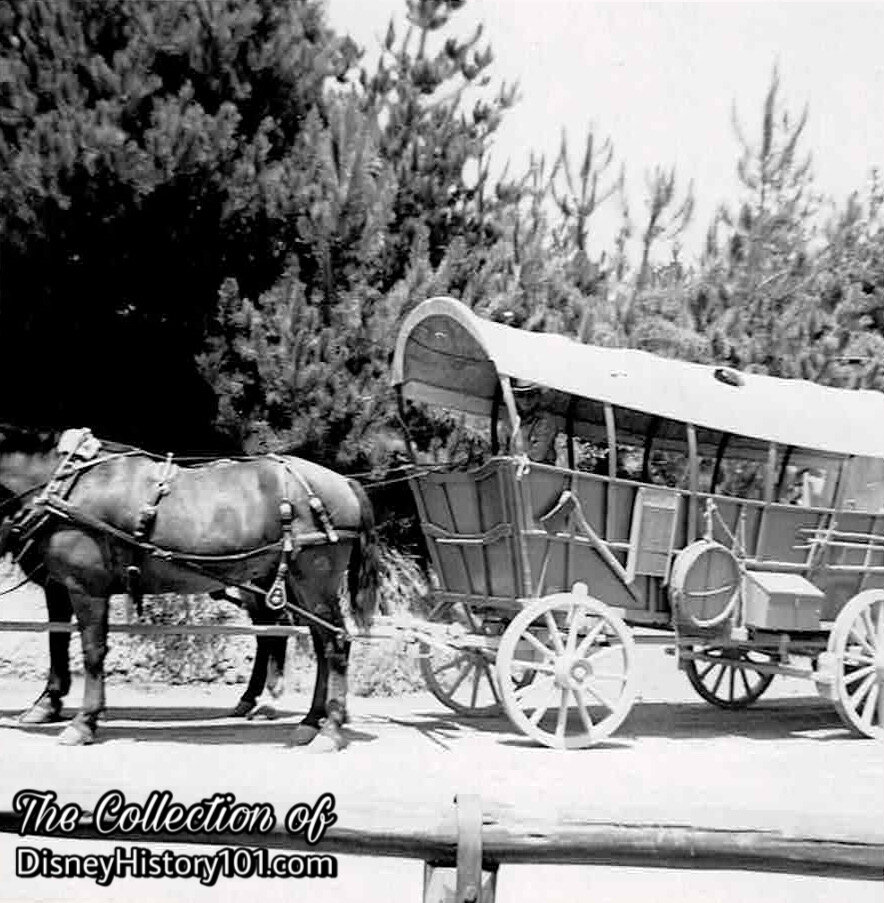
Conestoga Wagon & Horses
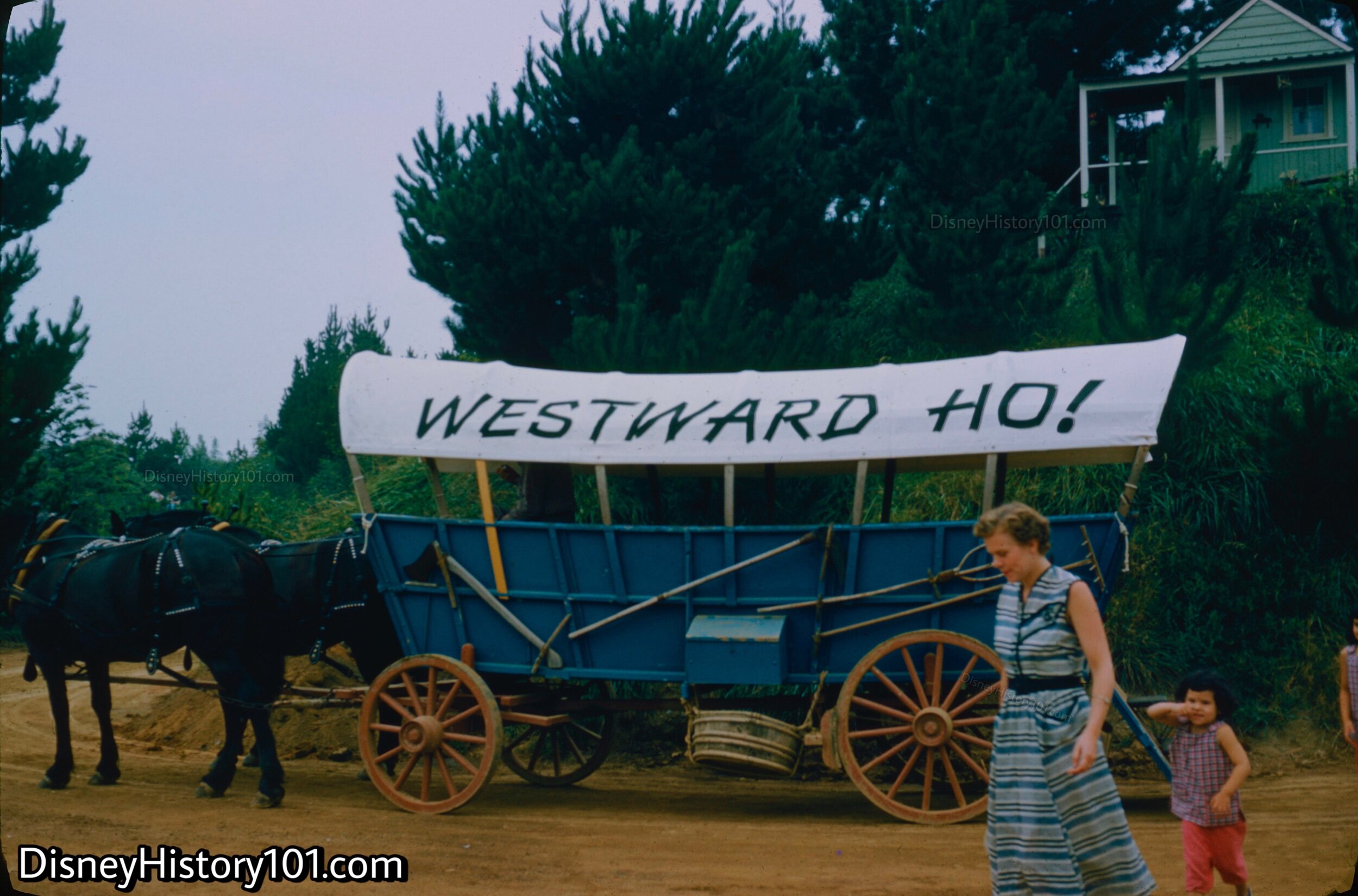
“Westward Ho!” Conestoga Wagon at Rainbow Ridge, (Late 1950s)

Once upon a time, Mule Packs, Conestoga Wagons, and Stagecoaches transported guests through the Rainbow Desert.
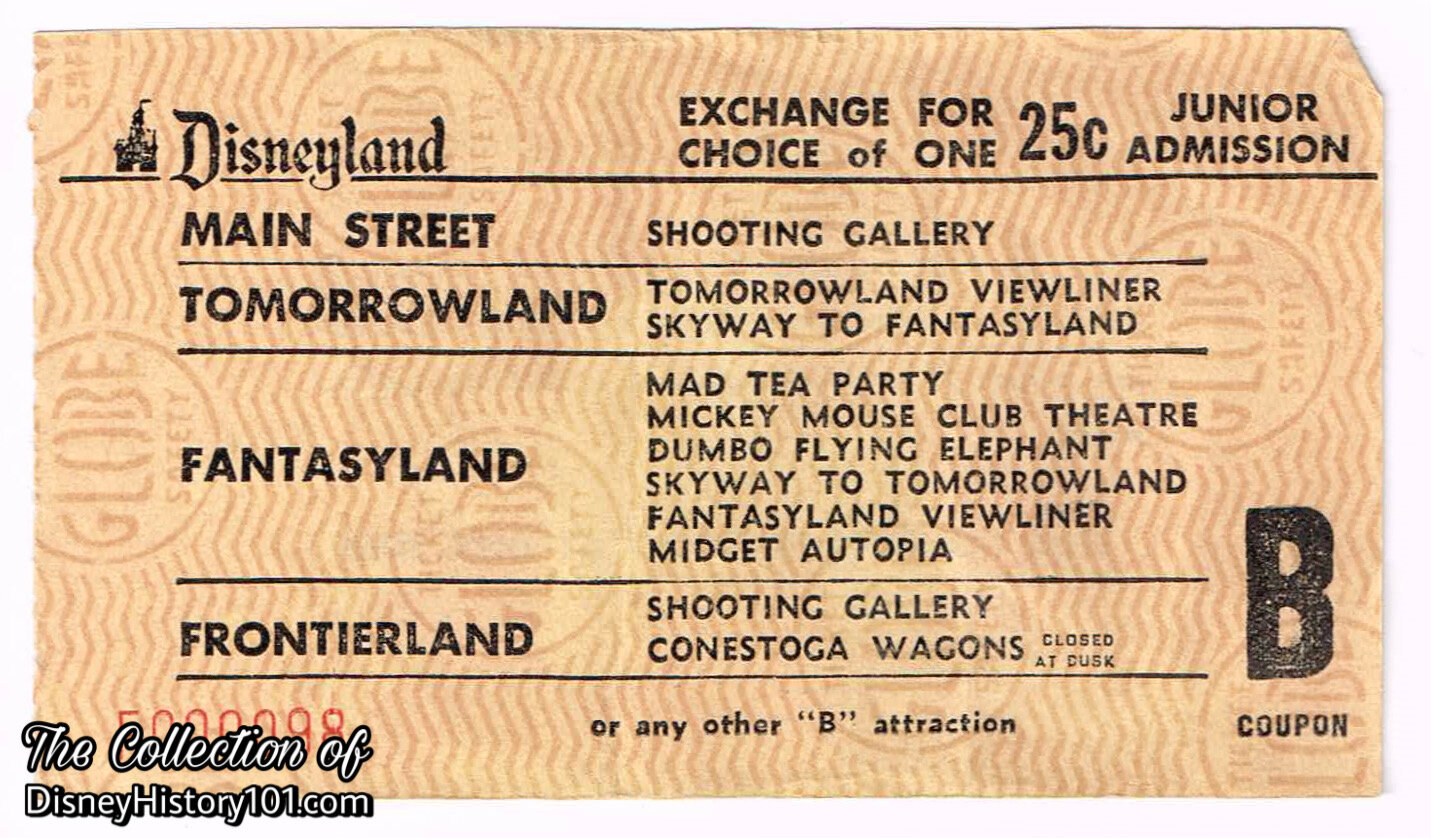
Disneyland "B" Junior Admission Coupon, (June, 1957 - August 15, 1958)
The original cost of passage through the desert aboard one of the Conestoga Wagons was one “B” Coupon (or, 25 cents).
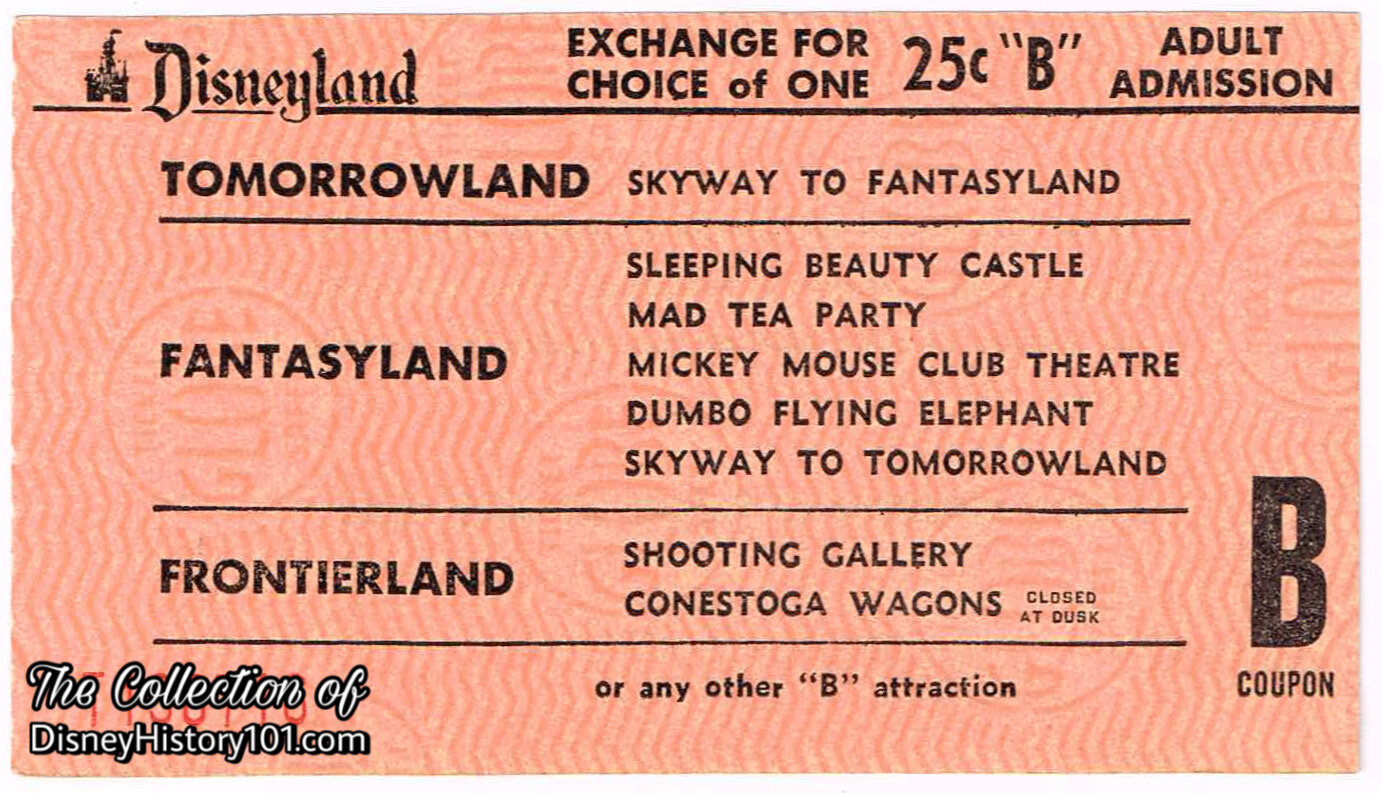
Disneyland "B" Adult Admission Coupon
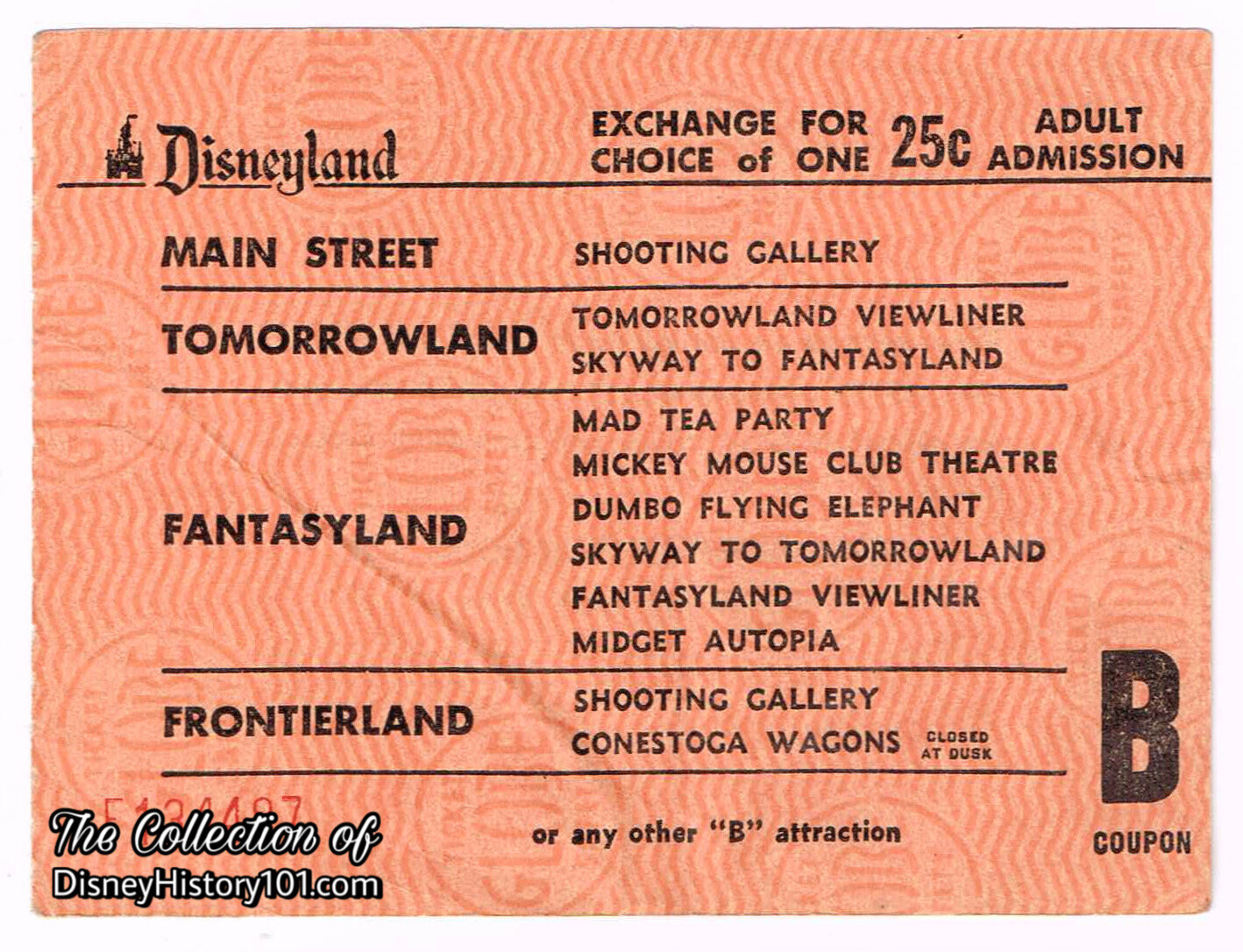
Disneyland "B" Adult Admission Coupon, (June, 1957 - August 15, 1958)
Admission for the Conestoga Wagons (during 1957) was one “jumbo” “B” coupon (or, 25 cents, for one adult), the same as a round of ammunition in the Main Street Shooting Gallery, entry into the Mickey Mouse Club Theater, or a ride aboard the Fantasyland Viewliner or Tomorrowland Viewliner!
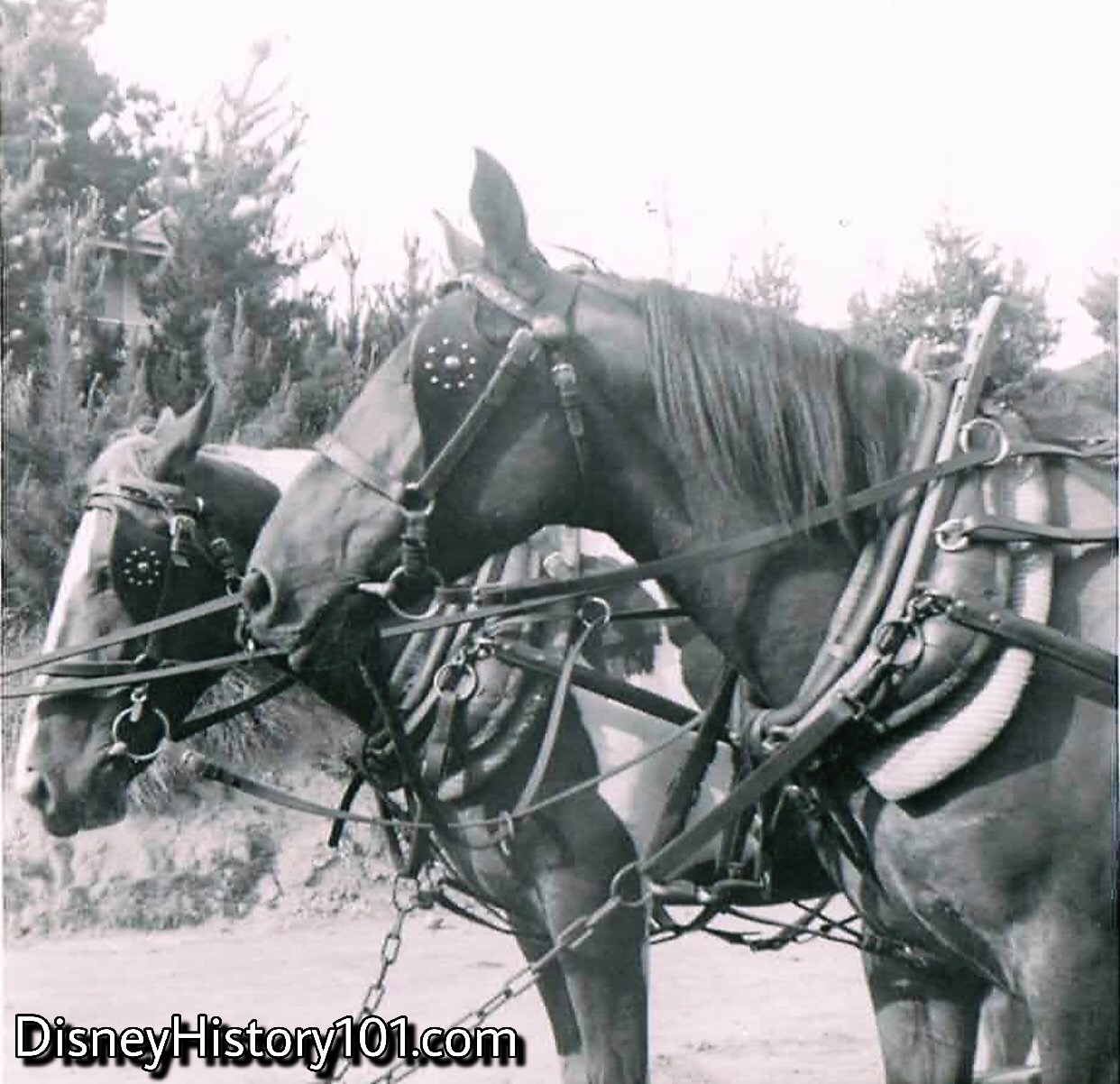
Disneyland Horses
Before we step aboard we take a look at our faithful horses that are hitched to one of the Conestoga Wagons (those old “Prairie Schooners”). We’re mighty careful not to spook the horses, as we note the beautifully hand-crafted tack (brow bands, bridles, collars, and other harness parts) which were created under the direction of Owen Pope, and will generate the “wringle” and “wrangle” as the horses head down the dirt road.
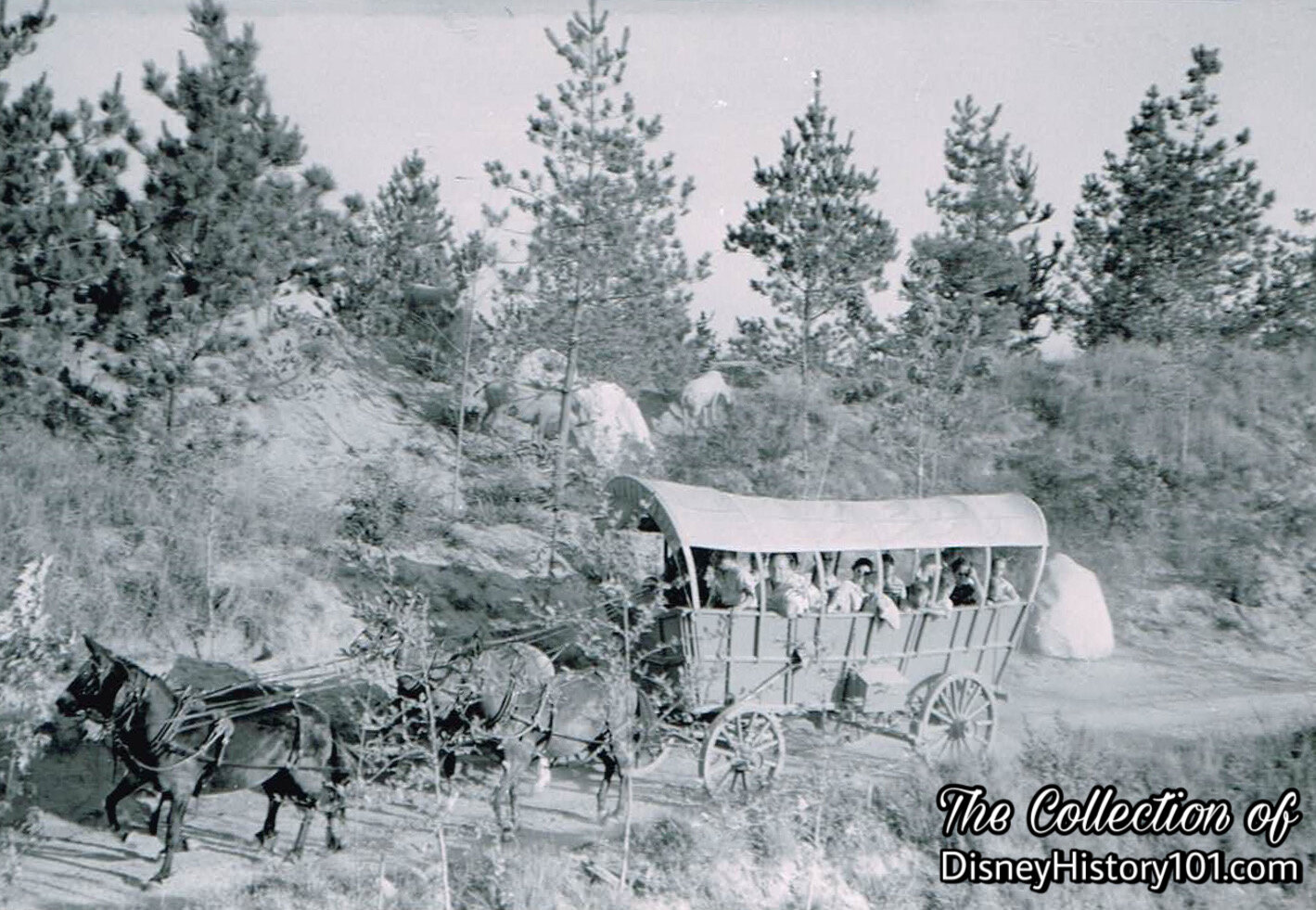
Conestoga Wagon, (May, 1957)
In the hills, “children of the covered wagon” pass pines, oaks, and olive trees.

Conestoga Wagon Along the Rivers of America
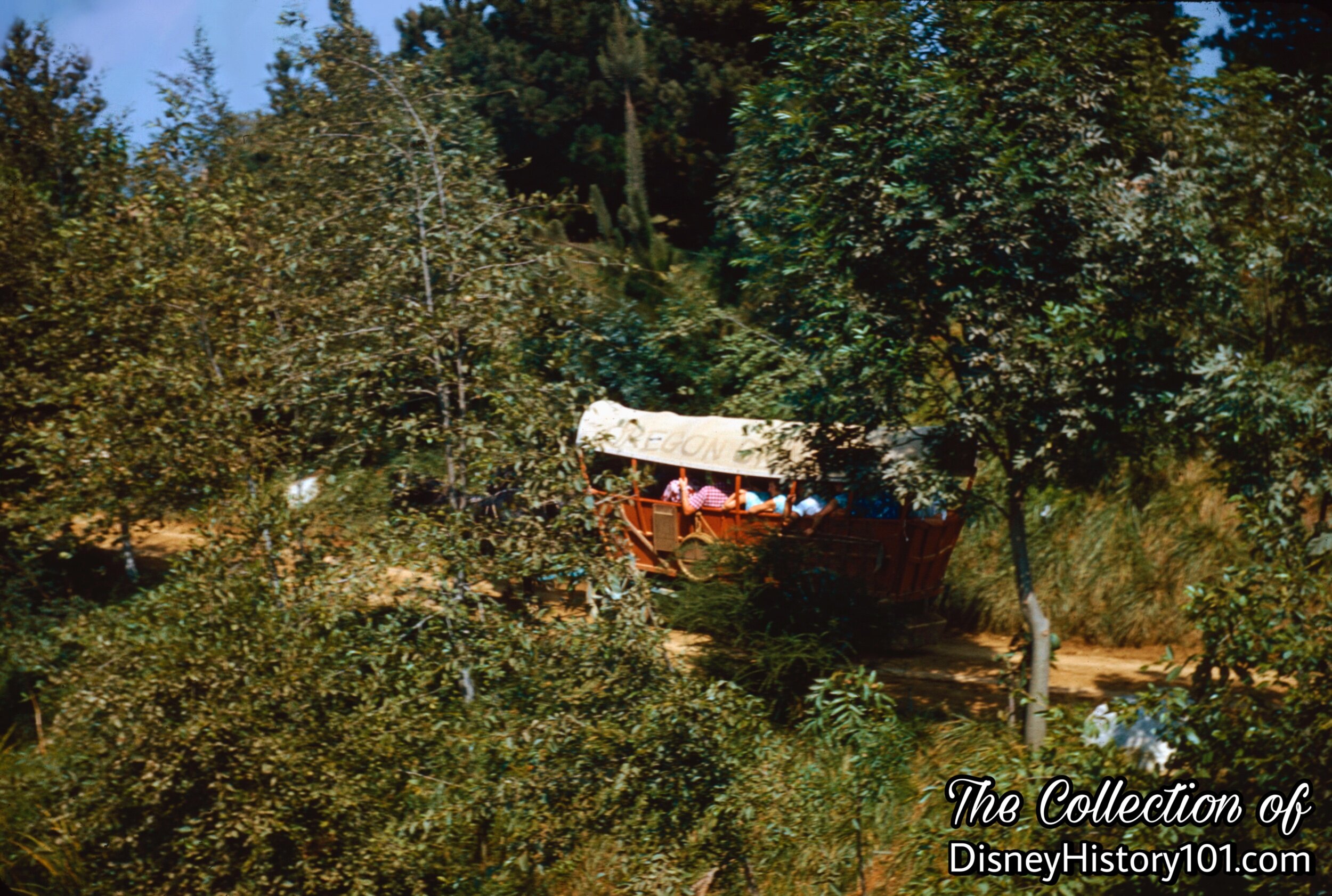
Conestoga Wagon, (August, 1966)
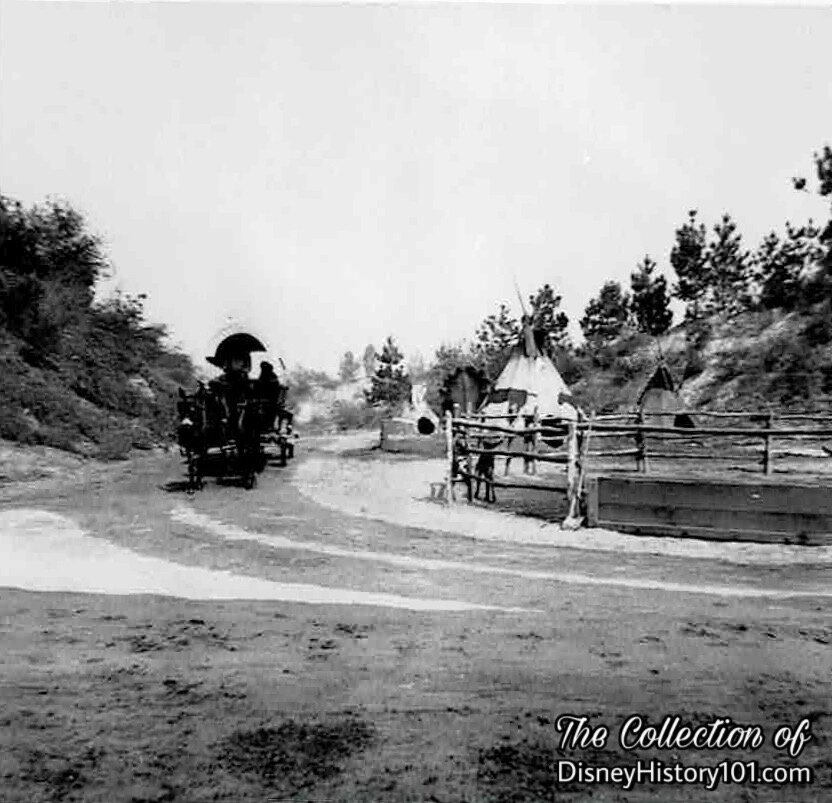
Conestoga Wagon Passes One of the Indian Camps Along the Desert Trail
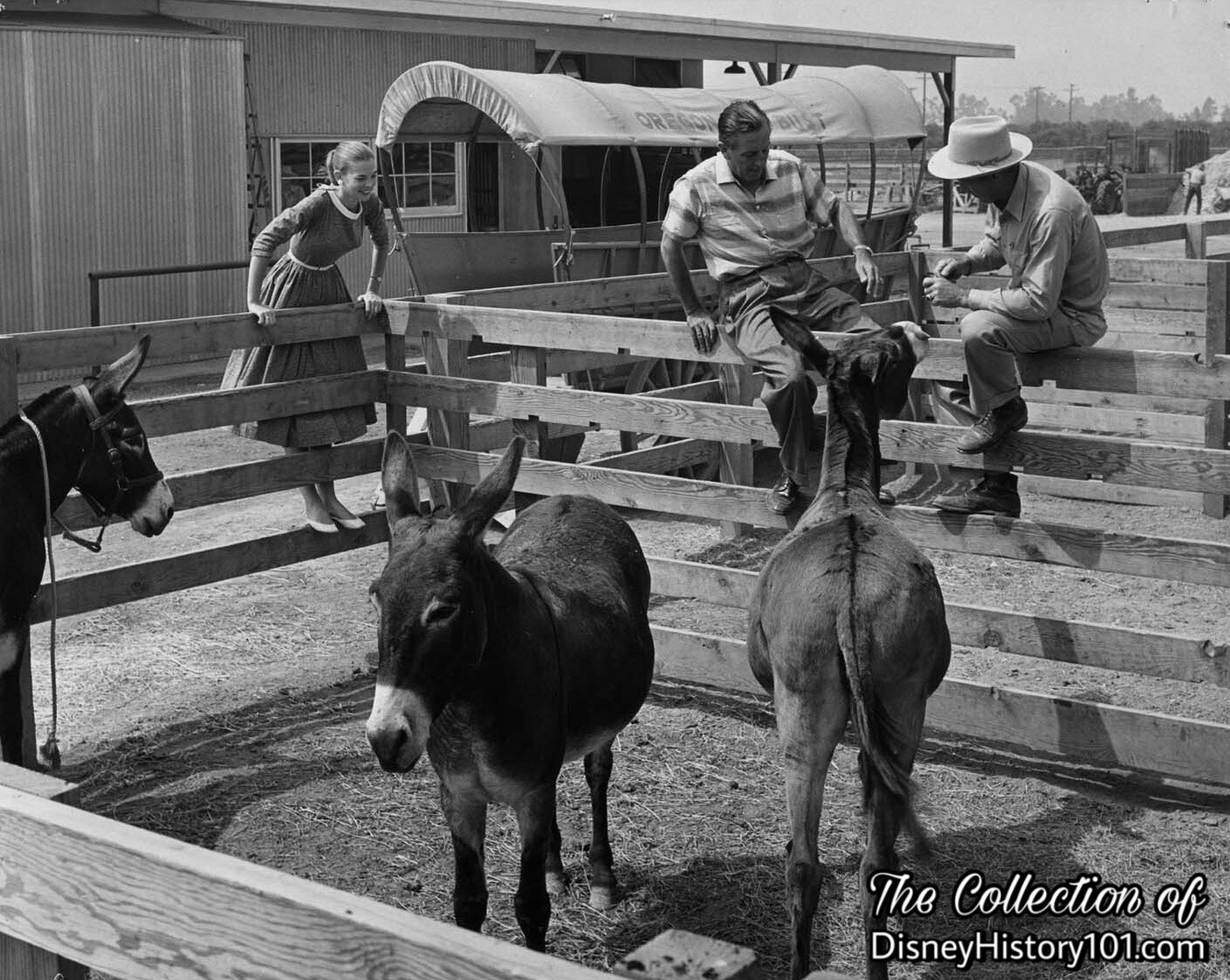
A Disneyland Conestoga Wagon, Sharon, Walt and Owen Pope on the Pony Farm Feed Yards, (c.1957)
You’ll recall that Owen cared for both the animals and the equestrian equipment on the 10-acre Pony Farm, in Backstage Disneyland. Note one of the Conestoga Wagons on the service road behind the Mule corral. “55er” Day Sechler recalled: “At Disneyland, … Walt [sic] came to the Pony Farm a lot to watch us break horses. He was always concerned if he could do anything for you.”
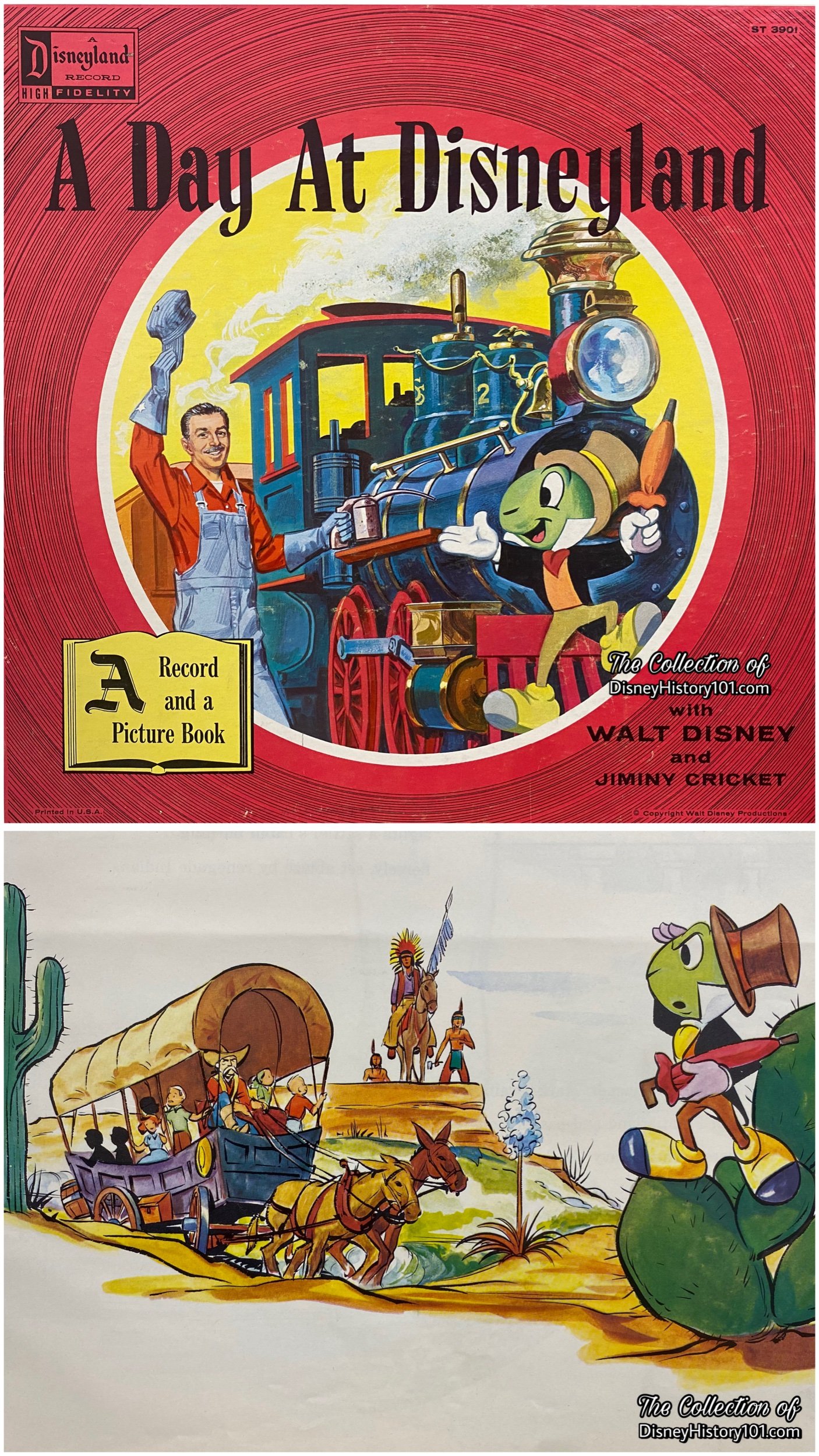
A few Children of the Covered Wagon depicted on A Day at Disneyland; 1957 Walt Disney Productions Printed in U.S.A.
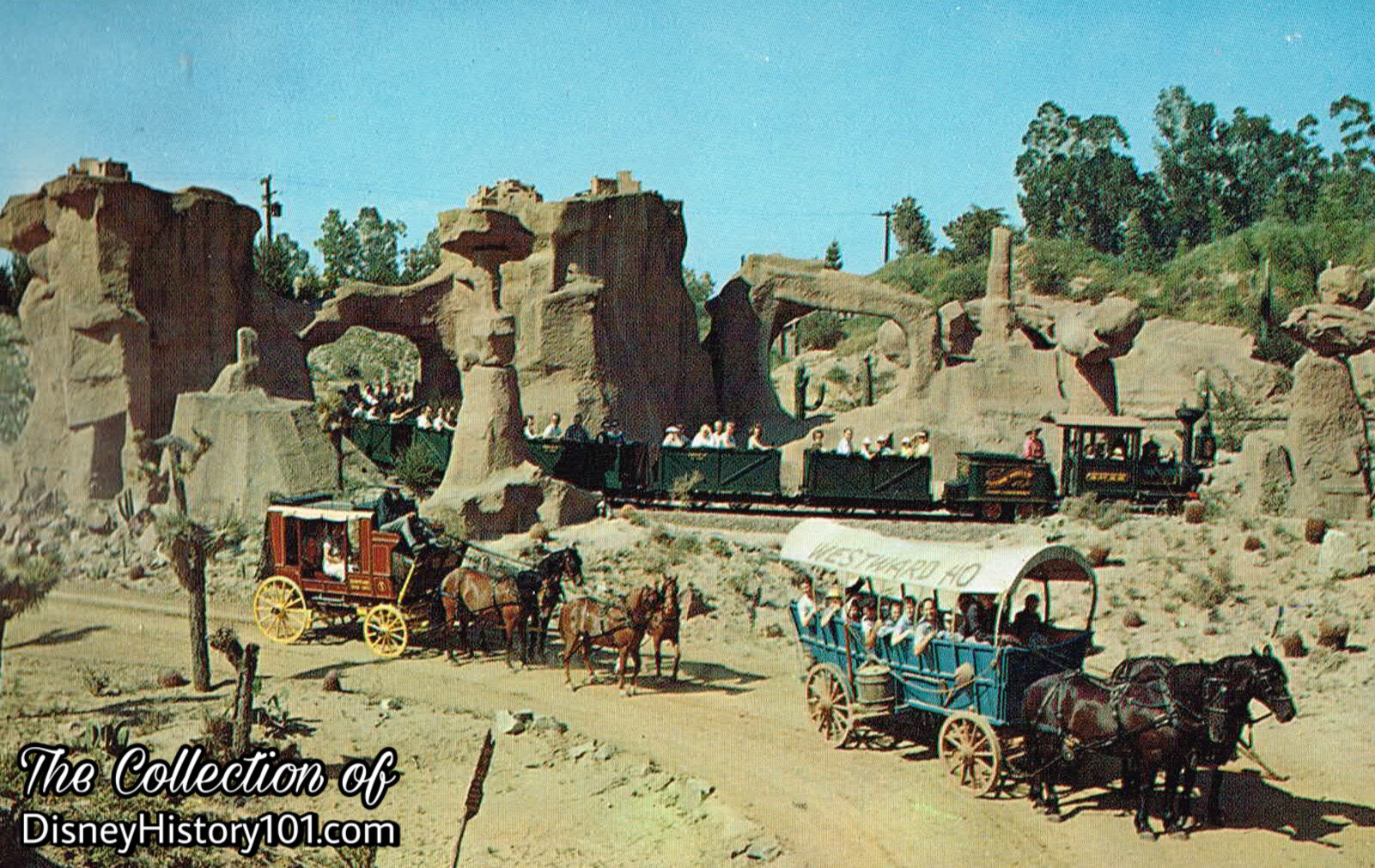
Painted Desert Postcard Image
This rare Disneyland Postcard features a rare sight one of the Rainbow Ridge Mud Wagons, a Conestoga Wagon, and one of the Rainbow Mountain Mining & Exploration Co. trains! Art would soon imitate life, when the more archaic forms of desert transportation would make way for the steam-powered future! For now though, engineers of those engines were mighty careful about their whistle-blowing, so as to prevent spooking the equine that pulled the horse-drawn vehicles.
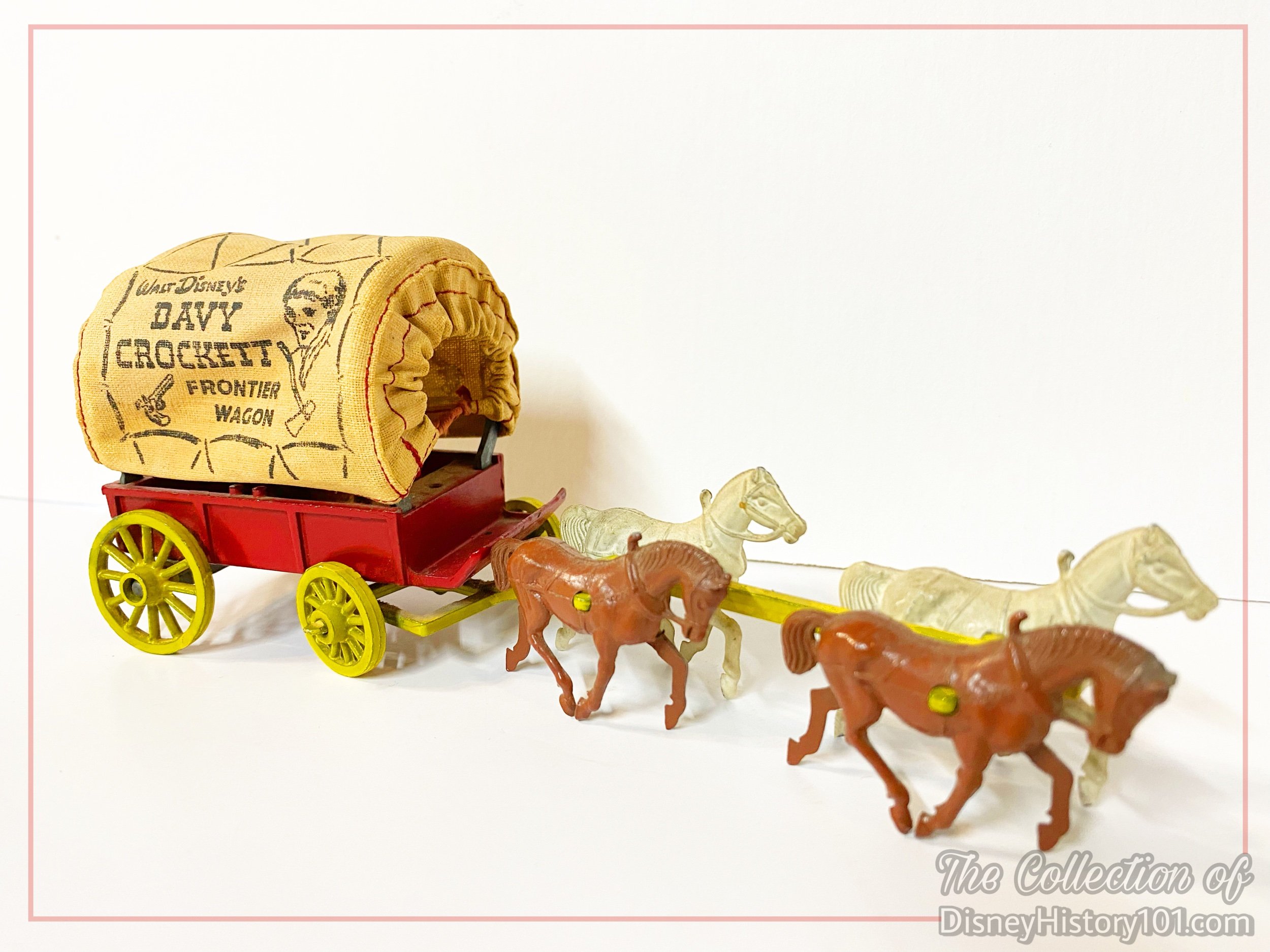
A c.1956 Walt Disney’s Davy Crockett Frontier Wagon by Morestone.
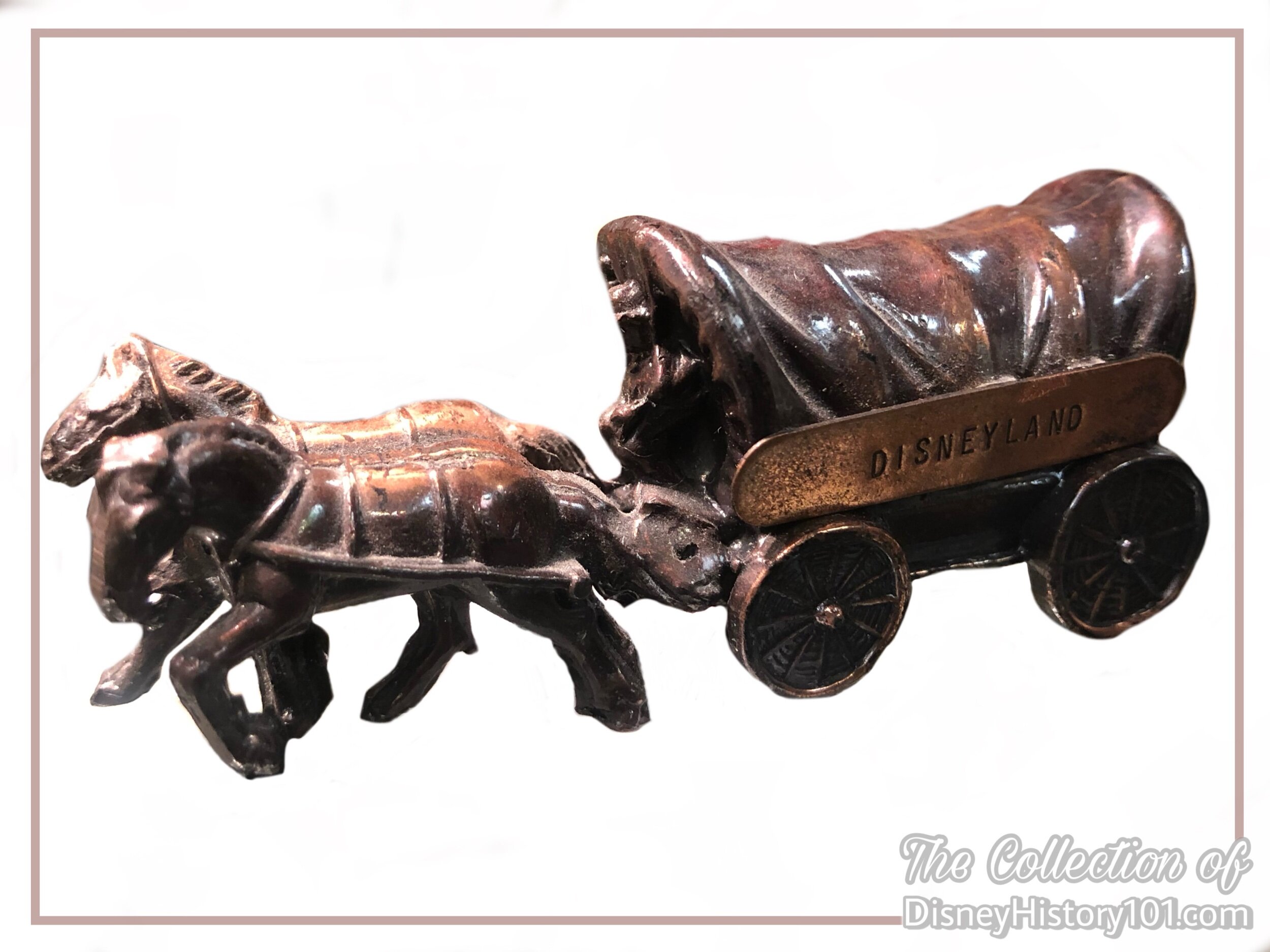
Disneyland Conestoga Wagon Souvenir
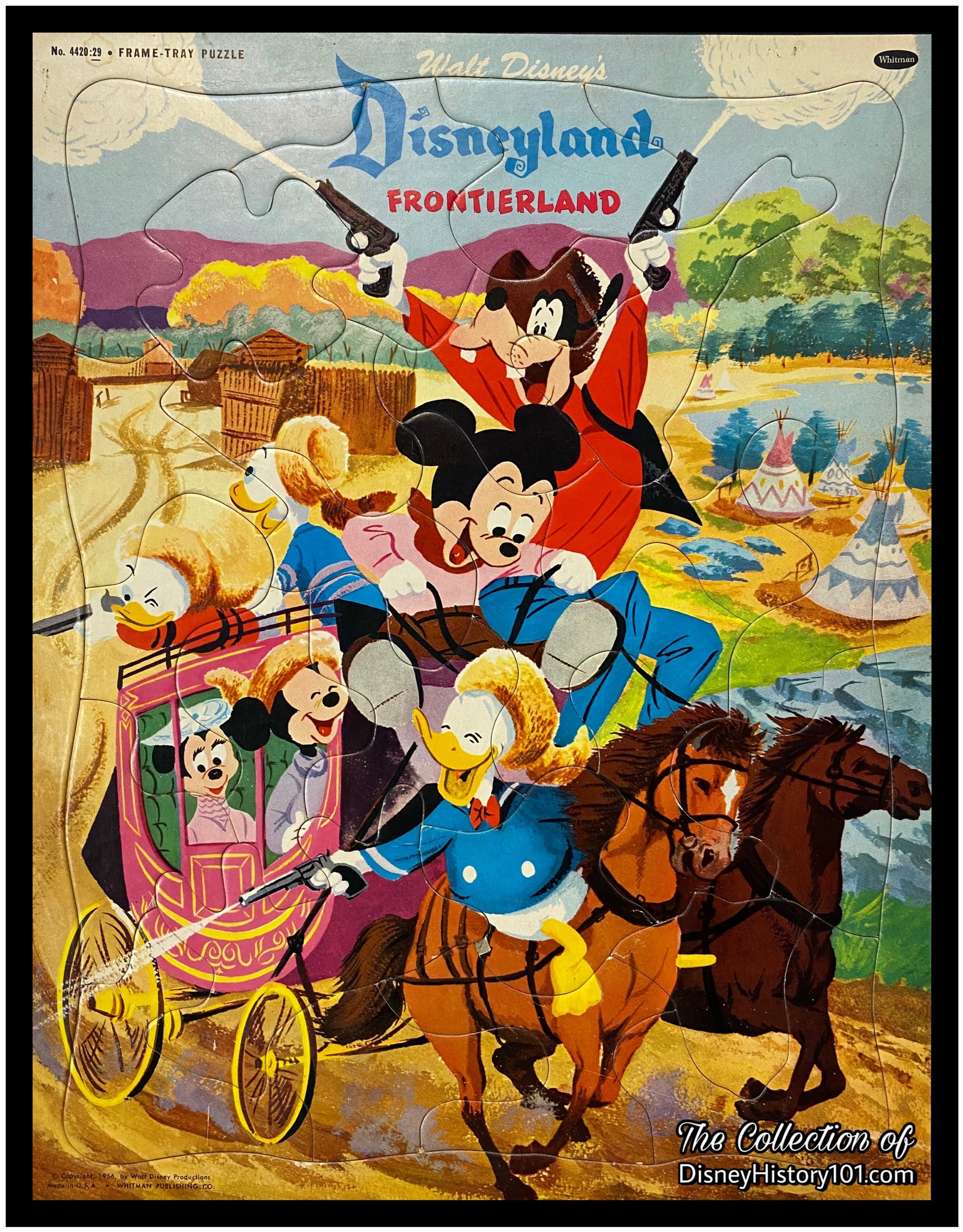
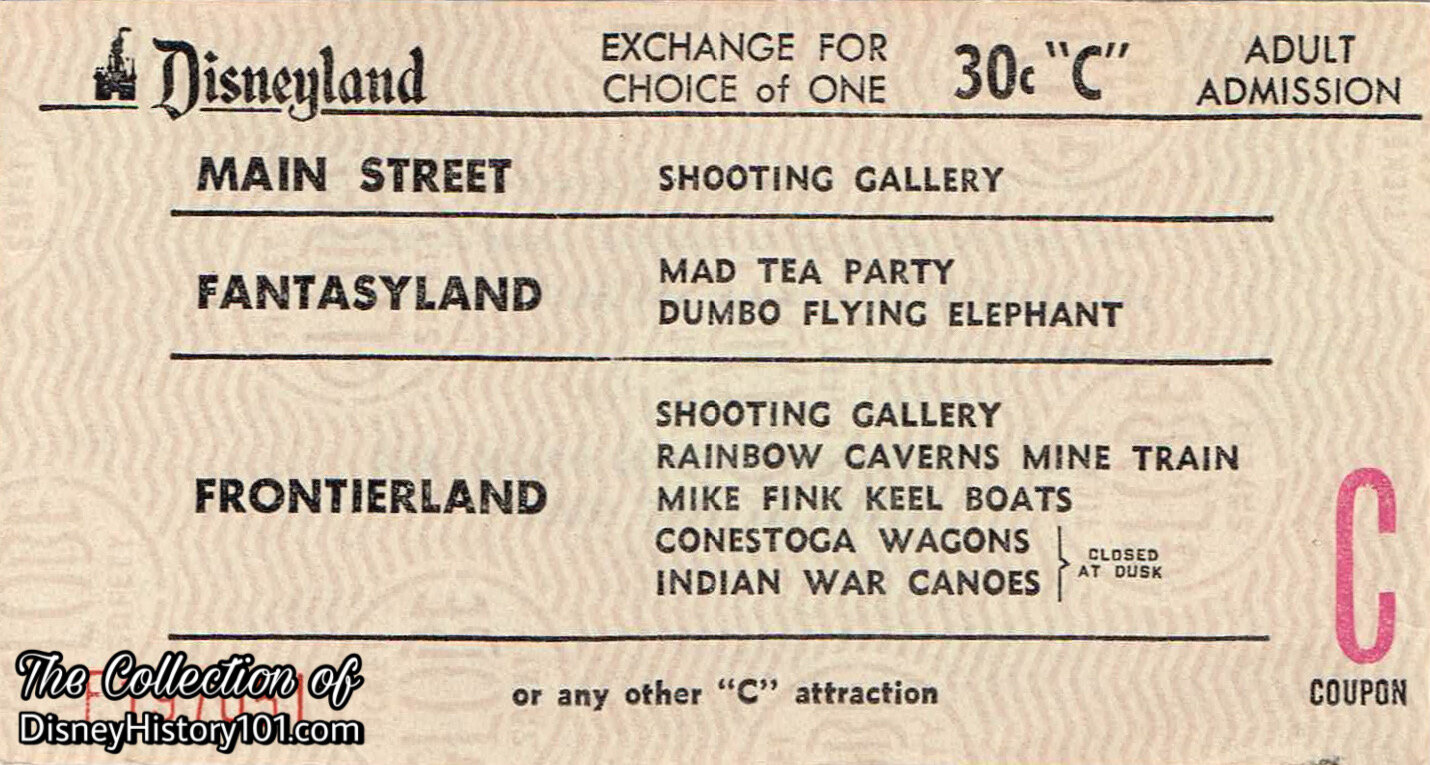
Disneyland "C" Coupon, (Late 1958 - 1960)
By 1959, Joe Fowler was Vice President of Disneyland Operations Committee and Doc Lemmon of Disneyland Operations was overseeing Operators of Rides & Amusements (like the Conestoga Wagon and Rainbow Mountain Mud Wagon Coaches), Livestock, Parking Lot, and Ticket Sellers. By that time, Disneyland Admission media “C” Coupons (above) equated the value of a ride aboard the Rainbow Caverns Mine Train with the alternate desert route of the Conestoga Wagons.
“Incidents & Liability”
Owing to incidents, by September of 1958, Disneyland, Inc. had a liability - a Public Liability and Property Damage Insurance Policy valued at $ $80,250 (according to an appraisal by Bank of America). By 1959, Disneyland, Inc. had many more types of insurance policies. Disneyland, Inc. had “liability property damage” at coverage of $500,000 per person and $2,000,000 per incident, $500,000 on property and $2,000,000 on aggregate products, at an annual premium of $165,957. Disneyland, Inc. had also increased its “multiple perils” insurance policy coverage twice; from a coverage of $6,000,000 for 5 years, increased by 3,700,000 for 4 years, and increased by 490,000 for 3 years. After all, the policy had a coverage of $10,190,000 at an annual premium of $9,717. Despite the coverage, incidents would occur that would result in the end of an era for the Disneyland stage coach and its route!
Milo Rainey recalled: “Sometimes runaways would be caused by ducks flying across the river.” Day Sechler recalled: “We were loadin' a stage coach one time when we looked up and people were hollerin' and yellin' from the MARK TWAIN, pointin' at a stage coach with four ponies on the dead run- and NO DRIVER! They ran into a coach that was loading and turned it clear over on its side - with JIM LINDSEY UNDERNEATH!”
Day Sechler also recalled: “Another time, a coach turned over with 17 people when a shot of steam from the train scared the ponies at Rainbow Bridge. A safety device released the coach from the front wheels. It sure was a sight to see the ponies come racing home draggin' only the 2 front wheels!”
According to a related newspaper headline (published just after the latter incident), “Eleven [were] injured as horses bolted at Disneyland.” The same article continues : “Eleven persons including six children, suffered minor injuries Monday at Disneyland when the four-horse team of a stagecoach bolted. The injured were the driver and 10 of the 12 passengers in the stagecoach at the amusement park. Several were thrown to the ground when the stagecoach collapsed after its undercarriage was torn off by the wild horses. A Disneyland spokesman said the horses became frightened at the sound of the Park’s train whistle.”
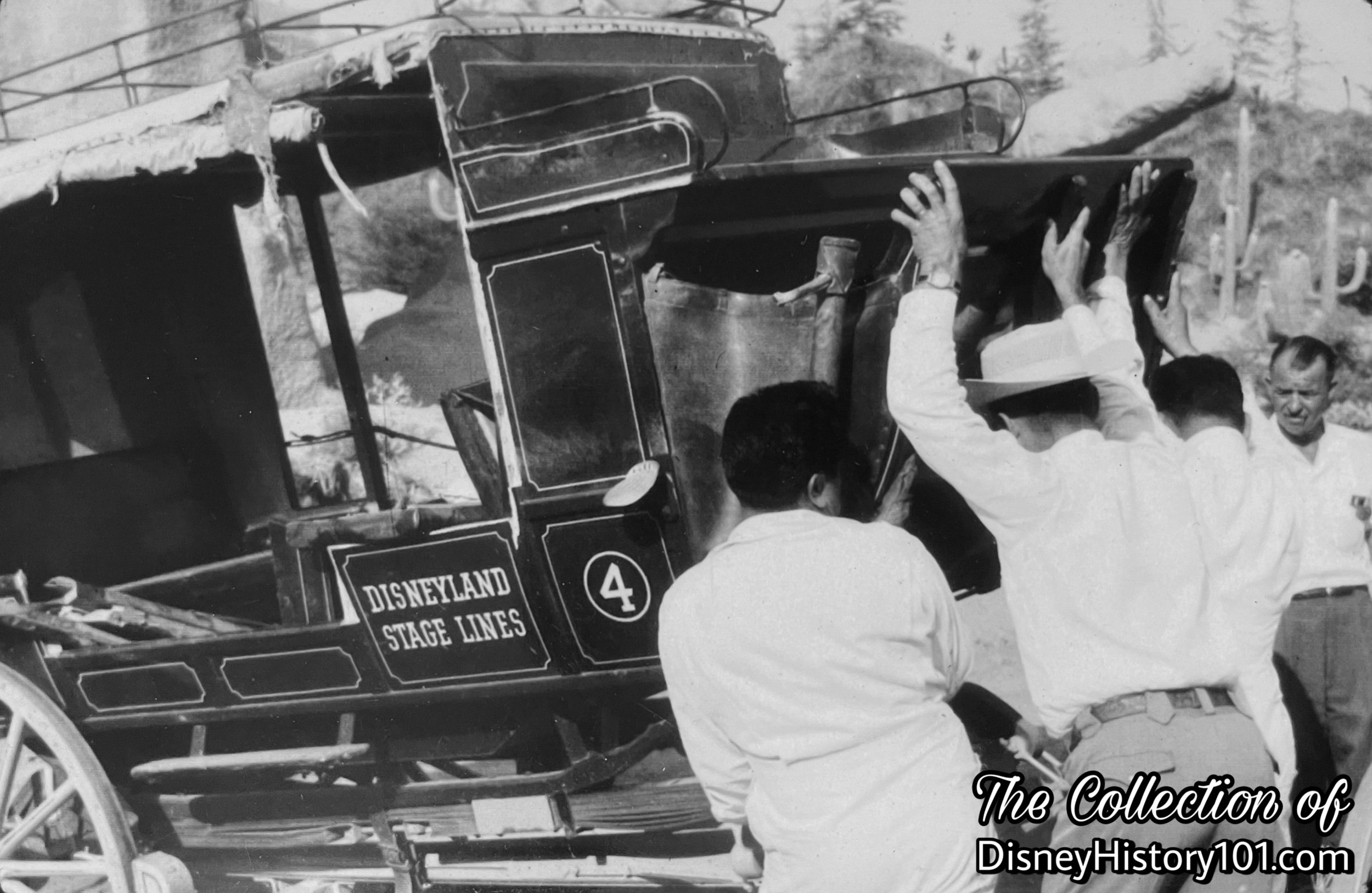
The wrecked Disneyland Stage Lines “Mud Wagon” Coach #4 goes “101.”
A few months later, another article (by Bob Thomas of the Associated Press) divulged Walt’s thoughts over what had occurred. “‘We had stagecoaches riding through the Painted Desert area’, he explained. And we had a few minor accidents on them. Nothing serious, but enough to worry me. We have a fine safety record at the Park, and I wanted to keep it that way. So I redid the desert to do away with the stagecoaches.”
This decision may not have been easy for Walt. Years later (in 1973) an interview with Joe Fowler perhaps revealed Walt’s feelings over the stagecoaches going “101”: “You know, I could go on for hours with the great understanding that man had and the things he loved and the way that he recognized that he had to make compromises. One of the things he loved, I guess, more than anything else was the stagecoaches that we had, the six horses in Frontierland. Well, we had three accidents. The damn thing was top-heavy where we'd put the people on top of the coach as well as inside. Of course, a horse is the one thing that, as Owen Pope will tell you, you can't predict. He may go along three hundred days and then suddenly bang! He shies at some damn thing. And it was a problem with these horses. We'd had three accidents and fortunately no injuries, but there might have been people killed. I went to Walt and I said, ‘Walt, I'm sorry but we just have to take the people off the top of the stagecoaches or we’re going to have an accident. We've had three near ones!’ Walt said, ‘Oh, Joe, if we don't have the people on top of the coaches, it's no show. Besides the damn horses are gettin’ their heads off. Let's discontinue it and have the mule ride,’ which we did. But I knew him well enough by that time to know what it cost him.”
It may as well be a “Safe ‘D’ Fact” that if an attraction at the Park proves to be dangerous, the problem is corrected or the attraction is eliminated. Dangerous attractions just aren’t “Good Show” as they do not support a positive Disney image. So, the stagecoaches would experience a “Show Failure” situation and go “101.” After three tip overs, Walt Disney got rid of the ride.
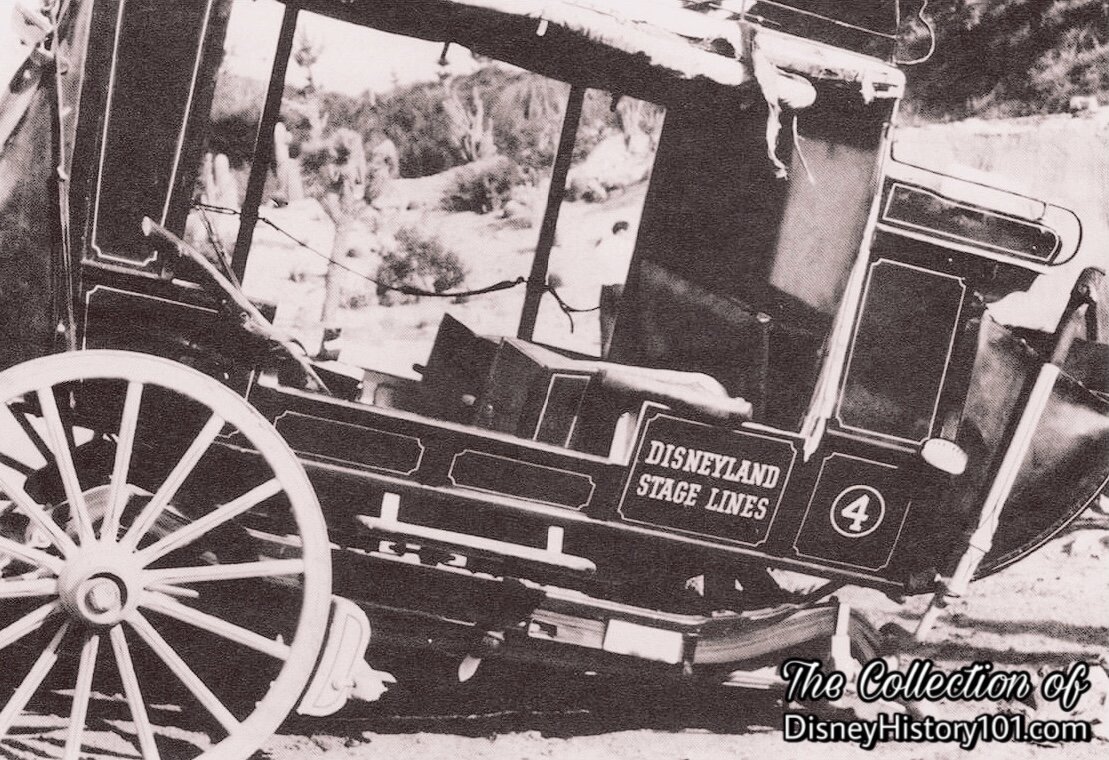
Wrecked Disneyland Stage Lines “Mud Wagon” Coach #4, as Seen in a Local Newspaper, July of 1959.
There wasn’t a “pioneer’s prayer” that could help Disneyland Stage Lines “Mud Wagon” Coach #4 ever go “102” again. However, not withstanding these incidents, one of the Rainbow Mountain Mud Wagon Coaches was still notably utilized to transport celebrity Richard Eastham (of “Tombstone Territory” fame) along the route of the “Disneyland ‘59” pageant and parade! But alas, the Conestoga Wagons would suddenly ceased operation on June 14, 1959, ahead of the Rainbow Mountain Mud Wagon Coaches. By the end of their run, a grand total of 560,646 guests had experienced dessert passage aboard a Conestoga Wagon. A few months later, the Rainbow Mountain Mud Wagon Coaches took their last excursion through the Rainbow Desert, before closing on September 13th, 1959. By this date, a grand total of 1,350,589 guests had the privilege of riding aboard one of Disneyland’s Concord Stagecoaches and Disneyland Stage Lines’ Mud Wagons!
While some publications (like the “Golden Magazine for Boys and Girls”, June of 1965) mistakenly still included photos of the stage coaches in descriptions of Frontierland within their pages, this was “the end of the trail” for the Conestoga Wagons, the Rainbow Mountain Mud Wagon Coaches, and their desert routes. However, it wasn’t the end of the Rainbow Desert territory. In fact, construction was now brewing, regarding a large refurbishment centered around one of two wonderful ways to explore Frontierland’s Rainbow Desert - the Rainbow Caverns Mine Train! But, that’s another story, for another time. (However, if you wish, you may STEP THIS WAY to explore the history of the Mine Train Thru Nature’s Wonderland.)
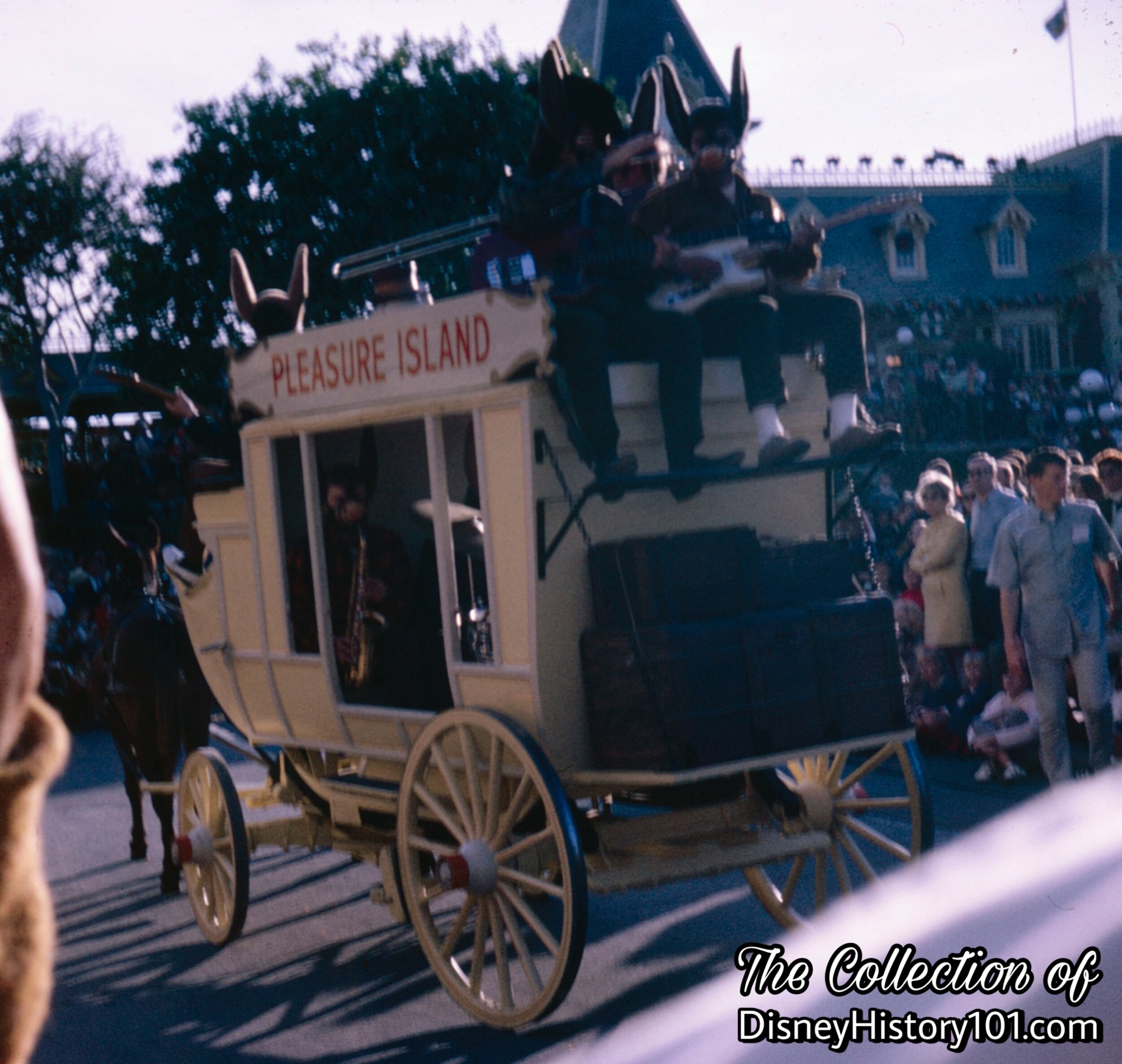
Disneyland Stage Lines Mud Wagon Repurposed for A Pleasure Island Parade Unit, (1969)
“Legacy”
Owen Pope regularly oversaw the acquisition and fabrication of equestrian-related parade vehicles (like the Scarecrow Band Hay Cart for Fantasy on Parade of 1965). In addition, through special arrangements, Owen’s pony teams often pulled some of the vehicles (like the Biggest Bass Drum).
Even some ten years later, one of the old Disneyland Stage Mud Wagon Coaches was repurposed (likely under Owen’s oversight and direction) as a parade vehicle for a Pleasure Island Unit of a seasonal winter holiday parade. This time, the equines also rode in the body, driver’s box and shotgun.
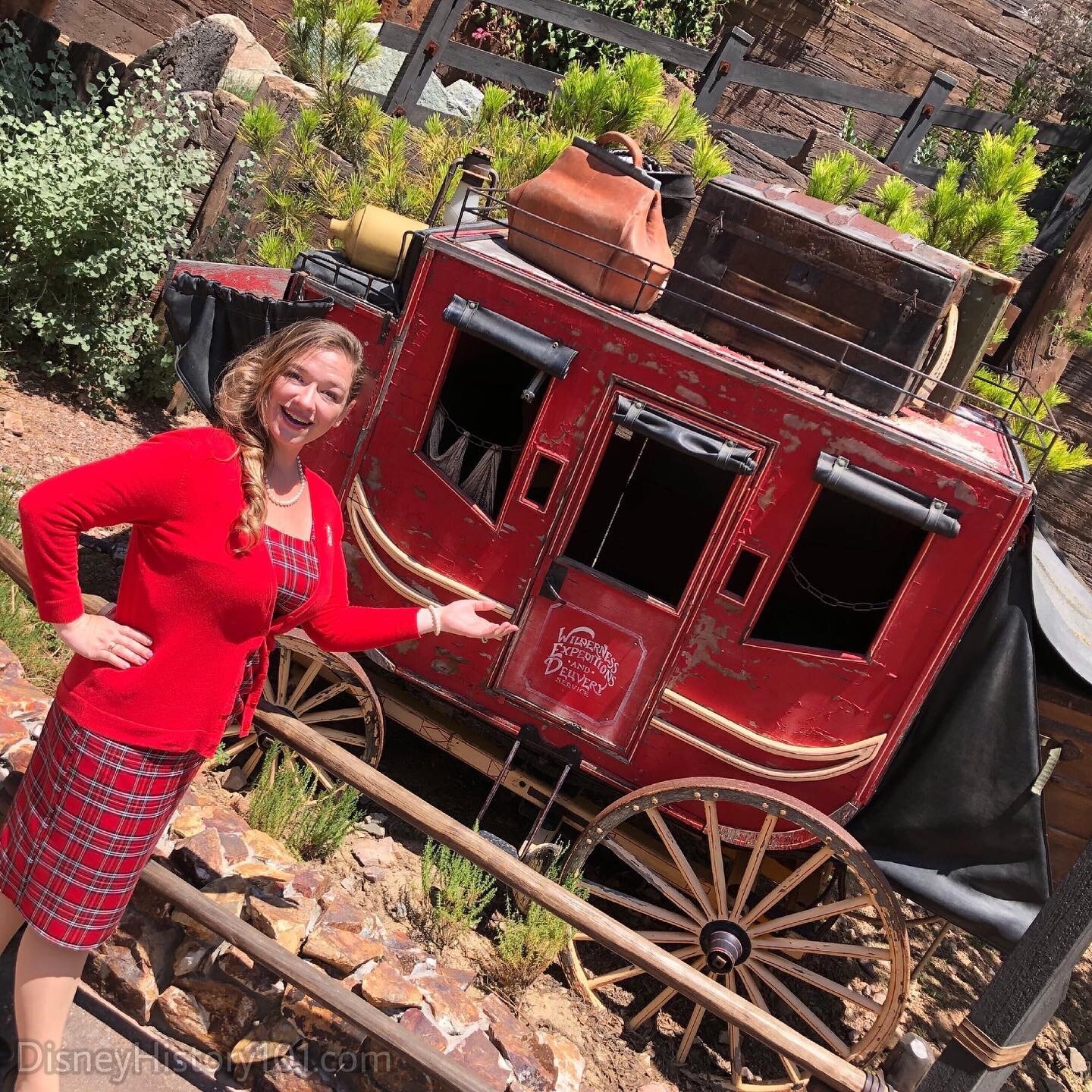
A Rainbow Ridge Stagecoach Homage near the periphery of Frontierland and Star Wars Galaxy’s Edge, c.2019.
In the present, Stagecoaches haven’t completely disappeared from Disneyland altogether. During the stages of “Project Stardust,” this stage coach came to sit alongside one of Frontierland’s main roads. It may look similar in style to the Stagecoaches that operated out of Rainbow Ridge (from 1955-1960). However, it is surely not one of them. There are numerous differences between the overall shapes of the bodies, the wheel hubs, railings, and overall cargo sections, to name a few differences. Rumors abound that this is one of the neighboring Knott’s Berry Farm’s stagecoaches, yet we are still in search of a source to validate this claim.
Still, this stagecoach carries several story references to Frontierland elements! First, the words “Wilderness Expeditions and Delivery” appear on the doors - an acronym that (when abbreviated) spells “WED.” Maybe you’ve also noticed the name of Tony Baxter’s original Big Thunder Mountain Railroad character Jason Chandler, referenced on a luggage tag on the back of the Wilderness Expeditions and Delivery Service Coach. According to legend, Jason Chandler was the founder of Discovery Bay.
If you would like to see (what are perhaps) two of the last surviving true-life Disneyland Stage Lines vehicles(including the Disneyland Stage Lines “California” Stage Coach, which was previously on exhibit at the Park during the Disneyland 50th Anniversary ; and Disneyland Stage Lines Mud Wagon No.6), you will need to be invited to visit the Circle D Ranch in Norco, California.
In Florida, Walt Disney World Stagecoach Ride carried the Frontier tradition at Fort Wilderness.

